Canon Lenses, Flash & Accessories
Contents
(Scroll down or click on Links)
Lens Mounts
Screw Thread Lens Mounts - Theory vs Practice
Collapsible Lenses
Nikkor Lenses
Serenar Lenses
Canon Lenses
Mirror Boxes
Viewfinders
Lens Hoods and Filters
Lens Caps and Other Caps
Lens Cases
For Unsynced Cameras
For Canon Rail Mount Cameras (bottom loading)
For Canon Bayonet Mount Cameras (hinged back)
Canon Speedlights for Rail and Bayonet Mount Cameras
For Canon 7s
Useful Flash Accessories for the Modern Photographer
Canon Meters
Ever-ready Cases
Canon Rapid Winder
Accessories Other
Seiki Rangefinder
Canon Enlarger
Seiki Albada Finder
Reloadable Film Magazines
Canon Camera Holder
Auto-Up
Self-timers
Copy Stands
Lenses Overview
Until the immediate post-War years, Canon cameras featured Nippon Kogaku made Nikkor lenses. Canon then produced a very complete range of lenses with many variations and updates over the rangefinder lifetime, including simply inscription changes. These were referred to as Canon's “S” lenses (“R” lenses were early, often similar, SLR lenses). In fact, whilst rangefinder camera production ceased in 1968, lens production continued until 1975. If you are a Canon lens collector or, want to know what lens matches which body, you'll need something like Peter Kitchingman's “Canon M39 Rangefinder Lenses 1939-1971” book with a lifetime of collecting and research behind it. The best on-line guide is the Canon Camera Museum, Lens Hall, S Lenses. It lists lenses chronologically but gives little detail and there are definitely some anomalies with contradictions from Canon's own manuals, brochures and catalogues. There are Canon lens brochures and guides from the early 1950s to the end of the 1960s available for download from https://pacificrimcamera.com/rl/rlCanonRF.htm. My look at lenses will be more from an historical perspective and much more broad brush. I have grouped them by name, then chronologically and focused mainly on standard lenses (5 cm/50 mm) with an even briefer look at accessory lenses at the end of each name group.
Lens Mounts
First there was the Kwanon prototypes with the Leitz Elmar-like KasyaPa lens. I haven't seen the lens mount specs mentioned by anyone so only Canon would know. It may be the Leica thread mount (LTM), which is somewhat expected, or M39, if Peter Dechert is correct that Seiki Kogaku (and presumably Goro Yoshida) didn't realise until after the War that the Leica mount wasn't metric, or something else. I've said it on my other pages and I'll say it again, LTM and M39 are not the same, LTM uses a Whitworth thread and M39 is metric. These are the production lens mounts:
Bayonet Mount
This is a hybrid mount used by the Hansa Canon, Canon S and its S derivatives until and including the post-War S I. It was designed by Eiichi Yamanaka, an employee of the Nippon Kogaku Design Division. According to research done by Hans Braakhuis, a patent, registration number 229211, was applied for on 27 June 1935. The main mount has the same 39 mm diameter and appearance as the Leica but with a pitch of 24 threads per inch (TPI) instead of 26 TPI. The Nippon Kogaku made Contax inspired focusing mount (but without external bayonet) is screwed into this and secured by a set screw. On the left is the screw mount, the lobe on its top right is for the rangefinder coupling pin, a unique design quite different to the Zeiss Contax. According to Hayato Ueyama, it does have some shortcomings, the accuracy is impacted by various twisting forces rather than the typically more linear loads of e.g. Leica types. On the right is the rear of the focusing mount shown upside down (half of the set screw hole can be seen in the bottom of each of the two parts):
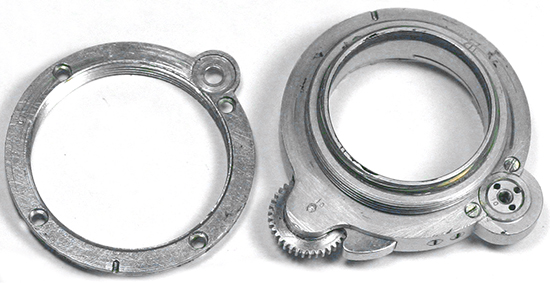 (Web image)
(Web image)
This example showing the front of the mount is from Camera Collectors' News, May 1982:
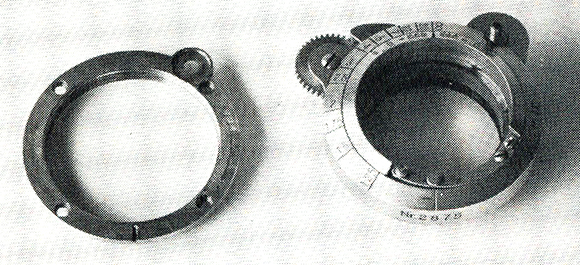
The lens barrel is inserted into the focusing mount using a bayonet fitting. The mount focusing helical is operated by the toothed wheel, the button next to it is the infinity lock. It proved to be a complicated and expensive system seen as necessary to avoid infringing Leica's patents around the transmission of focus information to the rangefinder. Each mount was numbered and early ones were engraved “No. (x)xx Nippon Kogaku Tokyo” (last in my database is 717), later ones (first in my database is 853, Peter Dechert knew of 804) are simply engraved with the number in the format “Nr. (x)xxx”, Nr. being the German abreviation. Hansa Canon with early mount on left, later mount on right:
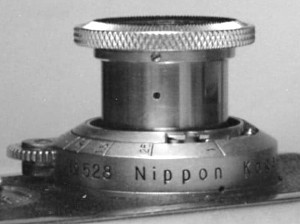

(Detail from larger web images)
Canon S mount on left, Nikkor 5 cm f/3.5 bayonet on right:
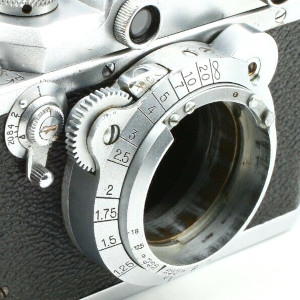

(Detail from larger web images)
According to Peter Dechert, a new bayonet insert was developed in 1940 with finer pitch for more accurate focusing with the f/2 lens. They can be told apart by the 1 metre index mark being at the 5 o'clock position whilst on the earlier mount it was at the 6 o'clock position. He thinks that both were made concurrently for the next two years during which time, the DoF scale at some point changed from the f/3.5 apertures to those of the f/2.
J Mount
The J mount (named that after the War) was used by the budget Canon J and its derivatives. It is simply the main 39 mm 24 TPI Hansa Canon/ Canon S mount (without rangefinder coupling lobe) into which the lenses, with their own helicoids, mounted directly in Leica fashion, but without a rangefinder, the Canon J avoided Leica's focusing patents.
Semi-universal Mount
Peter Dechert tells us that the 1946 Canon S II introduced a new mount referred to as “semi-universal” which was close to the Leica standard but would accept the earlier J mount lenses as well as most Leica lenses - to make it work, the threads were cut sloppier. Peter Dechert also claims that until 1947, Seiki Kogaku and Nippon Kogaku engineers believed that the Leica thread pitch was 1 mm (M39) without realising it was 0.977 mm (based on 26 TPI Whitworth). That raises a question in my mind - why then did Seiki Kogaku and Nippon Kogaku settle on a 24 TPI thread for the earlier hybrid/J mount instead of a more logical metric thread?
Canon itself does not acknowledge the “semi-universal” thread, it says this of the Canon S II; “the non-universal, threaded lens mount was identical to the Canon J’s”, i.e. a thread pitch of 24 TPI. Generally, that's definitely incorrect, as we shall see in the next section, although Peter Dechert does say that a few very early examples did use the J mount. Of the Canon II B, Canon says; “the lens mount was a universal, threaded flange compatible with Leica” whereas according to Peter Dechert, the universal thread didn't arrive until late 1951, see below.
There seems to be very little discussion of this anywhere, either the nuances of the semi-universal mount and the arrival time of the universal mount are ignored, or Peter Dechert's claims are accepted verbatim. My own tests, further below, below suggest that he is on the money regarding the Canon S II and its lenses but there are real doubts about a 1950 (January or February) Serenar 50 mm f/1.9 and 1950 Canon II B both of which behave more like universal thread mounts already.
Universal Mount
According to Peter Dechert, the fully Leica compatible lens mount with 26 TPI, in Canon terminology, “universal” mount, was introduced by the Canon III A and IV F in late 1951 and used for all subsequent models. The new Serenar 5 cm f/1.8 lens released for them also featured the new thread but given stocks of lenses in other aperture and focal length sizes, some may have not changed until renamed “Canon” or were discontinued first.
Note, my tests in respect to the semi-universal mount suggest that the Canon universal mount flange is more forgiving than the Leitz original.
Screw Thread Lens Mounts - Theory vs Practice
Thread Comparison: The metric and Whitworth thread pitch comparison of the three known mounts in question is as follows; LTM 0.977 mm (26 TPI), M39 1.000 mm (25.4 TPI) and J 1.058 mm (24 TPI). Semi-universal is presumed to be roughly halfway between LTM and J, i.e. 1.0175 mm (25 TPI), but it may not be, I haven't been able to find any actual specification. Below is a block graphic to help visualise the mount relationships:
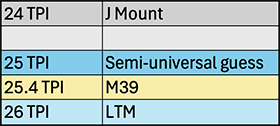
What Mounts on What: Unfortunately I don't have access to a J mount body, or lens, but this is what I tested. At the LTM end of the mount spectrum, I have a 1946 Leica IIIc body, at the other end I have a 1948 Canon S II (serial number 19269) with presumed semi-universal mount with some Canon bodies and a 1938 M39 Soviet Fed in between, all with lenses from similar periods to the bodies. Two of the Canon bodies are II Bs, the earliest from 1950, serial number 33603, with presumed semi-universal mount and the other from 1952, serial number 41005. By then, Canon had introduced it's universal mount and may have updated the II B mount as well, if it wasn't already one. In fact, Peter Dechert has said that some late ones may have the new mount. This table summarises the results and helps visualise the compatibility relationships:

Notes:
(1) Mounts OK but infinity tab catches external bayonet tab.
(2) Mounts OK but infinity tab catches rangefinder window.
(3) Mounts but cannot be collapsed (see next section).
The only body that wouldn't fully accept all the lenses was the Leica III. It wouldn't accept the Fed M39 lens, or the Canon S II era Serenar 5 cm f/3.5 (10054) and Serenar 13.5 cm f/4 (34209) lenses, not really surprising and more or less proving that Canon is wrong and the semi-universal thread is a real thing, at least for Canon S II lenses, and not a figment of Peter Dechert's imagination. Clearly, these lenses are different to LTM but as they mount on Canon's confirmed universal (LTM) mount bodies, they are also different to J mount by definition. Below is the 5 cm f/3.5 Serenar mounted on the Leica to the point that it starts binding:
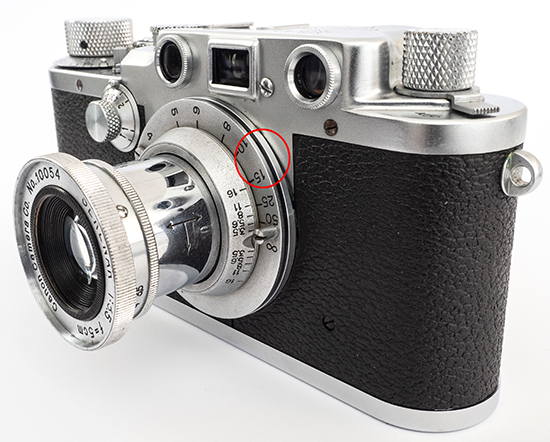
Two lenses that surprised were the Leitz Summitar 5 cm f/2 and Serenar 50 mm f/1.9 (serial number 31286 from January or February 1950) which both happily mounted on everything. The Summitar no doubt because of the intentionally “sloppy” cut threads (Peter Dechert's description) of Canon's semi-universal mount bodies and perhaps the intentional, or unintentional, looseness of the Fed thread. However, the more intriguing is the Serenar. If it is semi-universal like its earlier siblings, it shouldn't have mounted on the Leica III, it would be even less compatible than the M39 Fed which didn't mount. The lens threads are not worn, they are in excellent condition. To me, this behaviour suggests that it is in fact a universal mount lens.
If the early 1950 Serenar is universal mount, then you might expect all Canon II B flanges to be as well, not just late ones. Maybe, but it is possible that bodies and lenses are different, Canon was looking for maximum compatibility, not to invent a different mount. As we are seeing, LTM lenses work on semi-universal flanges. The only way to easily test the II B bodies would be with a J mount lens, which I don't have. If it mounted, they would be semi-universal, if not then they would be universal.
Collapsible Lenses
There are Canon, Nikon, Leitz and other makers' collapsible lenses that may be tempting to try out on later Canon bodies but do not attempt to collapse them. On Canon bodies with hinged backs, i.e. VT and later, the locking bayonets of the lens telescoping body tube (all are similar) will invariably come into contact with the body's internal baffles.
I have tested a Serenar 5 cm f/3.5, Serenar 5 cm f/1.9 and Leitz Summitar 5 cm f/2 on Canon L2 and 7 bodies. Both Serenars foul and won't fully collapse on either body, forcing would cause damage. The same applies to the Summitar on the L2 but on the 7, it will collapse if carefully aligned and jiggled - I did that with the back open and the shutter on “B”, not a viable option with film loaded.
Nikkor Lenses
The Nippon Kogaku made Nikkor 5 cm lenses were a standard fitment from the launch of the Hansa Canon until the Canon S II was released in 1946 and even then filled gaps in Seiki Kogaku's early production. No shorter or longer focal length Nikkor lenses were marketed in this period. There was a very good reason for this. During this time, Seiki Kogaku needed to adjust each mount to correct the back focus of its matching lens. The hole in the camera's back was used for determining the correct focus point and the mount shimmed accordingly. Change lens, even to one of the same type, the process would have to be repeated and then undone if changing back. So changing a lens was a major undertaking, you can think of the set supplied by the factory as being a semi-permanent coupling, even if the lens was simple to physically remove and replace.
Mythical Nikkor 35 mm f/3.5 Prototype
Peter Dechert claims that a single copy of an “experimental” 35 mm f/3.5 lens is known to have survived and is serial numbered 352 with a photo on page 29 of his book (story on page 33). He presumes that the first was 351 and therefore, there were at least two made. Mike Eckman has a different photo of what appears to be the same lens (ending in “2”) in his Hansa Canon review (I understand that this lens is held by the JCII Camera Museum, Tokyo). However, a Nikon Museum display (“Nikon Museum Special Collection 2”, 29 September 2020 to 30 January 2021) had its own copy of the lens, serial number 354 (identical in appearance) labelled:
“Nikkor 3.5 cm f/3.5 A lens developed for 35 mm format cameras that employed the Canon lens mount of that time. It was used in a device for recording numbers of telephone calls. 1937”
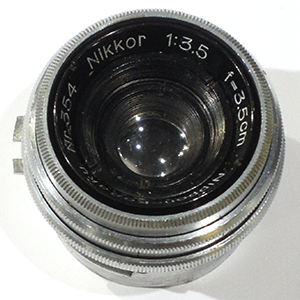
(From photo by Michio Akiyama on his Red Book Nikkor site, same page as the Regno-Nikkors)
Hayato Ueyama features number 352 in his book and essentially tells the same story as Nikon with a bit more background information.
My take on that is that it was not intended for commercial release and was developed in response to a government, or military, request. Tellingly, unlike the Nikkor below, there is no mention of prototype in the description. Peter Dechert's conclusion that it is from near the end of the War and is linked to Canon S number 12342, because of that camera's unusual finder with etched 50 mm frame inside a more expansive view, is almost certainly not correct (lens and camera not found together and no other known link).
Prototype 5 cm f/3.5 Nikkor
According to John Baird, author of “The Japanese Camera”, the Imperial Japanese Navy and the Mitsubishi group paid licensing fees for Zeiss lens designs and the Navy also assisted Nippon Kogaku with obtaining materials and equipment for producing optical glass in Japan. He adds that Nippon Kogaku employee and later Seiki Kogaku lens designer, Ryouzou (or Yoshizo, see Serenar Lenses below) Furukawa indicated that the first 5 cm f/3.5 Nikkor for the Hansa Canon was completed in December 1934 (Nippon Kogaku had been formed in 1917 and had begun designing camera lenses for the military in the late 1920s, see The Japanese Copymakers).
However, this maybe wasn't the Hansa Canon lens as we know it, this was perhaps a Leitz Elmar copy (but possibly a Tessar formula and optically the same as the Hansa Canon lens). Another Nikon Museum Special Collection 2 display is labelled:
“Nikkor 50 mm f/3.5 (prototype) A normal lens with a Leica screw mount. Due to its exterior design and red housing box, it is assumed that this lens was modelled after Leica products. Mr Kakuya Sunayama, the manager of the Design Division at the time, designed this model and manufactured only 10 units. This is one of them. This model was the first normal lens for 35 mm format cameras manufactured by Nikon (then Nippon Kogaku). 1934”
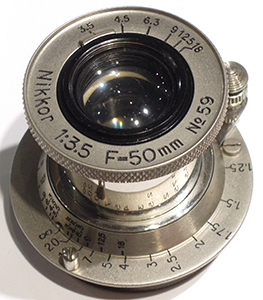
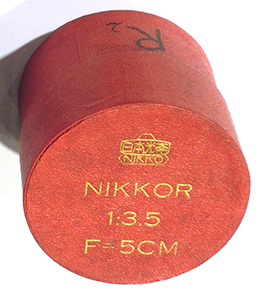
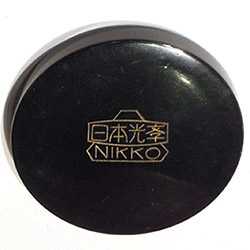
(From photos by Michio Akiyama on his Red Book Nikkor site)
The serial number suggests that it is the ninth of ten lenses. Kakuya Sunayama is known to be the designer of the new Nikkor for the bayonet mount Canon and that this was reputed to be the first 5 cm camera lens made by Nippon Kogaku. The Leica-like red box and a lens cap of this Leica mount version make it seem more like a presentation item than a prototype, but it doesn't mean that all 10 were “packaged” this way, or even that the 10 lenses were all one batch. Or, perhaps they were. There are two possible stories and maybe elements of both are correct.
The first is based on known events. To put the timeline into perspective, the Kwanon A prototype was advertised in June 1934 and the Kwanon C in September 1934. Both (and also the Kwanon B) featured the KasyaPa lens, presumed to be Leica mount. Also in 1934, two events caused a rethink of the basic Kwanon design, one was Leitz patenting its lens mount and elements of its coupled rangefinder design and the other was the Kodak prepackaged disposable film cassette. It would be over another 12 months that the Hansa Canon, as we know it, was announced in October 1935. Initially there would have been considerable head scratching over possible solutions, searches for alternatives and internal bickering leading to Goro Yoshida's departure when Nippon Kogaku was approached. Yet it seems that Nippon Kogaku delivered the first prototype of a new 35 mm lens design (for Nippon Kogaku) by December 1934. That's why I think that Furukawa also was talking about the Leica mount version of the Nikkor rather than the actual Hansa Canon bayonet mount black face Nikkor.
Unfortunately, the machine translation of this part of Hayato Ueyama's book is very difficult to follow but there is a clear quote from Eiichi Yamanaka, who was responsible for producing the “rangefinder interlocking unit” at Nippon Kogaku, in which he says it took about eight months to complete the prototype. In other words, initially, there would have been no mount available for lens testing. Also, I'm only guessing, but the Leica mount perhaps made comparative optical testing easier, according to Ueyama, at least two Leitz Elmars were disassembled for measuring and testing purposes.
Hayato Ueyama also says that in April 1935, 10 lenses were made with different lens thicknesses and air gaps for more comparative testing. It is possible that the lens on display at the Nikon Museum is the ninth one of these, assuming that earlier prototypes were unnumbered. If they were numbered, it's still possibly one of these but might be, e.g. the third. The 1934 date quoted by the Museum may be the date of the first prototype rather than this batch, much of Nippon Kogaku history was lost with the War.
The second story is provided courtesy of Hans Braakhuis in the PDF booklet, “The History of Nippon Kogaku 1600 - 1949” (I had problems with his website but there are other websites and an earlier version on the Nikon Club site). Braakhuis says, quoting from “The Nikon Story” by T. Arakawa:
“Sunayama must have been eager to give full support to the realisation of the first Japanese 35 millimeter camera, which Seiki Kogaku was about to perfect. Sunayama had been pouring his passion into developing lenses for 35 millimeter cameras. The Nippon Kogaku lens that had no prospect of selling, finally found a marketing channel.”
This comment followed the description of the 1934 meeting between Saburo Uchida and Maeda Takeo of Seiki Kogaku and representatives of Nippon Kogaku with at least as much detail as I have seen anywhere. It is conceivable that Sunayama may have produced the 10 Leica mount lenses some time earlier as part of his passion and maybe that explains the Leica like presentation box. However, personally, I think that Hayato Ueyama's description of the difficulties in refining the design for the Hansa Canon casts doubt on Sunayama producing an earlier batch of ten and if he had been thinking of such a lens, it was likely to be limited to drawings and calculations. But I might be wrong.
5 cm f/3.5 Nikkor
In different forms, the collapsible f/3.5 Tessar design remained the general purpose option throughout the Nippon Kogaku era. The first production version with its white on black lettering and aperture ring on the front had what is now called a “black face” and usually, was marked 50 mm and not serial numbered:
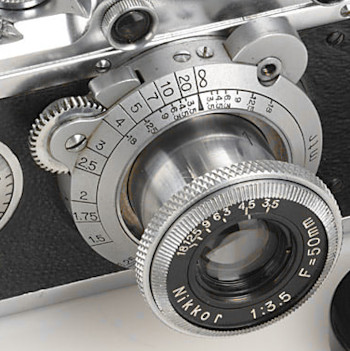 (Web image)
(Web image)
At about the time that the Nippon Kogaku name was removed from the lens mount, the black face lens was replaced by a similar design 5 cm “white face” lens with serial numbers, both lenses featuring front set apertures:
 (Web image)
(Web image)
Note, there was a short transition period and below is a late black face lens with a serial number and marked in centimetres (cm) and an early white face without serial numbers and marked in millimetres still (Hayato Ueyama suggests that there may have been the odd earlier white face as Nippon Kogaku were trying different things).
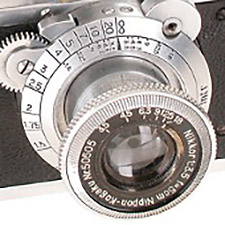
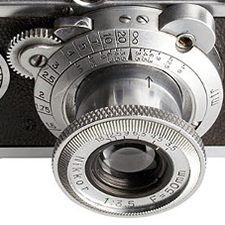 (Web images)
(Web images)
There are only two of the black face lenses with serial numbers and cm markings in my database; 50505 and and 50513 fitted to mount numbers 717 and 712 respectively.
Not surprisingly, given Nippon Kogaku's licensed access to Zeiss lens designs and adoption of the Zeiss Contax style focusing mount, both the front set black face and white face lenses are similar in appearance and function to the black face and white face Zeiss 5 cm f/3.5 and f/2.8 Tessars fitted to the Contax I.
Author John Baird (see above) tells us that Furukawa checked the performance of the early production Nikkor against the Leitz Elmar and found the Nikkor to be inferior. With improvements to the optical glass, this was apparently rectified in May 1937 and “it is suggested” that this coincided with the change from black face to white face. Hayato Ueyama says that the new version was launched, presumably marketed, in July 1937.
Early lenses were nickel plated, later ones chrome. Peter Dechert says from serial number 50540 onward, which also must be about the beginning of the white face lenses.
With the release of the Canon S, the Nikkor f/3.5 was updated with outer aperture ring viewable from above, almost certainly influenced by the 5 cm f/2 Leitz Summar design. This is the bayonet version for the focusing mount but it was also available in J mount and Nikon tells us that production of an LTM version was “recommended” in December 1945 so probably first appearing in early 1946 (Nikkor f/3.5 lenses fitted to early Canon S II cameras could be either J or LTM mount):
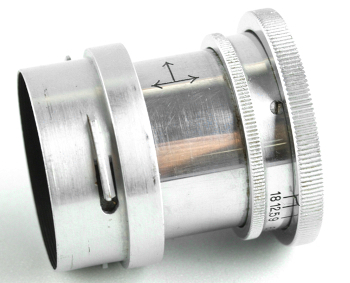
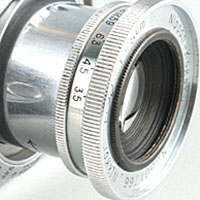 (Web images)
(Web images)
The smallest aperture of all versions was f/18 until near the end of the War when it changed to f/16. Nippon Kogaku introduced lens coating for the 5 cm f/3.5 in April 1946. Coated lens are marked “QC”, the “Q” standing for quattro, i.e. four elements, and the “C” standing for coated. Slip-on lens cap size for the black and white face lenses was 38 mm and for the later lens, 36 mm.
5 cm f/2.8 & f/4.5 Nikkors
Released in early 1938 along with the f/2 below, these were are both collapsible type lenses with front set apertures like the whiteface f/3.5. They were actually developed as black faced prototypes in “around” (Nikon's description) 1937 and 1938 respectively with photos on Michio Akiyama's Red Book Nikkor site (same page as Sunayama Nikkor 5 cm f/3.5). Whilst small numbers of the f/4.5 were made in bayonet mount, it was intended as the standard lens for the Canon J. The f/2.8 lens was only made in bayonet mount and is a fairly uncommon lens. Both ceased production early in the War:
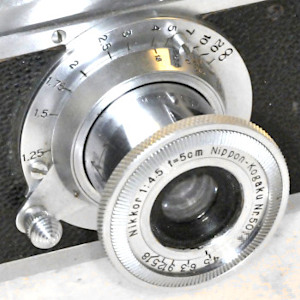
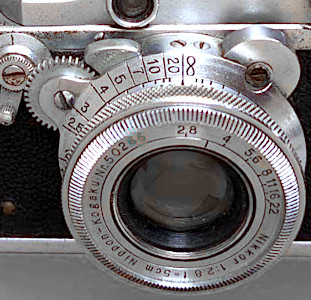
(Web images)
The slip-on lens cap size of the f/4.5 lens is 38 mm, same as the f/3.5.
5 cm f/2 Nikkor
The f/2 Nikkor is a 6 element Zeiss Sonnar design. Unlike the previous lenses which used Japanese optical glass, author John Baird claims that special Schott barium glass was imported from Germany. Peter Dechert tells us that there are three versions. The first type was short-lived and has stops down to f/22 which Peter Dechert calls “internally set”, more commonly called “front set” (note the low 4 digit serial number, the last 2 digits are the number made so far):

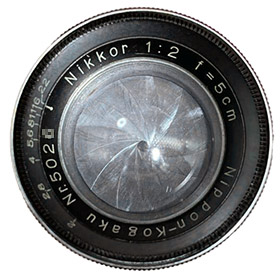 (Web images)
(Web images)
The second and most common type has an external aperture ring and a minimum aperture of f/16:
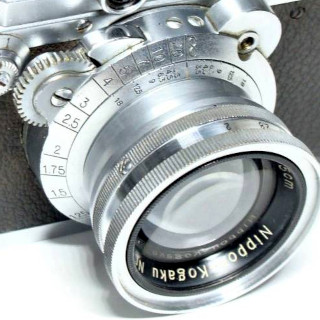 (Web image)
(Web image)
Additionally, there is also the f/2 Regno-Nikkor which has a minimum aperture of f/11 instead of the f/16 of the Nikkor and Peter Dechert says has a simplified rear elements group resulting in a lens with only “4 or 5 elements”. It was originally intended for use with X-Ray cameras but due to War-time shortages, some were fitted to the Canon S bayonet mount barrels. Early examples feature typical Nikkor serial numbers but later ones have their own series in the format 14xxxxA. Uncommon but not a rarity either. Note the f/11 minimum aperture:
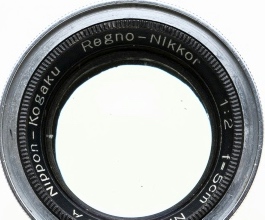
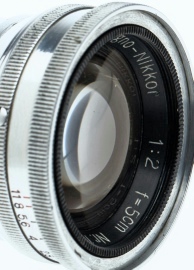
(Detail from larger web images)
I don't know what the
Nikkor Serial Numbers
As noted further above, the earliest Nikkor f/3.5 lenses were not serial numbered and when numbering started, there was a transition period with examples of the very last of the black face lenses which are numbered and of the very first of the white face lenses which are not.
Until 1944, all the serial numbered Nikkor 5 cm lenses (but not most Regno-Nikkors) were prefixed “50” signifying the focal length in millimetres. They also used the German abbreviation for number, “Nr.” Starting in 1944, a new numbering system was introduced which is claimed to be date coded with the first digit signifying the year of the decade and the second signifying the month. Lenses were generally made in batches, with the small number of cameras being made at that time, there might only be one batch of lenses in the year. My database contains “46”, “57” and “610” numbers; 1944 June, 1945 July and 1946 October, respectively, the same pattern as in Peter Dechert's book. The last in the series of lenses used by Canon introduced a three digit prefix with a two digit month code, “705” (1947 May). Date coded Nikkors use the “No.” abbreviation.
In my Canon S II database, there is a mix of f/3.5 Nikkors and Serenars, but probably slightly more Nikkors, until camera 1618x after which there is only Nikkor 70566x attached to camera 1873x.
There is a little bit of a mystery, or at least confusion in my mind, regarding the post 1945 lenses. In my databases are five Nikkor 5 cm f/3.5 lenses with similar serial numbers ranging from 57044x to 57110x (57044x, 57075x, 57079x, 57101x and 57110x). Two were found on early Canon S II examples, first released in October 1946. These could be either J mount (a small number of early cameras), or LTM, but one is claimed to be J mount. Three were found mounted to Nippon cameras (rebranded Nicca later) with 1944 serial numbers. These were unlikely to be original fitments, only K.O.L., or post-War re-branded Sun, Xebec f/2 lenses were known to be supplied with the “Nippon” bodies. The mystery with the lenses is that the Nippon Kogaku date code theory suggests that “57” lenses were made in July 1945 but the four later ones are marked “QC”, the “C” meaning that they have a coated lens which only started in April 1946 and at least the three mounted on the Nippons are LTM which was only decided on in December 1945 and likely first made in 1946. The four are also marked with “Tokyo”. The earliest lens of the group has neither the Q.C nor Tokyo markings but it was found on a Nippon meaning that it is almost certainly LTM. A slightly earlier “57” lens, also without the markings, 57041x, is mounted on a Canon J II in my database making it the only one which likely matches its age. The serial numbers of all 5, plus J II lens, only span 70 lenses, or so. The thinking among some, including Peter Kitchingman, is that the origin of the lenses is indeed from July 1945 but that they were only completed later as needed. At this stage, Seiki Kogaku was Nippon Kogaku's only known customer for 50 mm standard lenses and Seiki Kogaku's camera production volume was very low in 1945 and 1946 and in any case, it was beginning to produce its own Serenars.
Serenar Lenses
The “Serenar” name was trademarked by Seiki Kogaku in December 1941. According to Canon, the name was proposed by an employee in an internal competition and comes from the word “serene”, the actual inspiration being the “Sea of Serenity”, a feature on the Moon.
The first Serenars were produced for the Japanese military. Whilst Peter Dechert doubts that Seiki Kogaku had a lens making capability until its acquisition of Yamato (he calls it Daiwa) Kogaku Seisakusho in 1944 and that it's early lenses were made by some other maker, probably Nippon Kogaku, Peter Kitchingman and Hayato Ueyama tell us that in 1939, Seiki Kogaku purchased two lens generators, a number of polishing machines and a lens checking tool. Ryouzou Furukawa (Canon Camera Museum calls him Yoshizo Furukawa which may be a more accurate translation), a young lens making technician and budding lens designer who had worked under the Design Division manager, Kakuya Sunayama, designer of the 50 mm f/3.5 Nikkor, was also transferred from Nippon Kogaku to Seiki Kogaku and a supply of optical glass is also recorded. Some other workers were transferred as well but according to Ueyama, the lens team was only “5 or 6 people” initially but later two experienced female calculators were added to assist Furukawa with design. Therefore it is reasonably safe to assume that Seiki Kogaku was responsible for the first Serenars as well. Canon links Furukawa to trial lenses such as a 50 mm f/4.5 and a 45 mm f/0.85 for 16mm cine cameras and “involvement” in developing the R-Serenar 50 mm f/1.5 lens for the Canon X-Ray camera, Serenar 50 mm f/3.5 and non-rangefinder coupled 135 mm f/4.
Early Serenar Lenses
The best known is the 6 elements in 4 groups 5 cm f/1.5 lens originally made for the 35 mm X-Ray camera from 1943 to 1946 (Peter Kitchingman). This featured a special barrel and no diaphragm, the lens being identified by the name “R-Serenar”. However, according to Hayato Ueyama, this was preceded by a similar Zeiss Gauss-type Biotar derived 5 cm (initially 4 cm) f/2 lens for the X-Ray camera from which the f/1.5 lens was developed some 6 months later (I don't believe any are known to have survived). Peter Dechert also mentions examples of the f/1.5 lens rehoused in J mount focusing barrels with diaphragms found with Canon JS bodies and he presumes used as copy cameras. According to Dechert, there were both uncoupled and coupled types (for use on Leica or Nippon, i.e. pre-Nicca, bodies?). Most were renamed “Serenar” but not all (Peter Kitchingman). Hayato Ueyama had heard that these were designed for reconnaissance aircraft but has seen actual evidence of them being used for oscilloscope photography. He adds that the designer of this version of the f/1.5 Serenar was Teiji Hashimoto and that drawings were prepared in April 1943. He also offers an interesting insight by Ryouzou Furukawa:
“For X-ray use, we increased the aperture from f/2 to f/1.5 as requested, but at the most, it is only f/1.6. At f/1.5, due to spherical aberration, the image becomes extremely large, and the image in the centre is particularly poor. Comparing it to something like Sonnar for general photography is outrageous and unimaginable.”
Below left is a typical example of an R-Serenar 5 cm f/1.5, on the right is an example that has been rehoused in a focusing barrel complete with aperture diaphragm, this one has retained its R-Serenar name:

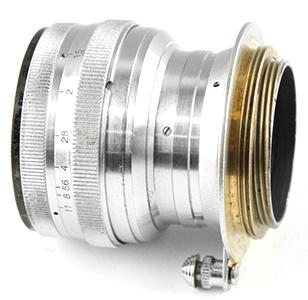
(Web images)
Peter Kitchingman mentions two other early lenses. The first is a 75 mm f/4.5 lens fitted to a fingerprint camera made for the military in 1940, or 1941, which predated the Serenar name and he also links to Furukawa. The second is a limited batch of 5 cm f/3.5 Serenar enlarging lenses made in 1945 to replace the “Hermes” branded lens made for Seiki Kogaku by Nippon Kogaku. Peter Kitchingman considers this to be the first Seiki Kogaku made Serenar commercial lens. Seiki Kogaku/Canon then promoted the standard collapsible 5 cm f/3.5 lens as being ideal for enlarging and copying purposes until 1955 when a specialist enlarging lens was reintroduced.
The Canon Camera Museum site says that “trial production” of a 13.5 cm f/4 Serenar lens began in 1941, although not released until after the War. According to Hayato Ueyama, the first prototype was made in late 1940. This is another of Ryouzou Furukawa's designs and is based on the Carl Zeiss Sonnar 13.5 cm f/4. It was not rangefinder coupled and Ueyama explains that it was difficult to focus with the focusing wheel as unlike the Contax, the Nippon Kogaku mount didn't use an external bayonet for longer lenses. Optically though it is reputed to have performed well.
Ueyama says that he is aware of at least two prototype lenses, 4030 and 4032, with 4030 pictured in his book mounted to a Canon S. He says that it is identical to the design drawings prepared by Shizuo Umezawa in January 1942. However, Peter Kitchingman believes that these serial numbers belong to the first batch of production lenses in March 1947. He mentions two 1944 prototypes as the earliest 13.5 cm lenses and cites Dechert as the source (Dechert says that these lenses were “reported” and he guesses that they were made in the Daiwa factory). I have to say that early Seiki Kogaku lens making history is one area where Peter Dechert missed the boat. Kitchingman's information is usually second to none but surprisingly, he also doesn't appear to be aware of Canon's, or Ueyama's, claims either. Nevertheless, we don't know if 4030 and 4032 are prototypes, or early 1947 production if there was no change from the original drawings.
This one might be a similar story. First the background. Believed by Peters Dechert and Kitchingman to be the first “production” accessory lens is a very short-lived, very limited production, uncoupled 20 cm f/4 Serenar with only one known surviving example and no official information about it. It was discovered in the USA. It incorporates a revolving tripod mount to enable portrait orientation shots. The lens, its hood and a red filter were found with a leather covered, silk lined timber box, Dechert describing the set as a “de luxe item”. It is currently on display at the Japan Camera Inspection Institute (JCII) Museum in Tokyo. It is also featured in the books by Hayato Ueyama, Peter Dechert and Peter Kitchingman. The serial number, 4015, suggests that at least 15 could have been made.
Dechert estimates that it was made in early or mid-1947. He says that it is coated and seems to have a semi-universal mount, but notes that it won't fully mount on Canon Js whilst it has no problems with Leicas. To me, that seems to be the antithesis of the behaviour of the semi-universal mount and my own experience with my early Serenar 5 cm f/3.5 which would not mount properly on my Leica (see the Lens Mounts section above) and I would have thought that the behaviour was more like that of a Leica thread mount lens. I note that he had very brief access to the lens just before going to print and perhaps semi-universal is what he expected to find? Kitchingman thinks that production was earlier, between September and October 1946. With the odd mount behaviour on the J, I'm left wondering if it was really intended for the nascent S II, or it was intended for Leica cameras for some limited run purpose?
That's what I first wrote before reading Hayato Ueyama's book. He says that the drawings were prepared in March 1942 by Shizuo Umezawa. Teiji Hashimoto, who was in charge of the prototype development, is claimed to have declared, “the mount is a Leica screw type”. Ueyama thinks that it may have been made for a military Leica or Nippon (later Nicca) camera. He adds:
“Before leaving Seiki Kogaku in February 1943, Ryouzou Furukawa explained this prototype lens to his military personnel. It's bright. He says he remembers making two or three of them.”
Note, Ryouzou Furukawa returned to Seiki Kogaku after the War.
These are two of the four photos from Ueyama's book, the left image showing the lens mounted on later Canon S II, serial number 16251:

Personally, I'm more inclined towards Ueyama's story which seems to rely more on facts and first hand quotes. Also, a military purpose seems more likely than a limited run luxury item in 1946, or early 1947, when Seiki Kogaku and the Japanese economy were still struggling to get going and the full Japanese text inside the box (Seiki Kogaku company name in full) suggests it wasn't intended for occupation forces. If Dechert is correct about the lens being coated, it may have been coated later in life. Note, whilst lens coating was introduced on the 5 cm f/3.5 Serenar in October 1946, it didn't feature on the 13.5 cm f/4 lens until December 1947.
5 cm f/3.5 Serenar
The collapsible Serenar f/3.5 is a 4 elements in 3 groups Tessar design and a close copy of its Nikkor predecessor. It was Seiki Kogaku's first standard lens made specifically for its cameras. According to Hayato Ueyama, this lens had been planned since Furukawa's transfer in 1939 but was deferred because of the unavailability of German Schott glass, or a suitable alternative. Peter Kitchingman believes that production likely started in December 1945. As it was not until October 1946 that the Canon S II would be released, initial production was for the Canon J II but apparently the lens was already rangefinder coupled. Peter Kitchingman records 8 variations of this lens until its demise in 1955. These include lens coating from October 1946, changing the maker name on the ID ring from “Seiki-Kogaku” to “Canon Camera Co.” in October 1947, reducing the number of aperture blades from 12 to 8, adding click stops and a filter thread (34 mm) in December 1951 and renaming the lens from “Serenar” to “Canon Lens” in December 1952 (presumably adopting the universal lens mount). All Serenar f/3.5 lenses fitted to the Canon S II (and J II) were marked in centimetres and Canon II B and later lenses (except the export exception noted below) were marked in millimetres. Lens cap size is 36 mm (slip-on) on all types (earlier domed style found on at least up to and including Type 3 lenses).
Of the 8 variations, the first 6 are Serenar and the last 2 are Canon Lens versions. Below left is an uncoated Type 2 lens with both “Seiki Kogaku” and “Serenar” in lower case (Type 1 is the same except the DoF scale is marked from f/4.5 to f/18) and on the right, a coated Type 3 lens with both names in upper case:


(Web images)
These are 3 photos of a Type 4 5 cm f/3.5 lens from perhaps early 1948 (by serial number), the first type with “Canon Camera Co.” maker name, the last main type with centimetre markings and the most numerous Canon S II version:
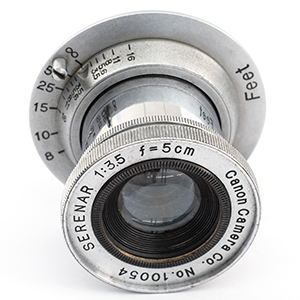
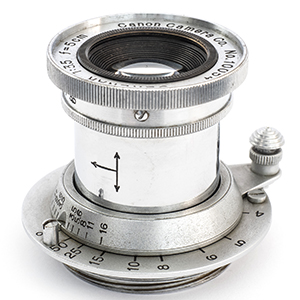
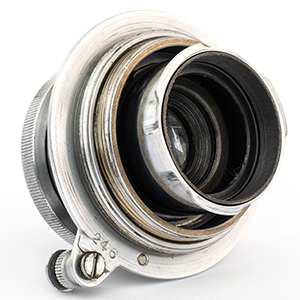
The Type 5 lens arrived with the Canon II B and introduced millimetre markings instead of centimetre. Below is the last Serenar version, Type 6, which arrived in December 1951, with “Japan” added to the maker name, 8 aperture blades instead of 12 and an increase in aperture ring diameter and overall weight by 11g to 140g (Peter Kitchingman notes that at the time of writing his book, he had recorded only 23 Serenar named versions of this type, before the change to “Canon Lens” with Type 7):
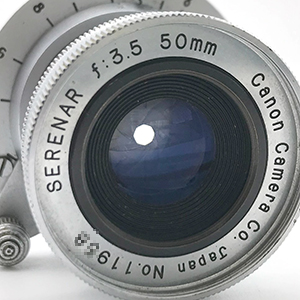
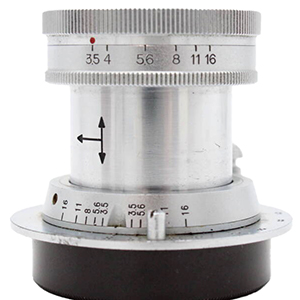
(Web images)
Serial numbers with this lens are more than a little mixed up and confusing, but Peter Kitchingman's book makes sense of it. Type 1 lenses are presumed to start at 8001 (8011 earliest found) and rise to 13722 at the end of Type 4 with the Canon S II still the current model. Then there is a sizeable batch of around 600 Type 4 lenses with a unique serial number range, from about 83022 to 83616, which he calls Type 4a and believes were fitted to export cameras other than to USA and include late S II to IV-Sb and even II-S2 models. Considering the Serenar name and focal length marking in centimetres, they would have been unusual inclusions on the later cameras. This is example, 832xx, fitted to a Canon S II:
 (Web image)
(Web image)
Peter Kitchingman has recorded Type 5 serial numbers from 13738 to 15034, basically continuing on from the end of Type 4, which makes sense. However, Type 6 lenses feature a serial number range from 10001 (presumed, 10114 found) to 15290, bizarrely, the serial numbers span the range of Type 4 to Type 5 lens serial numbers, i.e., 1951-1952 lenses using presumably unused numbers from 1947 to 1951. The Type 6 lens pictured above has serial number 119xx, but this earlier Type 4, from perhaps late 1948, has serial number 130xx.
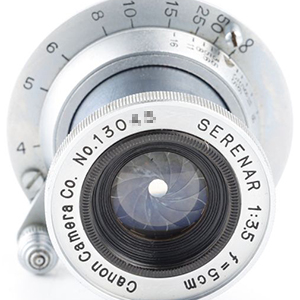 (Web image)
(Web image)
5 cm f/2 Serenar
The collapsible Serenar f/2 is a Double Gauss design with 6 elements in 4 groups with 13 aperture blades and not related to the Sonnar design of the Nikkor f/2. The physical barrel design looks surprisingly similar to the Leitz Summitar, another Double Gauss lens but that has 7 elements in 4 groups (the earlier Summar is optically similar to the Serenar), fewer aperture blades (10 reducing later to 6) and an odd filter thread design. The Serenar, like the Summitar and most lenses of that era, doesn't feature click stops. Filter thread is 40 mm and lens cap size 42 mm. It was released in February 1947 as an option for the Canon S II and had a short life until 1949.
Peter Kitchingman identifies 4 types, the first two totalling some 230 to 240 with the Type 2 simply reflecting the maker name change from “Seiki-Kogaku” to “Canon Camera Co.” in October 1947 (only one found at time of publication). These lenses featured an aperture range marked down to f/11 but a DoF range marked from f/2 to f/16. Type 3 lenses (totalling up to 322) featured both a minimum aperture of f/16 and a DoF scale marked accordingly and the elements were coated for the first time. With the Type 4 in April 1949 (the largest number, up to 1,360), the minimum aperture changed back to f/11 with matching DoF scale.
Peter Kitchingman tells us that the lens numbers started at 20001 and that the earliest found lens identified until writing his book in 2008 was 20008. Below left is lens number 20003, on the right is a type 4 example (the lower case name changed to upper case with Type 2):
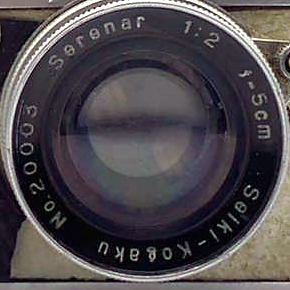
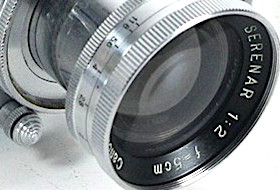
(Web images)
The locking bayonets and barrel design are a little different to the following f/1.9 version with the separate bare brass bayonet flange being considerably wider and bayonets much thicker on the f/2:
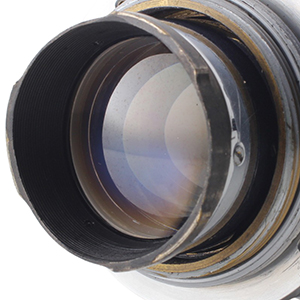
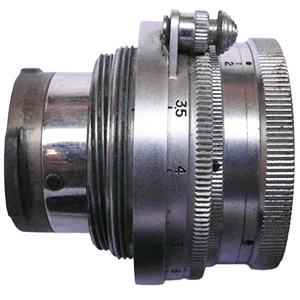
(Web images)
50 mm f/1.9 Serenar
The Serenar f/1.9 was introduced in April 1949 as the standard lens for the Canon II B and is a recomputed version of the previous Serenar f/2 with the minimum aperture remaining f/11 but the number of aperture blades increasing from 13 to 15. Another change was that the aperture opened up in the opposite direction - with the f/2, the “2” position was on the photographer's right, with the f/1.9, the “1.9” position was on the photographer's left. The filter thread remained 40 mm (lens cap 42 mm). As with the other early lenses, it did not feature click stops. The barrel locking bayonets were redesigned to be much narrower than the f/2 predecessor and the flange and barrel were initially machined from a single piece of brass. This again reverted to a two piece design with Peter Kitchingman's Type 3, as in the image below - note, the finer bayonets than the f/2, now chromed, with a narrower flange only a few millimetres wide (first image is larger version of the following one):
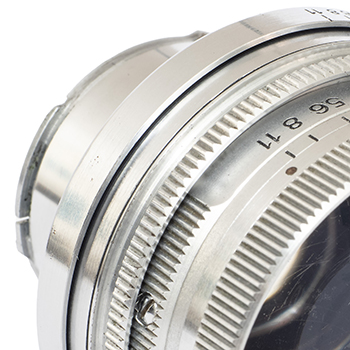
Note, with the Serenar f/1.9 release, Canon changed from centimetre markings (“cm”) on all its lenses to millimetres (“mm”), except for remaining f/2 production. Below is an early Type 3 from probably January, or February, 1950:
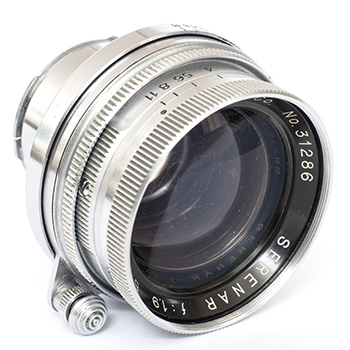
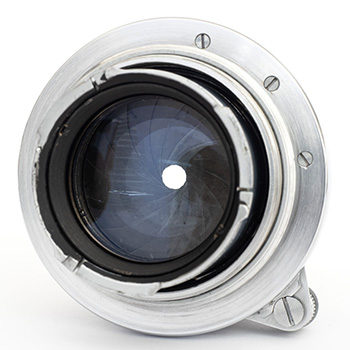
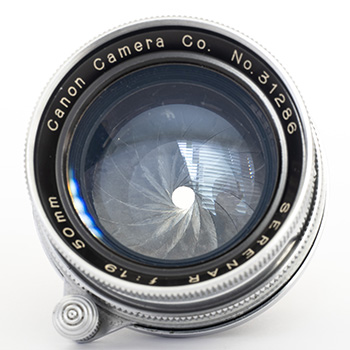

The Serenar f/1.9 continued as the standard lens until the Canon IV. Peter Kitchingman records four variations, but no significant changes apart from the Type 3 noted above (the majority found, with serial numbers beginning around 311xx). However, in regard to the Canon II-C camera, the Canon Camera Museum notes that there were optical improvements introduced with its f/1.9 lens:
“Although the fast Serenar 50mm f/1.9 lens which came with the II B was well received, people noticed lackluster performance at the maximum aperture. This was caused by the coma characteristic of Gauss-type lenses. Hiroshi Ito, who just joined the company, worked to improve the lens. He succeeded with a correction method that reduced the coma. Canon continued to employ him for lens design.”
Note, there is a difference of opinion between Canon and Peter Dechert about which was released first, the Canon II C (Canon) or Canon III (Dechert), see Canon II-C. If there was an improved version of the f/1.9 lens as sounds likely, I am confident that both models would have featured it from the outset. Unfortunately, whilst the majority of II C and III examples are found with the f/1.9 lens, serial numbers in my database are all over the place, whether due to Canon, or to a very high level of swapping including many with B II-like numbers (seems unlikely for the same type lens), so it is not possible to suggest a serial number where the change may have occurred with any certainty. I'm guessing from 40000 would be a safe bet and possibly from 36000 would be too.
50 mm f/1.8 Serenar
Although still a Double Gauss, 6 elements in 4 groups design, the Serenar f/1.8 is a new lens with rigid body and improved optical performance over its f/2 and f/1.9 predecessors, establishing Canon's reputation as a lens maker. It features an f/16 minimum aperture and 10 bladed diaphragm with click stops finally added. It was released with the Canon III-A and IV-F at the end of 1951 and importantly, it was the first Canon lens with the Leica spec “universal” thread mount. Whilst there would be later changes to the lens barrel, the optical design remained the same until production ended in 1975:
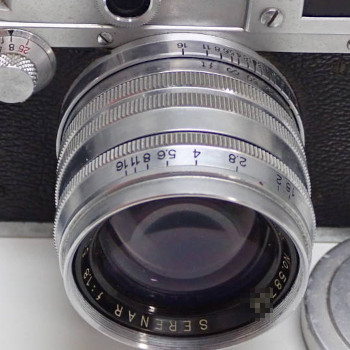 (Web image)
(Web image)
The filter thread remained its earlier 40 mm until the end, inconvenient these days but back then, Canon focussed on Series filters and accessories. The lens cap size also remained 42 mm.
50 mm f/1.5 Serenar
In November 1952, Canon released its fastest rangefinder camera lens yet, the 50 mm f/1.5, as an option for the Canon IV Sb. This was quite different to the War-time R-Serenar X-Ray camera lens. It featured the same appearance and chrome on brass construction as the f/1.8 lens and a new 7 elements in 3 groups design with 13 aperture blades, but by reputation, didn't match the performance of its lesser f/1.8 stablemate. Unusually, it retained the f/1.8's 40 mm filter thread and 42 mm lens cap sizes:
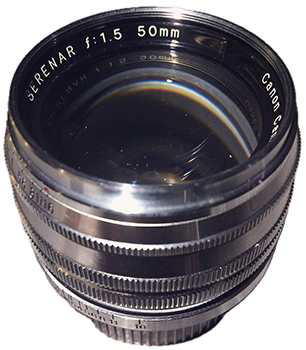 (Web image)
(Web image)
A prototype f/1.4 version of the lens was offered for sale at Leitz Auction no.46:


The red kanji text is suggested to mean “Test Sample”, machine translation will bring up many similar variations. The same text is found on an early Canon II B used as a test bed for flash sync and rail development.
(Leitz Auction images)
Serenar Accessory Lenses
The first accessory lens produced in commercial quantities was the 4 elements in 3 groups 13.5 cm f/4 Serenar based on the Zeiss Sonnar design. The 13.5 cm/135 mm length was the bread and butter long lens for rangefinder cameras, being the longest length at the f/4, or f/3.5, aperture size that could be rangefinder focused to give acceptably sharp prints, yet was economical to produce (OK, there were the pre-War Zeiss 18 cm f/6.3 Tele-Tessar K for the Contax, which had a much longer rangefinder EBL, and a later very brave 200 mm f/4.5 Komura lens in LTM). Initially, the Serenar was uncoupled. Hayato Ueyama explains that this was apparently because it had originally been designed to be a bayonet mount but required a modified gearing arrangement in the actual Nippon Kogaku supplied mount which had problems and was abandoned. To get it to market, it was released for the S II without rangefinder coupling. In any case, the Canon S II's short 23.1 mm rangefinder EBL would have made accurate focusing difficult, if not impossible, but nevertheless, rangefinder coupling was introduced more than a year before the arrival of the Canon II B.
The Canon Camera Museum site says that the first production lens was advertised in May 1947 but wasn't released until March 1948. Peter Dechert's earliest knowledge of the lens are two prototypes “reported” to be from 1944 that he surmised were the first Seiki Kogaku made Serenars, but as we have seen from the evidence in “Early Serenar Lenses” above, almost certainly incorrectly. In fact, as was noted in regard to the 13.5cm Serenar, Hayato Ueyama says that the first prototype was produced in late 1940 and Canon says that trial production started in 1941. Peter Dechert also says that the lens was made for sale post-War in both bayonet and semi-universal mounts. Peter Kitchingman confirms that and has recorded examples with the bayonet mount with one pictured in his book. According to both Kitchingman and Ueyama, the production lens was released in March 1947. As there are many examples of the lens with the earlier “Seiki-Kogaku” maker name (the name change occurred on 15 September 1947), including several design variations, the Canon marketing date is almost certainly incorrect. This ad from the 20 December 1947 Camera Times suggests that the 13.5 cm lens was already available alongside the 5 cm f/2 and f/3.5 lenses (the text before and after translates to “Serenar” and “coated processing”):
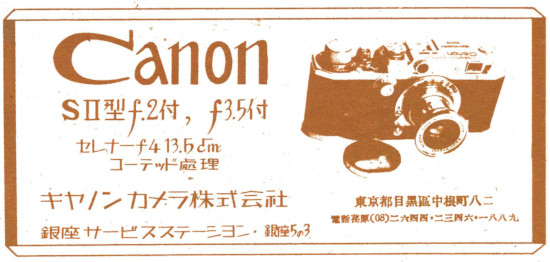
Peter Kitchingman has recorded 10 versions, some of which are significant variations, but others are simply, or mainly, graphical differences (markings, names etc.). All feature 13 aperture blades and none have click stops. The Type 3 introduced minor barrel changes and weight went up from 515 to 530 grams. In June 1947, the Type 4 reduced the filter thread size from 42 mm to 40 mm and the the lens cap size from 44 mm to 42 mm and weight went up to 550 grams. The Type 5 increased the overall lens diameter from 46 mm to 48 mm and changed the minimum aperture marking from f/22 to f/16. Rangefinder coupling was introduced in December 1947 by the Type 6 with weight rising to 555 grams and lens coating was added at the same time, initially a green colour. This changed to magenta in January 1948 with the Type 7 which also introduced 5 digit serial numbers (I think that the cam profile for the rangefinder coupling also changed - Peter Kitchingman's book compares a Type 5 and Type 6 but the Type 5 was not rangefinder coupled, I think that is a typo). The remaining types only changed markings with the Type 8 changing from centimetres to millimetres in April 1949 with the release of the Canon II B camera, the Type 9 adding “Japan” to the name ring and Type 10 changing from “1:4 f=135mm” to “f:4 135mm”. Production ended in October 1952 with replacement by the new f/3.5 version.
Left top and bottom is an early uncoupled Type 2 Seiki Kogaku 13.5 cm f/4 Serenar and on the right top and bottom is a rangefinder coupled Type 7 Canon Camera Co. 13.5 cm f/4 Serenar from about March 1949:
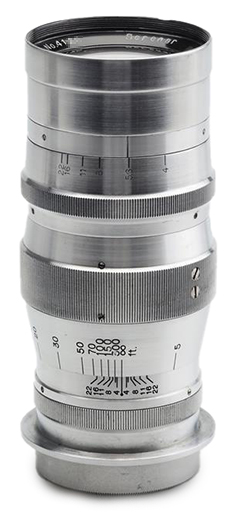
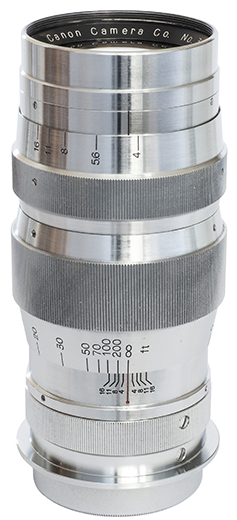

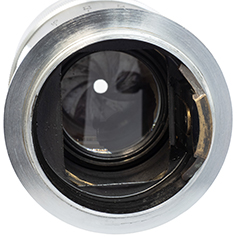
(Web images on left)
The profile detailing of the two lenses is quite different with different widths of aperture and focus adjustment rings and ribbing generally and different nose profiles. The Type 4 lens with its reduced diameter filter thread already appeared very similar to the later type. Presumably, the rear baffle was added at the same time as rangefinder coupling (Type 6). Note also the change in focusing scales. The Type 1 was 1.5 to 80 metres. The Type 2 (above left) was 5 to 300 feet. All the later ones were marked 5 to 200 feet.
These two Type 7 lenses are interesting. Their serial numbers are only about 500 apart, the right (it is also the right lens above) from before the end of March 1949, the left from around January 1949, give or take a month. The left lens has a <CPO> mark and the right a katakana version, <シーピーオー> (photos in <CPO> Mark), a good guide for the changeover from one mark to the other. The image frame aspect ratios of the baffles are noticeably different - the change was probably introduced to open up the baffle to lessen the possible impact from any slight rotational misalignment between mounted lens and body:
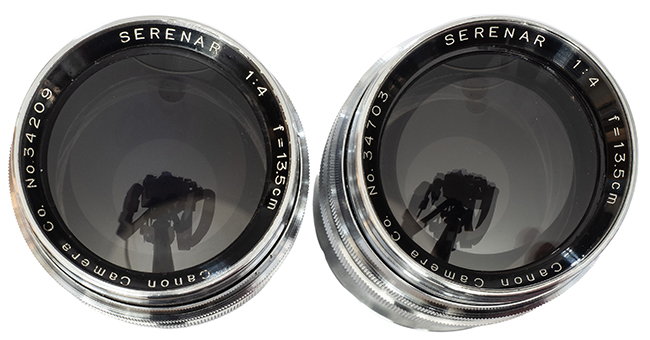
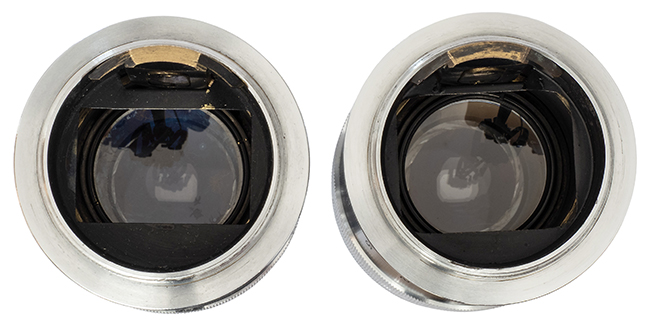
The later lens mounted on a 1948 Canon S II body:
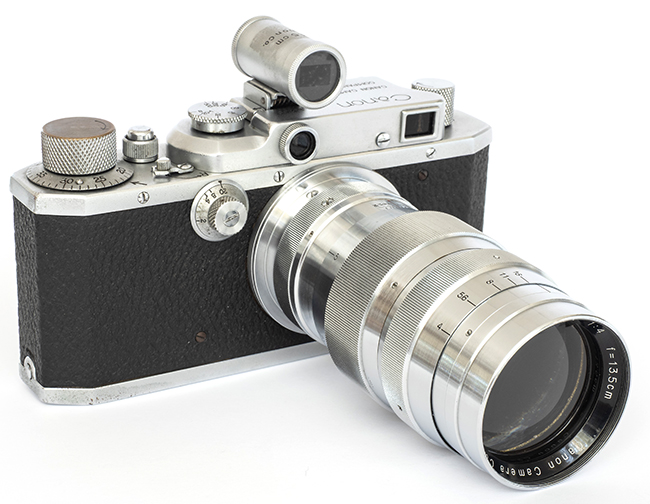
Production serial numbers are presumed to start at 4001 and run to 6900 at the end of Type 6 lenses. 5 digit serial numbers were introduced with the Type 7 and run from 31547 (earliest found at Peter Kitchingman's book publishing) to 45649 at the end of Type 10.
The 13.5 cm lens was followed by an 8.5 cm f/2 and 10 cm f/4 in early 1948, all changing to “mm” in 1949. The three are listed in this 25 December 1948 Camera Times ad:

The 10 cm/100 mm f/4 was a fairly simple 3 elements in 3 groups design. Serial numbers are presumed to start at 1001, but after a small batch, they changed to 5 digits and restarted at 40001. It ended production in July 1952 to be replaced by the f/3.5 version. Below is a 10 cm Type 3 lens, 41121, circa March 1949, mounted on a 1949 Canon II B. Note the rounded nose profile behind the front ring compared to the later lens below:

(image courtesy of Mohsen Saade)
An internal redesign, including of the focusing cam, in April 1950 resulted in a weight reduction of 120 g from 450 g to 330 g. This 100 mm example, 48143, is a Peter Kitchingman Type 6 from near the end, 48439:
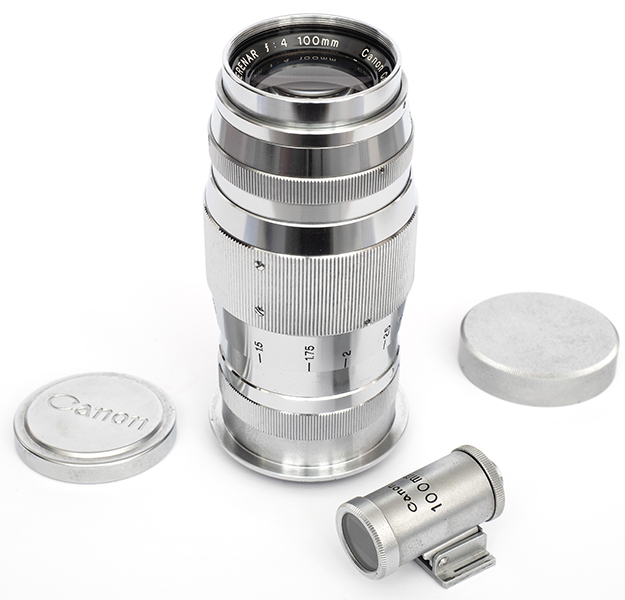
The 85 mm f/2 was joined by an f/1.9 version in September 1951 and ceased production in June 1952, the f/1.9 lens surviving in various forms until 1960. f/2 version:
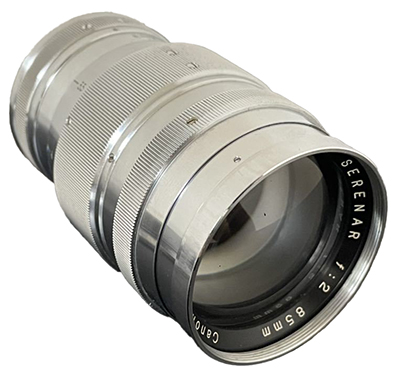 (Web image)
(Web image)
Canon released its first wide angle lens, the Serenar 35 mm f/3.5 in March 1950 (left image). In a little over a year later, it replaced it with a faster f/3.2 version which survived to July 1954 (right image):
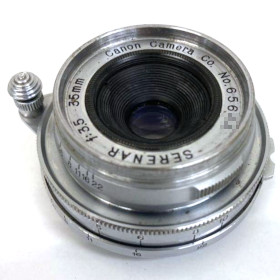

(Web images)
This is the Serenar lens range circa early 1951:
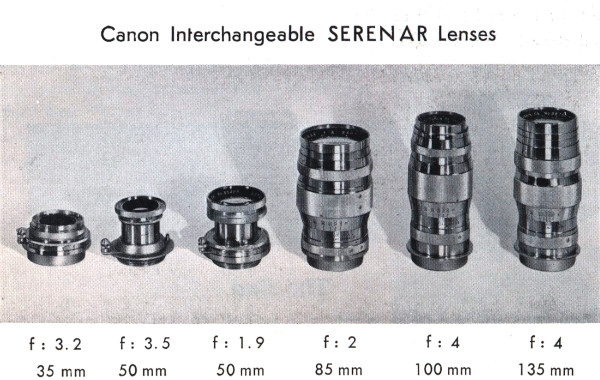
In 1951, it released a faster 35 mm f/2.8 (left image) and also its first wider lens, the 28 mm f/3.5 (later “Canon Lens” version on right):
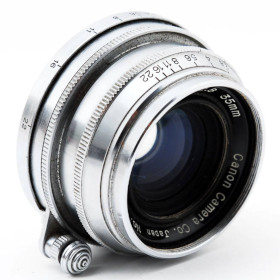

(Web images)
An f/1.5 85 mm Serenar joined the f/1.9 version in July 1952 and like its older sibling, survived until 1960:
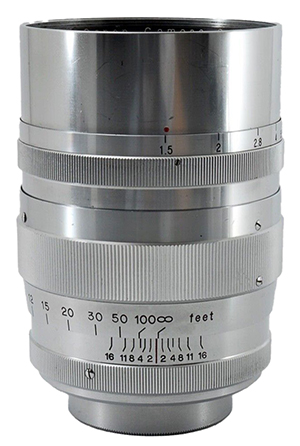 (Web image)
(Web image)
The f/4 versions of the 135 mm and 100 mm lenses were both replaced by f/3.5 lenses towards the end of 1952. This was shortly before the change in lens name, and there were probably less than 600 Serenar named 135 mm f/3.5 examples made and less than 500 100 mm f/3.5 examples. With a sign of things to come, the 100 mm f/3.5 replaced the brass on chrome barrels of earlier lenses with a much lighter alloy black barrel with chrome aperture and focusing rings - see Canon Lens version.
Both optical designs were new but whereas the 135 mm f/3.5 retained a 4 elements in 3 groups layout, the 100 mm f/3.5 adopted a more sophisticated 5 elements in 4 groups design than its f/4 ancestor's 3 elements in 3 groups.
Below is the lens page from the Canon II-D/III-A/IV-S user manual from late 1952 which is interesting in that it captures the full range of Serenars before the name change and includes superseded models as well, only missing the Serenar 5 cm f/2:
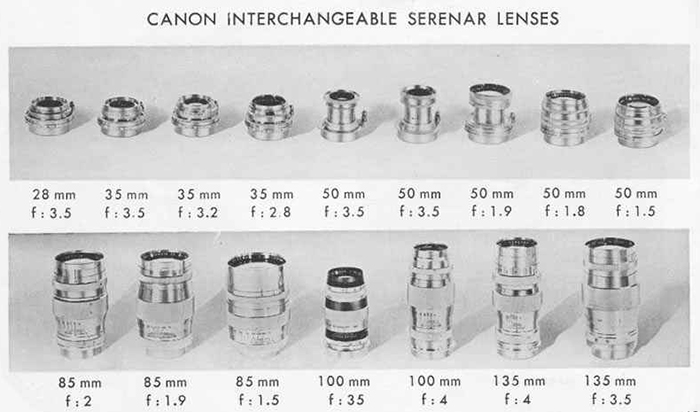
Canon tells us that the final Serenar was the impressively long 800 mm f/8 however, according to Peter Kitchingman, it was released as a Canon Lens. As the marketing date is March 1953, same as the announcement for the name change, I'm inclined to side with Peter Kitchingman.
Canon Lenses
Throughout at least the first half of the 1950s, Canon produced “Directions and Tables”, suggesting a user manual, for first Serenar lenses and then Canon Lenses. By 1958, the equivalent booklet was simply called “Canon Lenses”, implying more of a brochure which is what they increasingly became in the 1960s. Nevertheless, whatever purpose or form, they are a useful source of information. Below is an undated Canon Lens Directions and Tables, which in both appearance and content, is identical to August 1954 and January 1955 printings, i.e., from near near the end of the bottom loaders but before the 50 mm f/2.8 replaced the 50 mm f/3.5:
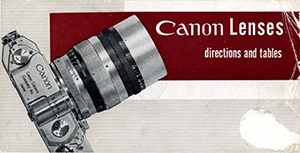 (Click on cover for PDF manual)
(Click on cover for PDF manual)
50 mm f/3.5 Canon Lens
The Serenar f/3.5 lens was renamed “Canon Lens” in December 1952:
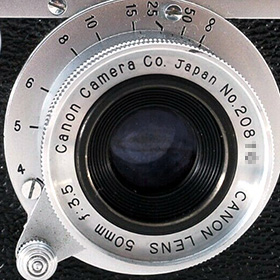 (Web image)
(Web image)
With the release of the new f/2.8 lens, production ceased in February 1955.
50 mm f/1.8 Canon Lens
Also renamed “Canon Lens” in December 1952 was the f/1.8 Serenar. Initially, it remained the same chrome on brass lens as before:

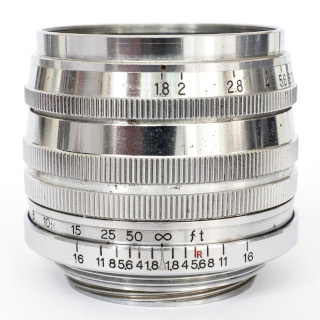
With the release of the Canon VT in 1956 with new features and a new modern look, the f/1.8 lens was updated with a new black light alloy barrel with satin chrome aperture ring and DoF scales (Peter Kitchingman's Type 5). In the redesign, the minimum aperture changed from f/16 to f/22 and the number of aperture blades increased from 10 to 13 initially but soon reduced to 11 (between lenses 201062 and 204800 according to a Canon Historical Society discussion). In 1959, the rear focusing ring was redesigned and the number of aperture blades was reduced to 8 (Type 6). Peter Kitchingman says the change occurred between 250xxx and 252xxx, my copy below, 250191, is a Type 5. The lens lasted until 1975 with another 2 minor variations in name only. Although an excellent performer, increasingly, it played second fiddle to the larger aperture lenses, finally becoming the budget option for the 7 series. This Type 5 is probably from around April 1959:
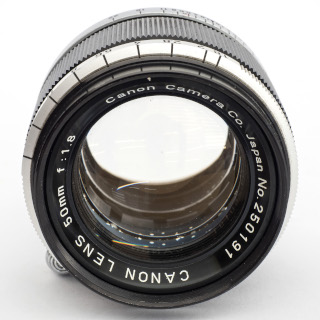
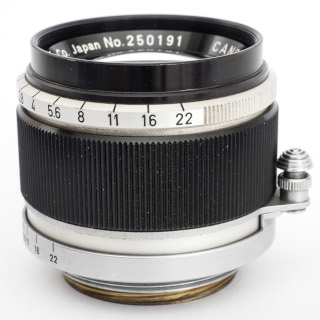
The Canon 50 mm f/1.8 was also one of three lenses offered in mostly all black, except for satin chrome DoF scale ring, to match the black body versions of some camera models. The other two lenses are the very rare 35 mm f/1.8 and the 50 mm f/1.2. Black 50 mm f/1.8:
 (Web image)
(Web image)
This is a Type 6 lens (see above) with black ring and mounting tab for infinity lock knob, the Type 5 lenses featured a satin chrome ring and mounting tab.
50 mm f/1.5 Canon Lens
The Serenar 50 mm f/1.5 was renamed to “Canon Lens” at the same time as the f/3.5 and f/1.8 lenses. It retained its chrome on brass construction until its demise in 1957:
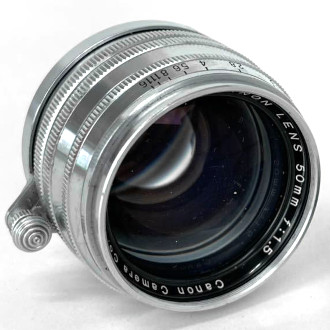 (Web image)
(Web image)
50 mm f/2.8 Canon Lens
The first standard “Canon Lens” without a Serenar predecessor was the 50 mm f/2.8 released in January 1955 to replace the collapsible f/3.5. It was made of alloy and featured a black nose and focusing ring with an in-vogue zebra pattern invoked by the ridges of the scalloped focusing ring being picked out in silver. The optical design is 4 elements in 3 groups, presumably a Tessar design. The number of aperture blades is 8. A December 1957 update saw the barrel redesigned to mimic the then current black f/1.8 50 mm lens, in the process adding an infinity lock, missing on the original, and increasing the filter thread from 34 mm to 40 mm with lens caps going from 36 mm to the more common (for Canon) 42 mm. First type on left, later version on right:
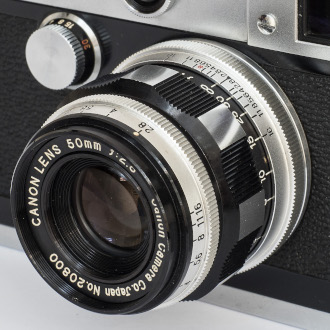
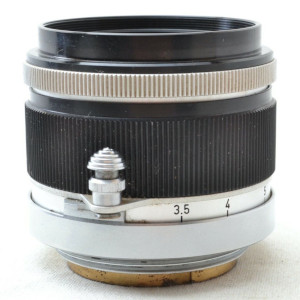
(Web image on right)
50 mm f/1.2 Canon Lens
Also released with the VT and promoted as its standard lens was the all new Canon 50 mm f/1.2 lens, a 7 elements in 5 groups design. It has 11 aperture blades, a 55 mm filter thread and takes a 57 mm lens cap. The barrel design was similar to the new f/1.8 except instead of a ribbed focusing ring, it was scalloped. An all black version of the lens was available for black cameras. It lasted until the end of 1967:
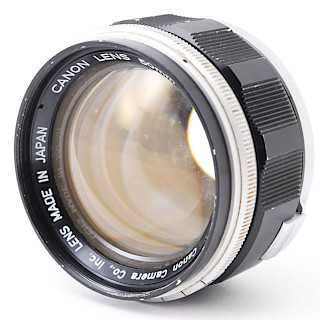
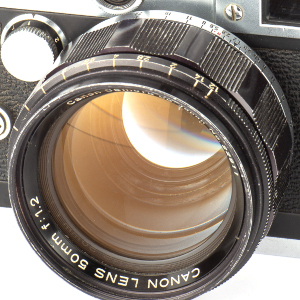
(Web images)
Peter Kitchingman describes it as the then “fastest 50 mm screw-mount lens available.” It was the fastest Canon lens and Nippon Kogaku only released its faster f/1.1 also in 1956 but both were responding to the legendary Zunow f/1.1 released in 1953, and updated in 1955, the 1954 Fujinon f/1.2 and the 1955 (maybe released January 1956) Konishiroku (Konica) Hexanon f/1.2, albeit this was a 60 mm lens rather than a 50 mm.
50 mm f/1.4 Canon Lens
The Canon 50 mm f/1.4 replaced the f/1.5 but not until August 1959 with Canon heavily promoting its f/1.2 instead. Another 6 elements in 4 groups design, it is considered to be one of Canon's finest performing rangefinder lenses and remained in production until 1972:
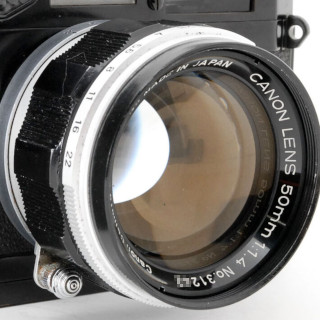 (Detail from larger web image)
(Detail from larger web image)
It has 9 aperture blades, a 48 mm filter thread and 50 mm lens cap.
50 mm f/2.2 Canon Lens
A new 5 elements in 4 groups entry level lens, it was only produced from January to July 1961. It has 10 aperture blades, 40 mm filter thread and takes a 42 mm lens cap (now plastic). What looks like an infinity lock is simply a focus assist lever:
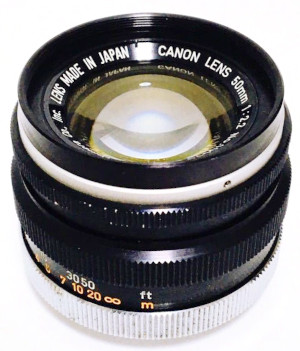
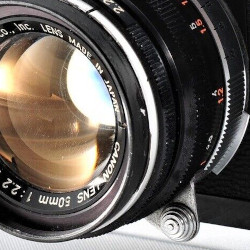
(Detail from larger web images)
Peter Kitchingman believes it to have been made for the domestic Japanese market Canon P only. His reasoning for that is that the two colour distance scale of the lens matches the colours of the late type Canon P film reminder dial on the back, however, this also featured on the late VI-L which was still in production until March 1961 and even on the very last of the VI-Ts which ended production in July 1960. It is a hard to find lens these days and not identified in Peter Dechert's book.
50 mm f/0.95 Canon Lens
Released with the Canon 7 in June 1961, the 50 mm f/0.95 was Canon's ultimate hero lens, the fastest 35 mm rangefinder lens then available, and became to be known as the “Dream Lens”. It has 7 elements in 5 groups, 10 aperture blades, a 72 mm filter thread and 75 mm lens cap. Because of its size and design, it isn't LTM compatible relying instead on the three pronged external bayonet mount around the threaded LTM flange. The rear of the lens features a breech lock to secure the lens in place:
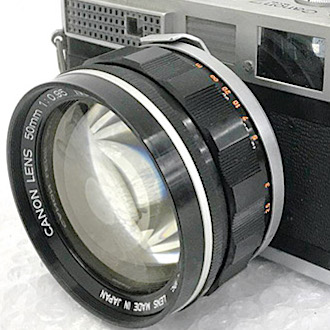
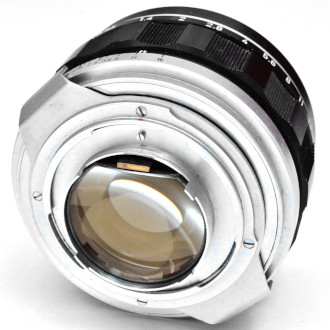
(Detail from larger web images)
It was made as a rangefinder lens until 1970 and then as a TV lens until 1984.
Canon Accessory Lenses
Serenar accessory lenses still in production underwent a name change from January 1953, i.e. 12 months after the standard lenses. Interestingly, the now “Canon” 28 mm f/3.5 wide angle lens was also made with a Contax mount and for, in Canon's words, “cameras of similar design”. Who could Canon possibly mean? Actually, there are differences between the Contax and Nikon specs which cause focusing problems with longer focal lengths but are not relevant with shorter focal lengths.
The renamed Canon 85 mm f/1.9:
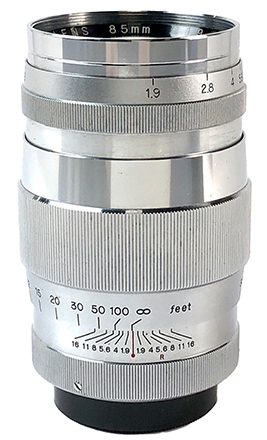
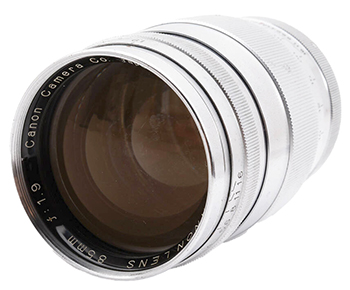
(Web images)
Below is the Canon version of the recently released 100 mm f/3.5 light alloy Serenar:
 (Web image)
(Web image)
From the first Serenar 13.5 cm f4 lens in 1947 to the VT period at least, Canon's accessory lenses, both wide angle and long focal length, were supplied in leather cases complete with lens cap, rear cap and appropriate “Special Viewfinder” before the viewfinder became an extra cost option. However, lens hoods were always an extra cost option. With the chrome long lenses, the Canon lens hood would include a Series adapter ring and a dust cap for the rear of the hood so when the hood was inverted over the lens (retained by friction of internal felt rings), it replaced the lens cap. The standard lens case would accommodate the lens with inverted hood. Consequently, lenses found today, if they still have their accessories, are either commonly found with a front lens cap, or a lens hood with dust cap, but very rarely with both.
This 135 mm f/3.5 lens is typical of a set with lens hood with viewfinder (stored under a flap in the leather case lid), end cap and Series VII lens hood (specifically for the 135 mm lens) with Series VII adapter ring for the 48 mm lens filter thread and screw on dust cap. The lens serial number, 48342, suggests 1953:
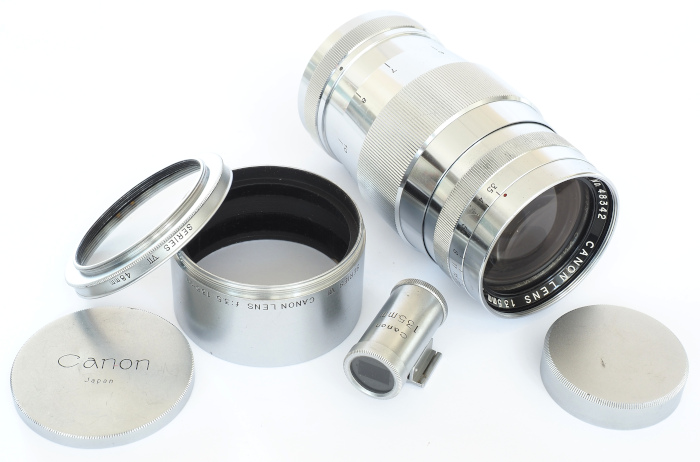
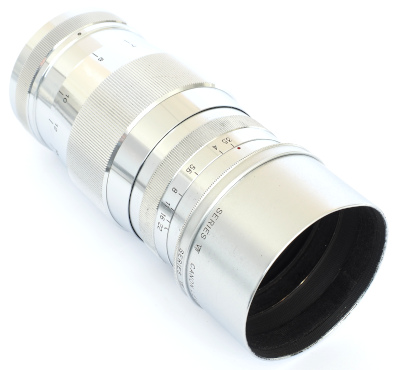
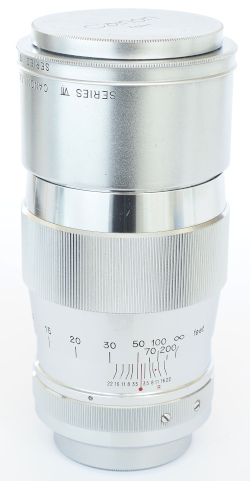
Note, earlier lens hoods, such as the Serenar 135 mm f/4, used a slip-on adapter ring and dust cap.
The 800 mm f/8 lens was one of the first Canon named lenses to be released (as noted earlier, Canon lists it as a Serenar) and Canon's first lens longer than 135 mm apart from the very limited production 1946 20 cm f/4. As 135 mm is usually considered the limit for accurate focusing, longer focal lengths require different focusing aids (the first Serenar 20 cm lens would have required a separate long base length rangefinder, or very long tape measure). The first versions of the 800 came with a permanently mounted reflex housing (mirror box) turning the rangefinder camera into a crude SLR. Later versions required first the Mirror Box 1 and then the Mirror Box 2 which would only mount on the external bayonet of the 7 Series cameras and also only accept bayonet mount lenses. It is a long black tube with a 2 elements in one group lens at the big end, typical of Canon's 600 mm to 1,000 mm rangefinder lenses. From a circa 1956 lens brochure, an earlier 800 mm lens with its own reflex housing:
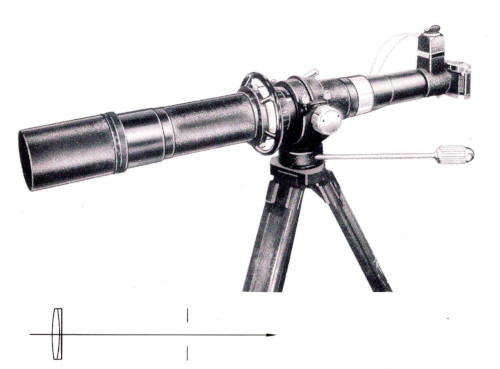
In 1956 came the shorter 5 elements in 4 groups 400 mm f/4.5 lens use with the Mirror Box 1, updated for the Mirror Box 2 in 1961. From the same brochure as above, a 400 mm lens with the Mirror Box 1:
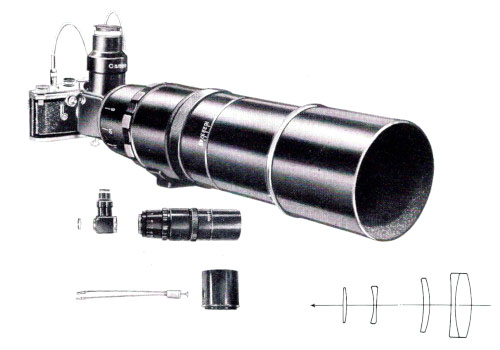
Also a new 25 mm f/3.5 wide angle lens:
 (Web image)
(Web image)
1957 saw the release of updated 28 mm f/3.5 and 35 mm f/2.8 lenses and the addition of a new 200 mm f/3.5 lens which used the Mirror Box 1 for focusing. There also seems to have been an intention to release a reflex version of a 135 mm lens with large f/2.5 aperture which required more precise focusing. It appears in the 26 March 1957 price list as “To be announced” and the What's New Trade Notes and News in the June 1957 edition of Popular Photography begins; “Canon Camera Co.,Inc., 550 Fifth Ave., New York, announces new lenses. The 135 mm Canon f/2.5 features a reflex system ...” The direct mount f/3.5 would remain as the common use lens. However, the f/2.5 version disappeared from subsequent brochures, manuals etc. and Peter Kitchingman only lists the Mirror Box 2 version M135 released in 1961 and the Canon Camera Museum seems to get both the 135 mm and 200 mm wrong (see 1958).
These were followed by 35 mm f/1.8 and 28 mm f/2.8 lenses. Typical 35 mm f/1.8 on left below and on the right, a very rare black version. Although not mentioned in his book, confirmed by Peter Kitchingman to exist:
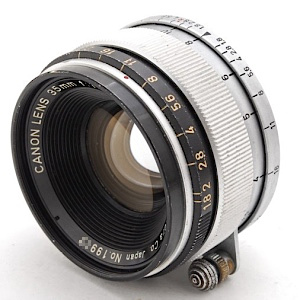
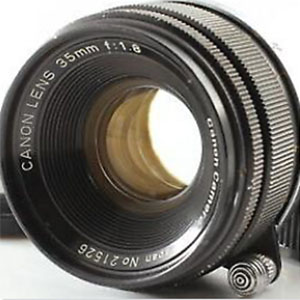
(Web images)
Canon lens list and display from the Canon L2 and L3 user manual, October 1957 printing (longer lenses are not pictured):
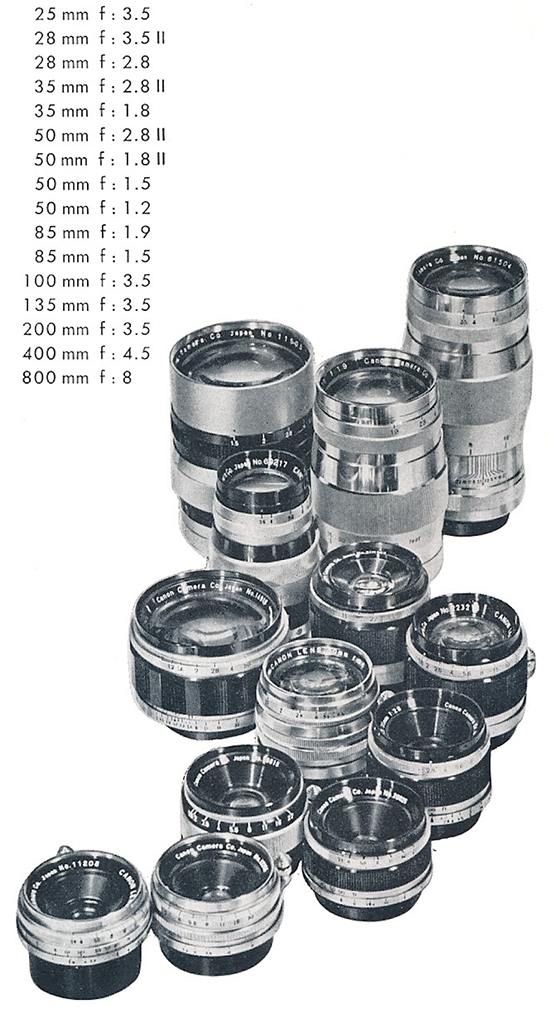
There was a slew of updates and new lenses in 1958. The 100 mm f/3.5, 135 mm f/3.5 and 85 mm f/1.9 received updates and a new 35 mm f/1.5 and 600 mm f/5.6 lens were released. Oddly, the Canon Camera Museum claims that an M200 mm and M135 were also released, the “M” signifying that they were made for the Mirror Box reflex housing. Presumably, the M200 mm was to replace the earlier 1957 200 mm and the M135 would replace its earlier f/2.5 version, if it existed (see 1957). According to Peter Kitchingman, the two lenses didn't get their “M” prefix until the Mirror Box 2 was released with the Canon 7 in 1961 and that is when he also says the 135 mm f/2.5 lens was launched. The 1961 date makes sense and that is what the documentary evidence of manuals and brochures suggest too but the earlier version of the 135 mm lens remains a mystery. Updated with black alloy barrels, the Canon 135 mm f/3.5 and 85 mm f/1.9:
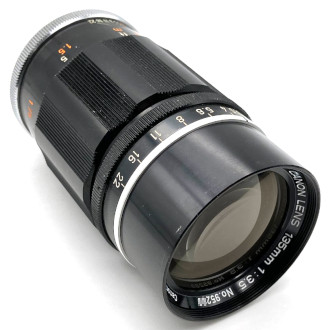
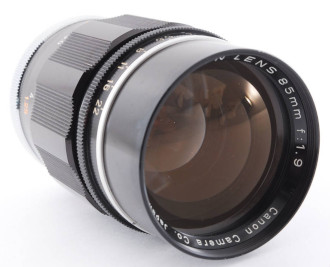
(Web images)
Large aperture Canon 35 mm f/1.5:
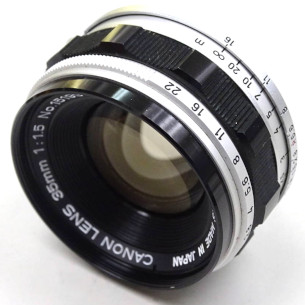 (Web image)
(Web image)
According to Peter Kitchingman, Canon also released the first version of its longest LTM lens, the 1,000 mm f/11 in 1958. Canon quotes 1960 but that is actually likely to be the 1961 update to mount to the Mirror Box 2 (that also applies to other lenses updated for the Mirror Box 2 bayonet mount too).
This is what the Canon lens line up looked like circa 1959 but without the 400 mm and longer lenses included:
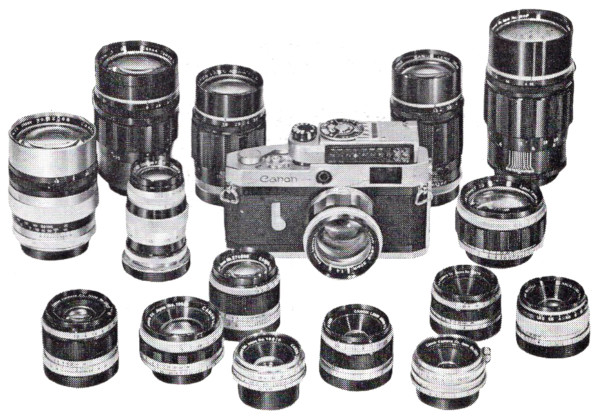
Canon lists a 300 mm f/4 released in 1960 for export only but this lens is not mentioned by Peter Kitchingman and doesn't seem to be mentioned in English language catalogues other than as the R version SLR lens. However, the R version, if used with the typical “intermediate support”, will mount to the Mirror Box 2 but will not focus to infinity, but if screwed directly to the Bellows R, it will focus to infinity - a sort of hybrid lens and that to some extent applies to all Canon's long lenses.
The last new lens releases included the 85 mm f/1.8 (replacing the f/1.9) in 1961, 35 mm f/2 in 1962 and the 19 mm f/3.5 in 1964.
The 19 mm f/3.5 lens features 9 elements in 7 groups with 6 aperture blades, 55 mm filter thread and a 57 mm lens cap and is rangefinder coupled. Whilst later Canon lens cases didn't make provision for matching finders and the lenses were presumably sold without them, the case for the 19 mm did and so the finder (see Viewfinders below) was no doubt included:
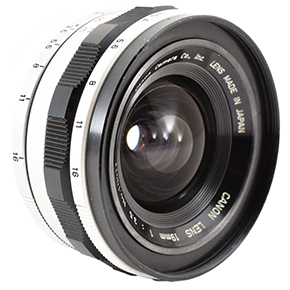

(Web images)
It was also available in FL SLR mount for which Canon offered the LTM “Lens Mount Converter B”. If found with the converter, it can be an economically attractive option for users these days as they are generally cheaper than the native LTM version. Although obviously not rangefinder coupled, their very large depth of focus makes focusing accuracy a non-issue. FL version and converter:
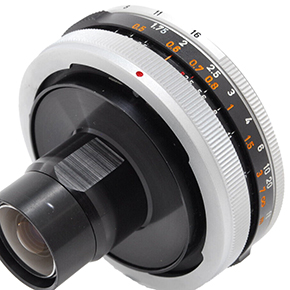

(Web images)
In 1971, when Canon released the Canon F1 SLR, it also apparently updated 10 existing rangefinder lenses with FD-like beauty/ID rings with “Canon” replacing “Canon Camera Co., Inc.” and “No.” in front of the serial number being dropped.
These are the Mirror Box 2 versions of the long 600 mm, 800 mm and 1,000 mm lenses from a 1962 Canon products guide:

Below is a table of then Canon rangefinder lenses and specs from a 1968 product brochure:
(Click on table for larger version)
Mirror Boxes
As noted earlier, the 135 mm focal length is considered to be the practical limit for accurate rangefinder focusing. With a large aperture and shallower DoF, even a 135 mm lens is problematical. Canon's first practical long lens was the 800 mm with its own permanently mounted reflex housing. Subsequent versions and other long lenses first used the Mirror Box 1 and from 1961, the Mirror Box 2. Note, Mirror Box 2 is conveniently called that by Canon on its front but Mirror Box 1 is collector invention, Canon simply referred to its reflex housing as a “mirror box”.
Mirror Box 1
The Mirror Box 1 mounts to the camera flange by the Leica thread mount. The lens mounts to the front of the Mirror Box either by the internal Leica thread mount (200 mm lens), directly to the external two prong bayonet (400 mm lens) or via the separate focusing bellows (longer lenses):
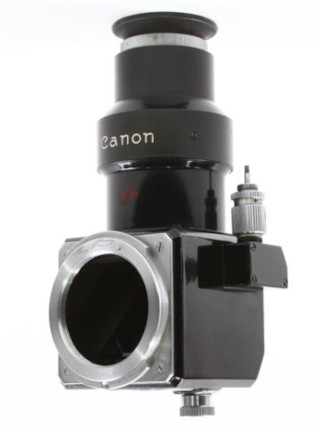

(Web images)
The Mirror Box 1 is operated with a double cable release with one cable screwed into the shutter release button, the other, via what is often called a “Leica Nipple”, connected to the external thread around the Mirror Box mirror release plunger. The button on top of the plunger is missing in the above photo but can be seen in the photo below:
 (Web image)
(Web image)
Mirror Box 2
The Mirror Box 2 will only mount to Series 7 cameras by their external bayonet mounts. The lens mount on the front is also a three pronged bayonet - lenses made for the Mirror Box 1 won't mount. Like with the Mirror Box 1, focusing can be done from above using the focusing screen, or with the pentaprism mounted, from behind like a typical SLR. The Mirror Box 2 doesn't use cables, instead it has an actuating lever with the end sitting over the camera's shutter button. Pressing the lever flips the mirror up and releases the shutter. The mirror remains in the up position until it is manually lowered and cocked with the lower shorter lever. Whilst it operates like a basic SLR, its convenience factor is many times less.
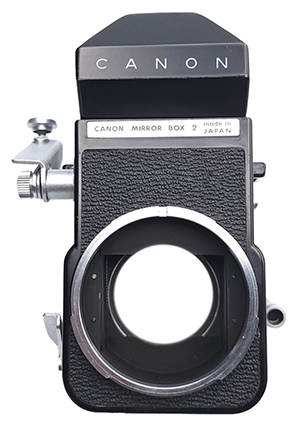
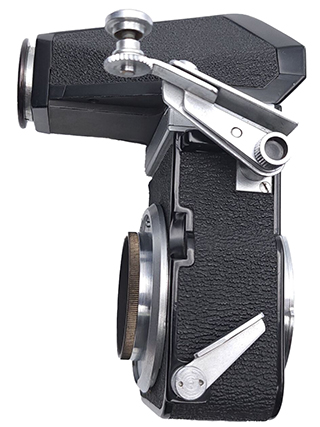
(Web images)
The Canon M135 f/2.5 and Canon M200 f/3.5 feature their own focusing helicoids and mount directly to the front bayonet of the Mirror Box2. Canon M200 and Mirror Box 2 mounted on Canon 7:
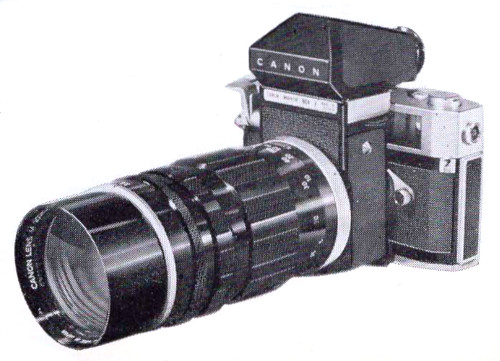
The 400 - 1,000 mm sets use bellows focusing and in addition to the lens and Mirror Box 2, require a number of separate components: a lens specific Intermediate Tube to connect lens and bellows (supplied), Lens Supporter and Bellows R. Complete 400 mm set:
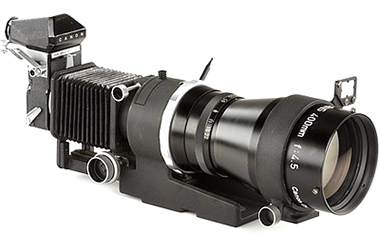
(WestLicht Auctions)
Viewfinders
Canon produced viewfinders for every focal length from 135 mm and below (i.e. those not using a reflex housing), including 50 mm, and there are many types and variations. Note that depending on lens focal length and camera viewfinder magnification and/or frame lines, an accessory viewfinder is not always needed.
Frame Finder (Sports Finder)
Generically referred to as a sports finder, Canon variously referred to it as “Sport Frame Finder”, “Universal Frame Finder” and “Frame Finder”. The first version dates from 1939. It is also mentioned in the circa 1951 Canon III brochure and although less visible later, it is still an item in a 1957 price list. Although they all look broadly similar, there were a number of versions and variations over the years (Peter Kitchingman has identified 9), the earliest just featuring a frame for 5 cm lenses with a cross to mark the centre, then a frame for 13.5 cm was added in the centre, as on the one below left. On the right is a later example with different hinged frames for 50 mm, 85 mm, 100 mm and 135 mm focal lengths which can flip down if not required. As with other viewfinders, these slot into the accessory shoe:
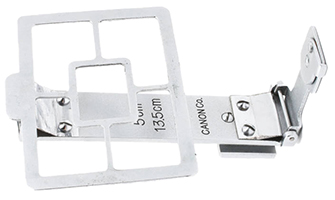
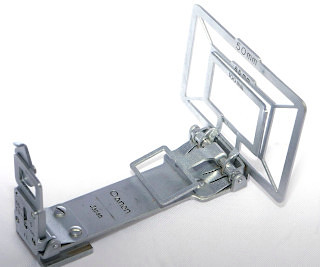
(Web images)
Early Viewfinders
These were satin chrome and called “Special Viewfinders”. They were suppled with the accessory lenses until after the release of the 1956 Canon VT when new finders were introduced, the new black wide angle versions retaining the Special Viewfinder name/description. Even though, from casual observance, there is a similarity of appearance amongst the chrome finders, there are considerable differences amongst the early versions. This is one may be a Peter Kitchingman Type 2a (the Type 1 has no markings and the 2b has the slot in the foot on the opposite side), it belongs to an uncoupled Serenar 13.5 cm f/4 from before 1948, note, there is no parallax adjustment:
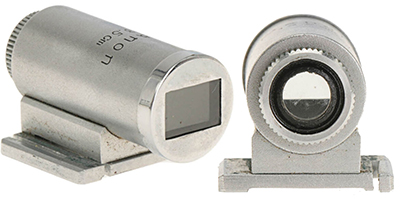 (Web images)
(Web images)
This one with parallax adjustment belongs to a Type 7 Serenar 13.5 cm f/4 from around January 1949. Still with the cm focal length marking, according to Peter Kitchingman, it is a Type 3 viewfinder. The stain on the body aligns with the case lid leather restraining loop. Note ribbed detailing around the eyepiece of this and the next one compared to later types:
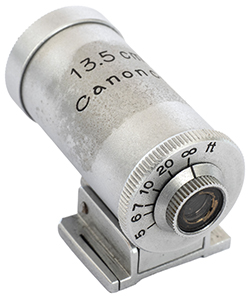
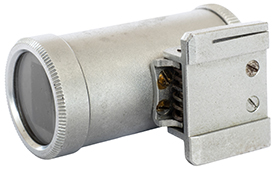
Found with a Serenar 135 mm f/4 from probably late 1949 and like its lens, features the focal length marked in mm. It may be a Type 4 or 5. :
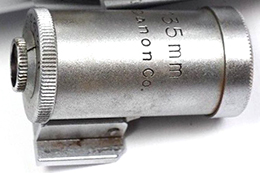 (Web image)
(Web image)
Below are front and rear views of a finder belonging to a Canon 135 mm f/3.5 lens, likely from 1953. It is unnumbered and may be a Peter Kitchingman Type 7 finder, which is the second last of the chrome type, the Type 8 being similar, but with serial number:
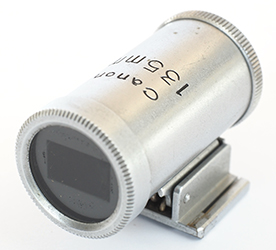
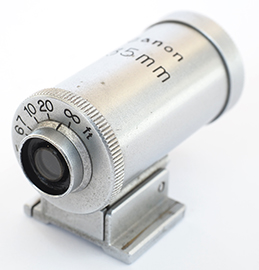
This is a 100 mm version found with a 1952 Serenar f/4 lens and is serial numbered. It is a Peter Kitchingman Type 8a (note, whilst features of similar vintage finders are usually similar, Peter Kitchingman maintains separate type lists for each focal length and the types do not necessarily correspond exactly):


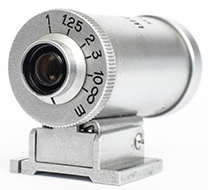
Front and rear views of a wide angle 35 mm version and a 28 mm Special Viewfinder:
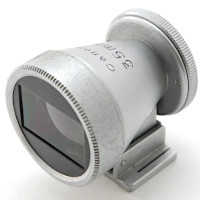

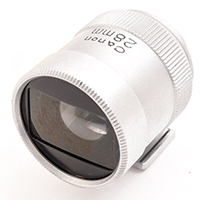
(Web images)
As with the later 135 mm and 100 mm types above, the 35 mm features manual parallax correction adjusted by the dial around the eyepiece, however the 28 mm type doesn't offer it.
Universal Viewfinder
The Universal Viewfinder appears in the 1951 Canon III user manual and circa 1951 brochure, however, Peter Kitchingman says that it was released around October 1950. The original is still listed in an October 1956 lens catalogue but an updated one for Series V cameras is displayed in a Canon L2 & L3 user manual printed in October 1957. It has a variable field of view to match lens focal lengths from 35 mm to 135 mm. Individual front lens attachments were available for Canon's 25 mm and 28 mm lenses, the 28 mm version pictured mounted below:
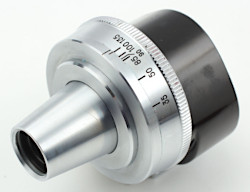

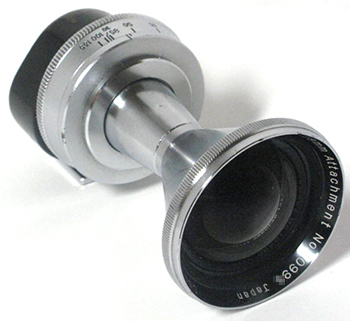
(Web images)
New Viewfinders for older Models
As well as the continued availability of the Universal Viewfinder, the October 1956 lens catalogue also mentions manually operated parallax correction version of the new Special Viewfinders (see below, the Lumi-field versions for longer lenses are not included yet) plus a new Twin-turret Zoomfinder II specifically for the older models:

For Series V and VI-T and VI-L Cameras
The first Series V model, the Canon VT, introduced a new feature, a parallax correcting pin at the front of the accessory shoe which moves up and down with focusing. This connects to a pin in the bottom of the viewfinder shoe which moves the front of the viewfinder up and down. Canon L2 shoe:
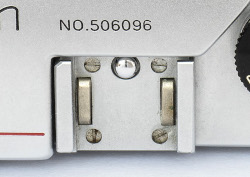
There were several different viewfinders which made use of this feature (if used with a camera with a standard plain shoe, i.e. bottom loaders and P and 7 models, there would be framing errors but Canon did offer an accessory “Finder Coupler” which is a manual adjuster that fits between the shoe and finder):
Erect Image Viewfinders: Somewhat like the Universal Viewfinder in appearance, these are fixed focal length and were produced in a range from 25 mm to 135 mm, all looking very similar. They were released with the VT but were very soon replaced, making them very hard to find for collectors:
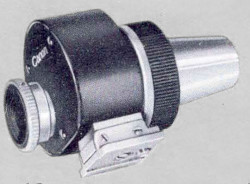
Special Viewfinders V: These were available for 25 mm, 28 mm and 35 mm wideangle lenses. 35 mm type pictured:



(Web images)
These were also available in a non-V version with manual parallax correction for Series IV and earlier cameras.
25 mm Viewfinder: This is the Special Viewfinder which replaced the erect image version for the 25 mm lens released in 1956. It is different to the 28 mm and 35 mm types. There were versions with no parallax correction and with V-type automatic correction. The first image is the first type with no parallax correction, an extended chrome bezel around the eyepiece and also two screws per side to retain the front chrome bezel instead of one. The second two images are of a V-type automatic correction type:


 (Web images)
(Web images)
Lumi-field Viewfinders V: Somewhat similar in appearance to the new Special Viewfinders V (excluding the 25 mm one), these provide a more expansive view outside the margins of the brilliant white frame and are the longer focal length counterparts to the Special Viewfinders V. They were available for 50 mm, 85 mm, 100 mm and 135 mm lenses:

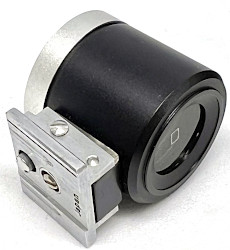 (Web images)
(Web images)
Zoomfinder: Later identified as “Zoom-finder V”. It featured click stops for each standard focal length and came in two versions, “S” and “L”. The first is for wide angle lenses from 35 mm to 50 mm, and with the optional Front Attachment Lens, also for 21 mm, 25 mm and 28 mm lenses and the second is for longer lenses from 85 mm to 135 mm. Model S Zoomfinder and Front Attachment Lens from Canon brochure:
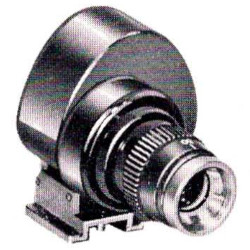
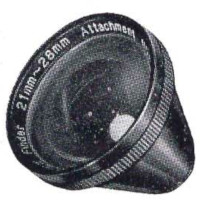
Found example of Model L:


(Web images)
Universal Viewfinder V: Making an appearance in the Japanese Canon L2 & L3 user manual printed in October 1957 is a new version of the Universal Viewfinder redesigned for the automatic parallax adjustment of Series V cameras. It continues to cover the 35 mm to 135 mm focal length range but there is no mention of a wide angle attachment other than for the Zoomfinder:
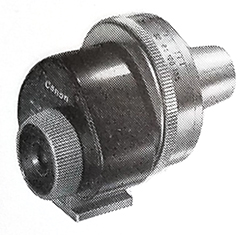
Below is a found example, note that the eyepiece is different to the user manual image:
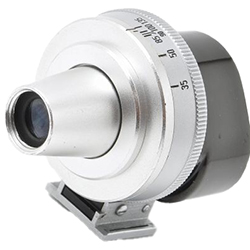
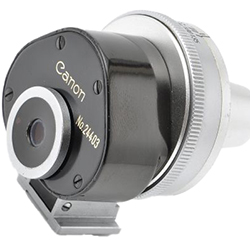
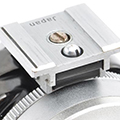
(Web images)
For Canon P and Series 7 Cameras
Note, to mount a viewfinder, the Canon 7 model requires use of the “Canon Accessory Coupler”:
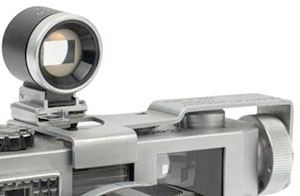 (Detail from larger web image)
(Detail from larger web image)
The Canon P and subsequent 7 models did away with the parallax correcting pin and therefore the Series V viewfinders are unsuitable for these cameras and the earlier bottom loaders (unless used with the Finder Coupler mentioned above). For these cameras, the parallax correction of the black Special and Lumi-field Viewfinders reverted to manual via a lever at the back of the base:


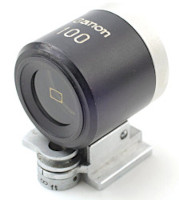
(Web images)
The Special Viewfinders with a manual lever were around since at least 1956 for bottom loading models, I don't know when the Lumi-field versions were released.
25 mm Viewfinder: This is the manual correction version:

 (Web images)
(Web images)
19 mm Viewfinder: Canon's last rangefinder lens released was the 1964 Canon 19 mm, the first of this focal length. The finder is unusual for Canon in that there is an accessory shoe on top. There is no parallax correction:

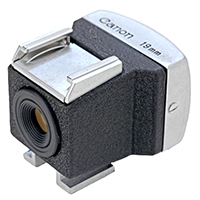 (Web images)
(Web images)
Universal Viewfinder: Featured in the Canon P user manual and sales brochure, this still looks the same as the Universal Viewfinder V, except that it has lost the automatic parallax correction feature. However, there doesn't appear to be any obvious manual parallax correction either:

Lens Hoods and Filters
In this overview, I have included lens hoods and filters together because of the way that Canon fully embraced Series filters and their mounting options from approximately 1950 onward.
The background to Series filters began with English company Wratten and Wainright Ltd., co-owned by Frederick Wratten, his son and Kenneth Mees, being sold to Eastman Kodak in 1912. Kenneth Mees had developed photographic filters using gelatin and these later became known as Wratten filters. I don't know who first introduced the Series filter mounting system but it was probably also Kodak. The company certainly made the system its own, along with Wratten filters, and popularised its use and in that context, it is not surprising that the sizes are based on imperial measurements. The system came into use in the 1930s when lens bezels still didn't feature filter threads but it also offered a form of standardisation by allowing one set of filters to fit many size lenses. Series filters, which come in standard sizes, don't have a thread and require the correct size adapter for the lens. Typically, the Series adapter used a slip-on fitting to mount to the lens and then filter retainer, or hood, screwed into that. The filters usually featured a plain metal rim but some earlier ones were simply a glass disc.
Before Series Accessories
In the 1940s, Kogaku Seiki offered an earlier, now hard to find, range of rimless glass disc filters and lens hoods which mount much in the same way as Series filters typically do. Peter Kitchingman refers to these as “drop-in” filters, as he also does in regard to Series filters. Whilst somewhat similar to Series filters, they don't conform to Series specifications, being metric rather than imperial. Two sizes of filters (glass discs) were available, 30 mm and 40 mm diameter, which are slightly smaller than the Series V and VII filters (30.2 mm and 41.3 mm). Initially, the 30 mm fitted the very early 36 mm clamp-on hood for the 5 cm f/3.5 lens and the 40 mm fitted the early 44 mm slip-on hood for the 13.5 cm f/4 (note, the early clamp-on hood predates the Canon Series clamp-on type by perhaps 10 years, or so). The earliest black hoods were simply marked “Seiki Kogaku” with no size markings and the boxes for the 40 mm filters were marked “Seiki Filter”, “40 m/m” and “Seiki Kogaku. K.K.”, presumably, the early 30 mm are similar. Seiki kogaku 36 mm hood and filter found with a Canon S II (note the early clamp-on fitting):
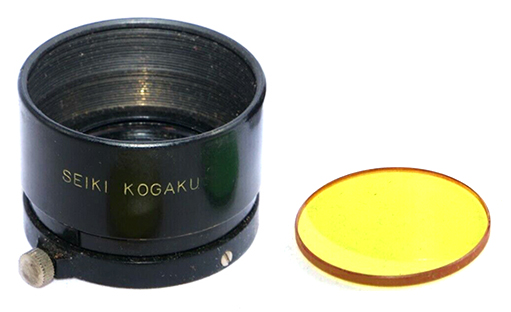 (Web image)
(Web image)
There was a later chrome version hood simply marked “Canon”. A found example has a 36 mm slip-on mount (instead of the earlier clamp) for the 50mm f/3.5 Serenar and a leather case with dividers for two rimless filters, both present. The case has a Katakana version, <シーピーオー>, of the CPO mark so it is almost certainly from 1949.
A Special Case, Mirror Box Filters
Canon offered a set of 5 B & W special screw-in filters for the Mirror Box and Mirror Box 2 which screw into their body on the camera side. Included were UV, IR, red, orange and yellow, all geared towards landscapes. Later catalogues and price lists are less forthcoming about specific details. Two red filters were available for the original 800 mm lens, but mounting is unknown.
Canon Series & Screw-in Filters and Hoods
Apart from the Serenar 5 cm/50 mm f/3.5 lens, Canon's lenses featured filter threads as well so that screw-in filters could also be used, but except for special cases such as UV filters and lens diameters that weren't compatible with Series VI and VII, they weren't a feature of Canon's system until later in the 1950s. Initially, Canon's Series adapter rings were also slip-on but in 1952 changed to screw-in. Many of Canon's lens hoods, including later clamp-on types, were also threaded to fit Series size fittings and act as a retainer for the filter (see further below). A 1954 price list explains:
“Canon Filters, except for 85mm f:1.5 lens, must be used with Lens Hood and Adaptor Ring or Adaptor Ring and Adaptor Ring Insert.”
As noted above, Canon used both Series VI and VII sizes. Series VI are 1 5/8" (41.3 mm) in diameter and Series VII are 2" (50.8 mm). Series VI yellow and Series VII green filters pictured:
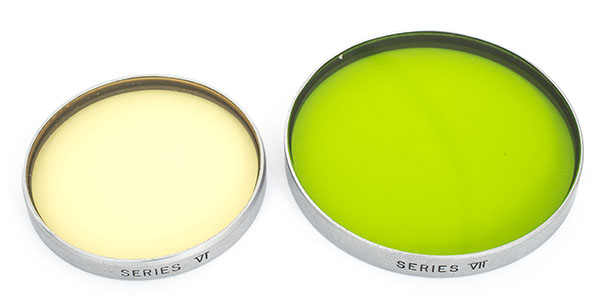

Note, the filter type is not marked, not for these B & W types anyway.
A step-up adapter was available allowing the larger Series VII filters to be used on Series VI fittings but it was trickier with lens hoods whose length and diameter must be matched to focal length as well to remain effective.
Whilst this Series VI black Canon Bakelite case with yellow lid seems to be typical of cases for earlier yellow filters (I have seen an orange lid on presumably an orange filter case) I have seen one with a black lid:
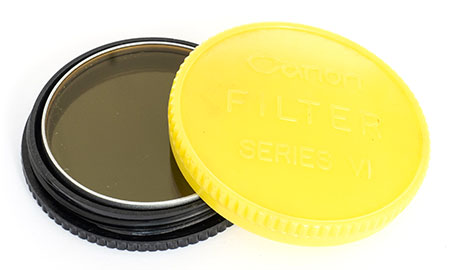
Canon offered filters singly, or in sets of 5, in stackable matching colour cases, initially with a black top lid, later clear. A January 1955 brochure lists VI and VII filters for B & W photography in Y1 (light yellow), Y2 (yellow), G0 (green), R0 (orange), and R1 (red) colours plus a UV (haze) filter available singly only. It also listed screw-in filters (58 mm) for the 85 mm f/1.5 lens. A March 1955 brochure suggests that UV filters were only available as screw-in types and more diameters were listed including 34 mm. It noted that single cases were now also colour coded. Peter Kitchingman has posted images of a 34 mm screw-in filter stack, from the “C” in the Canon name, probably from 1956, or earlier, which he calls “rare”. It's unusual as the 50 mm f/3.5 lens was listed as accepting 34 mm hoods and Series VI filters, perhaps it was intended for the new 50 mm f/2.8, although it will fit either.
This is a 40 mm screw-in UV filter with the later “Canon” name style introduced in 1957, there will be examples with the earlier name style:
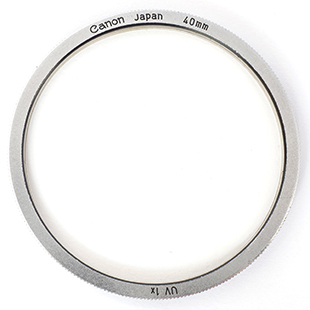
The 1957 price list includes UV screw-in filters in 34 mm, 40 mm, 48 mm, 55 mm and 58 mm sizes and adds 55 mm screw-in filters for the new f/1.2 lens but a January 1959 Canon P brochure still refers to “Canon filters in Series” for the majority of use cases. By the 1962 Bell & Howell price list, the full range of B & W and now colour filters are listed in screw-in sizes only.
As already noted, the large aperture lenses with big front elements, i.e. 85 mm f/1.5, 50 mm f/1.2 and 50 mm f/0.95, didn't use Series filters, or lens hoods adapted for them. Filter frames for these were different than the 40 mm UV example above. Examples are further below.
The best resource for checking filter sizes of the many Canon lenses is one of the lens brochures downloadable from Pacific Rim Cameras, or the Lens Hall of the Canon Camera Museum. Note, the Serenar f/1.9 collapsible and f/1.8 rigid as well as the both the chrome and black Canon f/1.8 50 mm lenses feature an unusual 40 mm filter thread, not the much more common these days 40.5 mm. This also applies to both the Serenar and Canon f/1.5 50 mm lenses and the Canon f/3.5 25 mm, f/3.5 28 mm II and f/2.8 35 mm II lenses. The Canon f/1.4 50 mm is 48 mm, the f/1.2 mm is 55 mm and the f/0.95 is 72 mm.
Adapted from a 1955 Canon accessories brochure, this is an example of how the Canon Series sytem could be used:
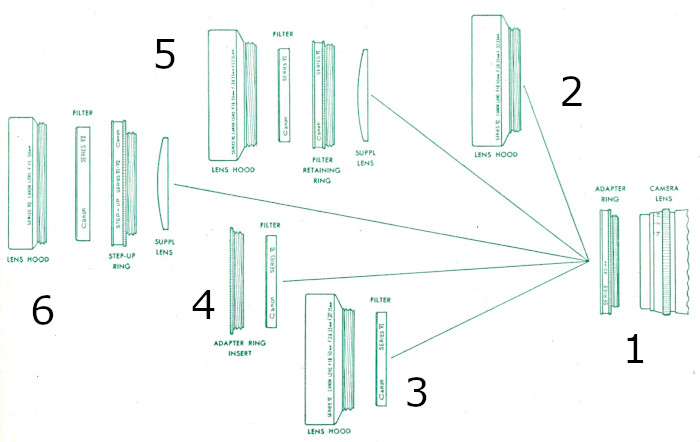
- 1 Lens with, in this case, Series VI, adapter ring.
- 2 Series VI lens hood screws into adapter ring.
- 3 Series VI filter is retained in adapter ring by lens hood.
- 4 Series VI filter is retained in adapter ring by adapter ring insert.
- 5 Supplementary lens, such as close-up lens, is held in adapter ring, in this use case, by filter retaining ring and then a filter is added and retained by the lens hood (or you could use the adapter ring insert in place of the hood). All components are Series VI.
- 6 Supplementary lens, such as close-up lens, is held in Series VI adapter ring, in this use case, by step-up ring (VI to VII) and then a Series VII filter is added and retained by the Series VII lens hood (or you could use the Series VII adapter ring insert in place of the hood).
Below are four versions of Series VI lens hoods for the Serenar/Canon 50 mm f/1.8 and select wideangle lenses. Note, the first three lens hoods are marked with the Series number and the first two adapters are marked with the Series number and either the slip-on, or screw-in, size of the particular lens. All four hoods are marked with the lenses that they are suitable for. These are typical of contemporaneous lens hoods in other sizes as well. The first version uses a slip-on Series VI adapter ring and the second, like the above system, a screw-in adapter introduced in 1952 (note, whilst the other three are marked 42 mm to fit over the lens bezel, this one is marked 40 mm for the lens filter thread). Both of these would have been supplied with dust caps, the first slip-on, the second screw-on, see further below:
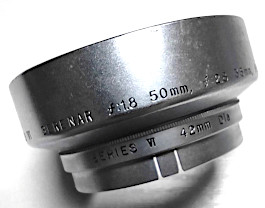
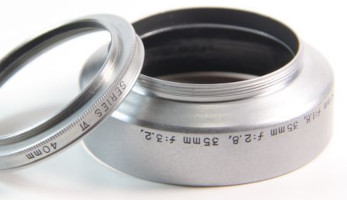
(Web images)
These two later lens hoods clamp over the lens bezel. The black hood is typical for black lenses. Note that satin chrome one is still a “Series VI” hood but there is no longer mention of Series on the chrome clamp-on part, only “42 mm A”. The black 50 mm f/1.8 version is the same in this respect but now there is no mention of Series on the hood either even though the hood still unscrews from the adapter and accommodates Series VI filters regardless that it is often found in a leather case with divider for one filter which, if there, is invariably a screw-in type. It was initially supplied in a brown leather case with ribs on the edges, then plain, then black (this is not the last version of the hood, see end of section):
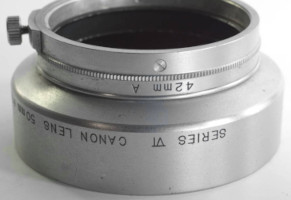
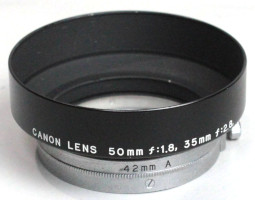 (Web images)
(Web images)
There were also Canon square black lens hoods offered from 1951 to 1956. These were available for the f/1.9 and f/1.8 50 mm Serenar/Canon lenses and for the 35 mm wide angle lenses from the period. Below left is one suitable for the Serenar f/1.9 50 mm and f/3.5 35 mm complete with Series VI to 42 mm slip on adapter and Series VI yellow filter and below right is one for the Canon (and Serenar) f/1.8 50 mm and f/2.8 and f/3.2 35 mm lenses, again with Series VI to 42 mm slip-on adapter (these only seemed to be offered with the slip-on type). Note the corner viewfinder cut-out:
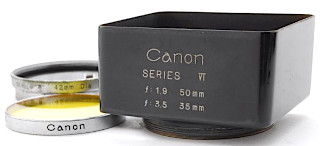
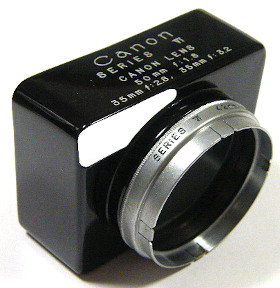
(Web images)
Below are two satin chrome lens hoods for the Serenar 135 mm f/4 (the very earliest were black). Both are Series VI and mount to an earlier Series VI slip-on adapter ring. The left image shows the adapter ring screwed to the hood and the dust cap, which looks like a lens cap and pushes over the adapter when the hood is reversed over the lens for storage. Note, Canon calls the lens hood a “sunshade” and the lens hood cap a “sunshade cap”. The whole assembly replaces the normal lens cap, a felt ring inside the hood providing a friction fit. The right image shows the hood and adapter ring separated:
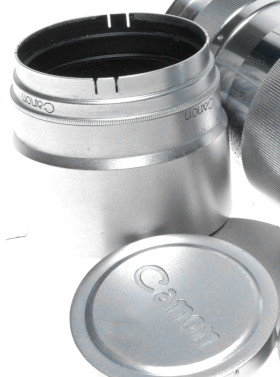
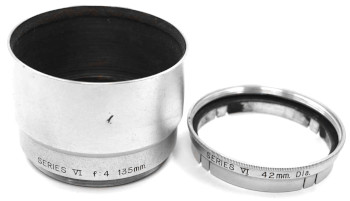
(Web images)
Below is a Series VII screw-in adapter ring and Series VII lens hood for the 135 mm f/3.5 lens. Its dust cap screws onto the back of the adapter when the hood is reversed (see Canon 135 mm lens above). This one features two felt rings inside the hood:
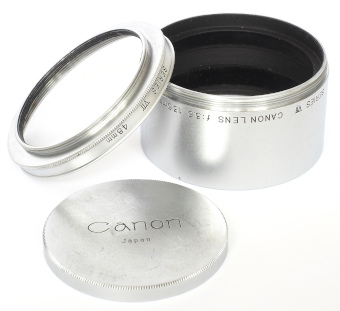
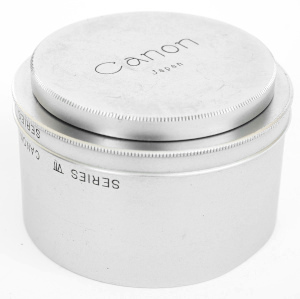
And with Series VII green filter added:
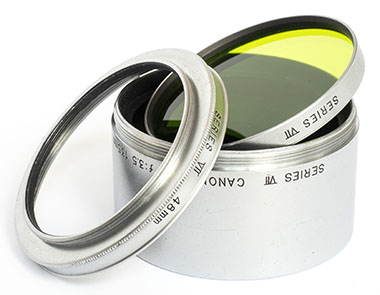
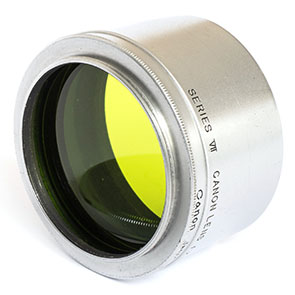
At some point in the late 1950s, perhaps in 1958 when the black versions of the telephotos first appeared, Canon changed its lens hood naming system. Apart from special lens specific hoods such as for the 50 mm f/1.2 and f/0.95 lenses, they no longer featured the actual names of lenses the hood was suitable for, e.g. “CANON LENS 50 mm f:1.8, 35 mm f:2.8”, as on the late black and chrome hood further above, but used a more generic description, in this case it became “S-42” on the black hood and “42 mm” on the chrome clamp-on part. Complete cased set including screw-in 40 mm Y3 filter (this type of set and filter was already a feature of the black hood above):

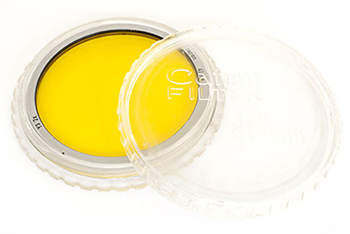
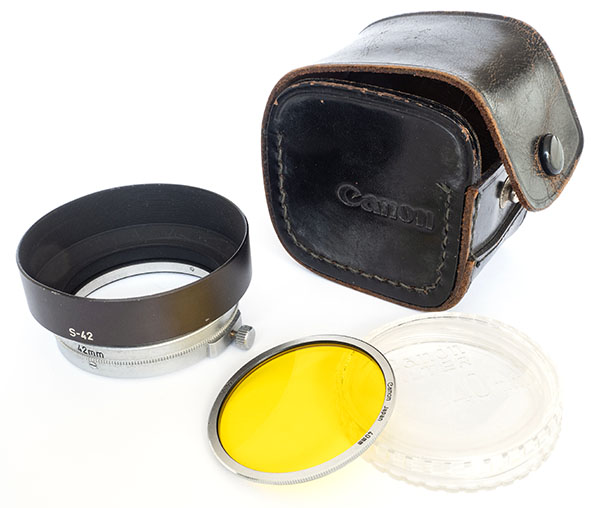
As with the earlier hoods, the adapter can still be unscrewed and a Series filter mounted, in this case with the yellow Series VI from further above:
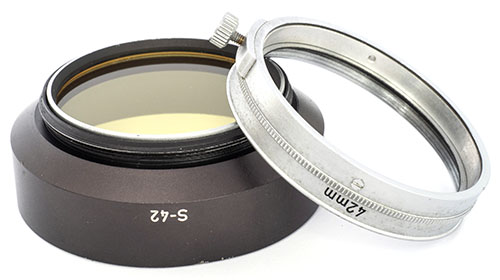
The screw-in filters designed for use with the clamp-on hoods are quite thin depth-wise and consequently have a wider, flat frame viewed from the front. They were presumably made that way to allow the hood clamp to grasp more of the lens bezel rather than the filter and/or to reduce possibility of vignetting with wide angle lenses:

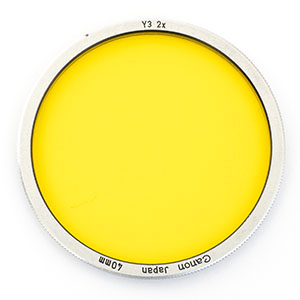
S-42 hood and screw-in filter mounted on a Canon L2:
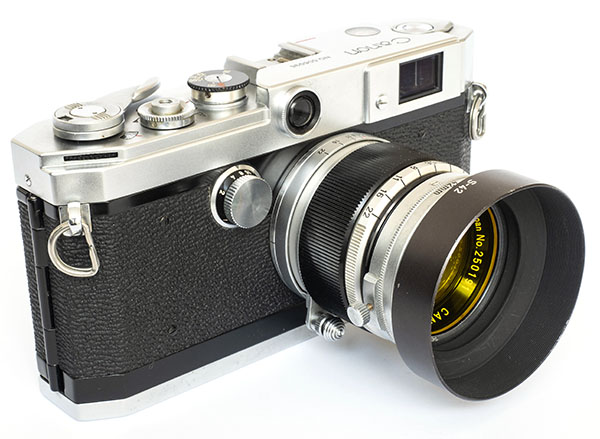
The “S” in the name refers to “standard” whereas the number is obviously the mounting diameter, e.g. the hood for the 50 mm f/1.4 with 50 mm filter thread is named “S-50”. There are also “T” for “telephoto” hoods and “W” for “wide angle”, although I'm not sure that I have seen any W ones specifically for rangefinders, only for SLRs (a June 1962 Bell & Howell price list states that all then current wide angle rangefinder lenses had the lens hood “built-in” and there were no accessory types available). Some of these hoods would also suit Canon's first R SLR lenses and subsequent FL lenses introduced in April 1964 and some would only be for R or FL lenses. Some of the naming I'm not clear with, e.g. the “T-42” seems to be for a 100 mm f/3.5 rangefinder telephoto but there is also a “T-42-2” which looks the same, only a little shorter. This one might be for the 100 mm f/3.5 R preset Canonflex lens. The table from a 1968 product brochure at the end of the lenses section above lists available hoods as S-42, S-50, T-42, T-50 and T-60 and “Exclusive” hoods for the f/1.2 and f/0.95 50 mm lenses and 400 - 1,000mm mirror box lenses.
Whilst by the early 1960s, Canon had stopped offering Series filters at all, even FL specific hoods initially continued to make provision for them. A very late 50 mm f/1.4 lens hood marked “S-50” (lens made until 1972) is the only rangefinder specific hood that I have seen that has abandoned the ability to mount Series filters (apart from the large diameter and mirror box exceptions). It's box is marked “for Canon Lens 50 mm f:1.4”, the rangefinder lens being the only standard f/1.4 lens with 50 mm lens cap that I'm aware of:

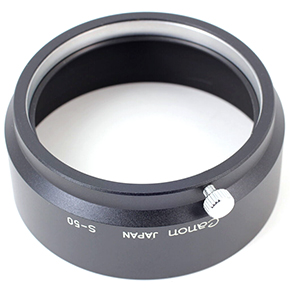 (Web images)
(Web images)
Two of the afore-mentioned larger diameter lens hood exceptions for both naming and the ability to take Series filters, 50 mm f/1.2 lens hood on left and 50 mm f0.95 lens hood on right:
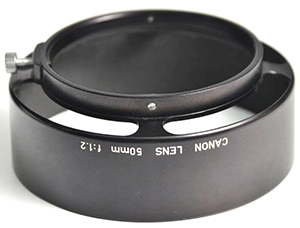

(Web images)
Earlier screw-in filters were named by their common description, e.g. the 40 mm yellow filter below left is marked “Y3 2X” meaning dark yellow with a 2X filter factor, or doubling of required exposure. This changed in the early to mid-1960s to the Japan Industrial Standard (JIS) classification with the equivalent name “SY 50.2C” (the “.2C” does not refer to the filter factor). The metal rim style and plastic case remained the same as did the lens hood with filter set above:

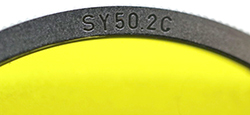
(Web image on right)
This table from Canon filter instructions shows all the equivalent names for then current filters:
(Click on table for most the of full English side instructions)
The flat thin rim style of the filters, with writing on the front, are typical of the screw-in filters that replaced Series filters, however, the larger filters and even earlier 55 mm filters, i.e. those made for larger diameter lenses without Series lens hoods, are more like modern filters in appearance. Just to confirm that they belong to the same period as the two above, here are two examples of UV filters, one marked “UV 1X” and the other with the JIS classification instead, “SL39.3C”:
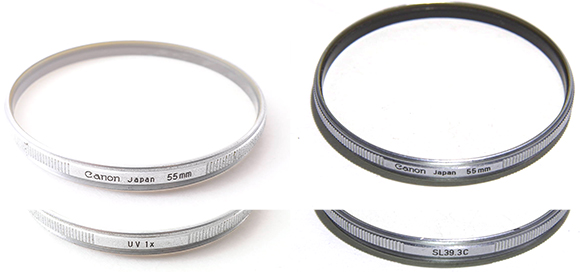
(Web images)
Lens Caps and Other Caps
The Hansa Canon lens caps for the Nikkor black face and white face lenses are 38 mm diameter. They are mostly flat faced black painted metal with a white “Canon” name, although I have seen two 38 mm types in satin chrome, below right, both with black face Nikkors:

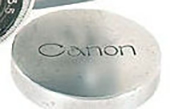
According to Hayato Ueyama, the lens cap for the f/4.5 lens was the black type.
The lens caps for later Nikkor f/3.5 lens with separate aperture ring and the Serenar f/3.5 lens are the Leica Elmar 36 mm “standard”. I don't think that I have seen any Hansa lens caps for the later type Nikkor but on the Canon S, they are typically slightly domed and finished in satin chrome, below left, although one collector with three examples of Canon S I cameras has three in black with white name. Presumably, this type carried on during the War and it was certainly still in use in the early post-War period and into Canon S II production (according to Peter Kitchingman, at least the first 3 versions of the Serenar 5 cm f/3.5 lens until the end of September 1947). On the right is another example found with a Canon S II (Peter Kitchingman notes two versions for the S II, three in total, but any differences are too subtle for me to tell from photos):


(Detail from larger web images)
Pacific Rim Camera had a boxed and cased Serenar 10 cm f/4 lens on its website with the chrome domed lens cap (36 mm, same as 5 cm f/3.5 lens cap) but Peter Kitchingman says that it was released with the later Type 4 style cap already. This lens, No. 40143, is noteworthy because it is listed in Peter Kitchingman's book as the first found in the 40001 to 40742 Type 2 range.
Late 1940s and all 1950s cameras were fitted with appropriately sized versions of the satin chrome types below, the main variation being the style of the “Canon” name. I don't fully follow Peter Kitchingman's book regarding lens caps types because there are no photos, but I am guessing that the one below left is his Type 1. I have seen a number of them fitted to uncoupled 1947 Serenar 13.5 cm lenses in both 44 mm and 42 mm sizes and one on an early Serenar 5 cm f/2 in 42 mm size. It features an engraved name infilled in black. The right one may be a Type 2. It seems to be the first type with pressed name but a little crudely done. I've seen two, one on a 10 cm f/4 Serenar and the other on a 5 cm f/2:
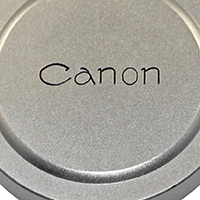
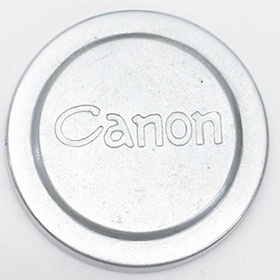
(Web Images)
The lens cap below left is another 42 mm version and is a little worn with some brassing confirming that, like most metal lens caps of the time, it was made of plated pressed brass. Like the one above, it has short fat serifs (the little angled bits on the “C” and “n”s) but the characters are more refined. It came with a 1950 Serenar 5 cm f/1.9 lens, but I think that it maybe a Type 3 from between October and December 1947. The later 42 mm version on the right, which I think is a Type 5, has more pronounced and much sharper serifs. Based purely on following Japanese sales and auctions, I'd be guessing that it arrived with, or not long after, the name change from Serenar to Canon Lens, but Peter Kitchingman is of the view that it didn't arrive until the black 50 mm f/1.8 in April 1956 (his thinking seems to be related to the longer serif introduced on the “C” in the Canon name on the camera body - I'm not sure that the two are connected, the new style name already appeared on the cover of the February 1955 printing of the IV-Sb2 user manual and the “C” has always had some sort of serif):
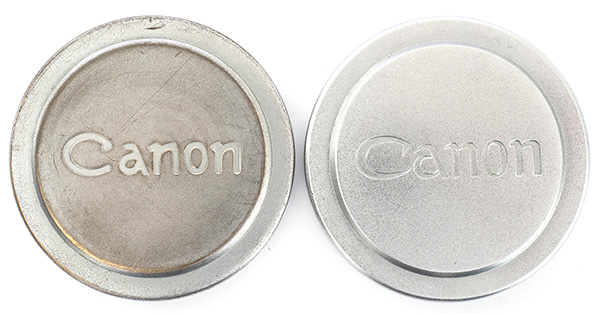
This is an early 36 mm version, its lettering is similar to the one on the left above, but its serifs are more defined. Peter Kitchingman refers to this as a Type 4 and according to him, on the 5 cm/50 mm f/3.5 lens, it followed the last dome type and ran through from October 1947 to the lens' demise in February 1955 (again, I think that the sharper serifs arrived earlier). On the 10 cm/100 mm f/4 lens, the 36mm Type 4 ran through from the beginning in Jan 1948 to the end in July 1952:
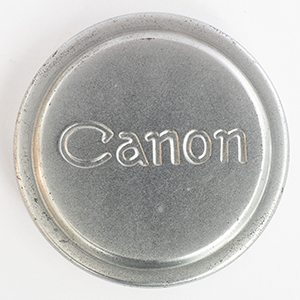
Below are front and rear views of three 36 mm lens caps from oldest (above) on left to youngest on the right. The oldest has softer edges than the other two and the outer flat ring is also narrower. The middle and youngest types appear to be the same as each other but they are not. Whilst both have sharper and more pronounced serifs and more sharply defined letters, the youngest one's lettering is sharper and just slightly narrower in the thickness of the strokes. The youngest lens cap is the same as that for the first type 50 mm f/2.8 on my 1957 Canon L2, likely original:
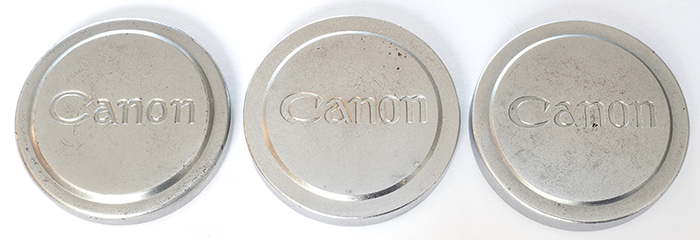
The rear of all three is similar with a felt lined rim. However, on the earliest, the name is clearly a pressing. It's almost impossible to see in the photo, but the name on the second has very slightly pressed through, more at one end than the other. The inside of the youngest cap is completely smooth - obviously, the process being used for each was either different, or being refined (this only refers to the 36 mm types, there is more press through on what I think is the 42 mm Type 5 and even more on the newer and larger one for the f/0.95 lens):

Note: The Serenar and Canon 5 cm and 50 mm f/2, f/1.9, f/1.8, f/1.5 and f/2.2, as well as the second type f/2.8, all use 42 mm lens caps.
Below left is a 42 mm black plastic lens cap - it and the f/1.4 and f/1.2 50 mm lens caps changed when the f/2.2 50 mm lens was released in January 1961 with this style cap. The font has been revised to match the revised Canon logo introduced in 1956. Usually, time has not been kind to these with the soft plastic easily marked and scratched. Next to it on the right is the 75 mm satin chrome lens cap for the f/0.95 “Dream Lens” released with the Canon 7. It features the same new name style as the black plastic one next to it. I have also seen two black metal examples, if original, presumably meant for a black bodied Canon 7, but one was fitted to a lens mounted on a chrome body and therefore possibly a later swap, and the other one was by itself:


(Web image on right)
In 1964, Canon released its 19 mm f/3.5 lens which features a 57 mm lens cap. As far as lens caps go, the situation is confusing. I've seen a couple with earlier satin chrome lens caps shared with the 50 mm f/1.2 lens and others with SLR style caps. Canon also released the FL mount version of the lens in 1964 and offered a mount converter for use on the rangefinder cameras. This obviously featured the SLR style cap but it may have been shared with the LTM lens.
For a large part of the Canon rangefinder lifetime, the 40 mm rear lens caps were metal, generally satin chrome but black on later black lenses. After mid-1959, they were hard plastic. Below left is satin chrome version from the MIOJ period (1947-1951), later satin chrome ones were plain without text, the one on the right from a Canon 135 mm f/3.5 lens:
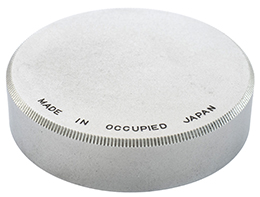
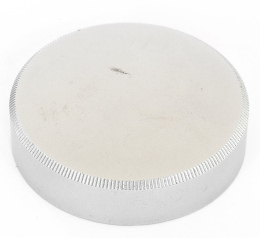
This is a Bakelite type:
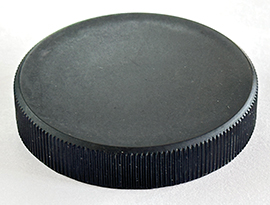
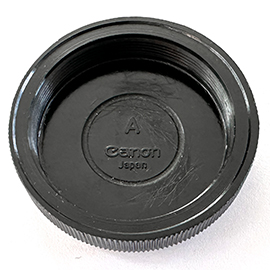
There are a number of satin chrome metal body caps with slightly different Canon markings and coarseness of the milled edge grip. This is one example:
 (Web image)
(Web image)
For the following items, I am again relying on information posted by author Peter Kitchingman on the Facebook page, “Canon Historical Society”.
Prior to the introduction of the new clamp-on style lens hoods in April 1956, Canon also supplied rear dust caps for their lens hoods for use when the felt lined hood was reversed over the lens for storage. The dust caps mounted to the Series adapter ring, slip-on earlier, and screw-on from the second half of 1952. It is easy to confuse the slip-on type for lens caps which look like the typical satin chrome lens caps but came in 40 mm, 46 mm and 54 mm sizes. Below is 40 mm size for Serenar 135 mm f/4 lens hood:
 (Web image)
(Web image)
The screw-on types came in 35 mm, 41 mm and 49 mm sizes. Left below is a screw-on type fitted to Series VII to 48 mm adapter ring of 135 mm f/3.5 lens hood (see also further above in “Lens Hoods and Filters”), right below is a screw-on cap fitted to Series VI to 34 mm adapter ring of 50 mm f/2.8 lens hood:

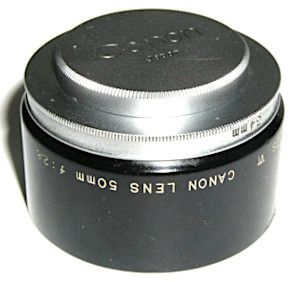
(Web image on right)
Lens Cases
A February 1954 price list confirms that Canon was supplying all its wide angle and long focal length lenses in leather cases together with the appropriate Special Viewfinder. Long focal length lens cases made provision for storing the lens hood, not included, reversed over the lens. If you bought a standard lens by itself, it was supplied without either but a plastic case was listed separately and a 1955 brochure lists both the plastic and also a leather case for them. Plastic cases were also available for the wide angle lenses too, but few plastic ones of any type have survived. The inclusion of leather cases and viewfinders probably continued until at least the release of the VT camera and new viewfinders in 1956. The March 1957 price list lists lenses, cases and viewfinders with separate prices, but how that worked in practice, I'm not sure. I can't imagine a lens being sold without a case, but viewfinder options were becoming more complicated with the availability of different types and some focal lengths not necessarily requiring accessory viewfinders with the new bodies. For reference, there were camera makers in the 1950s and 60s that priced ever-ready cases separately, but you couldn't buy the camera without one.
Canon produced a very complete range of lenses with many variations over time so that there are many variations of lens cases too. Below is a selection of early to late leather cases for 13.5 cm/135 mm lenses and one 100 mm followed by 35 mm cases and one 19 mm lens example. These are representative of other longer focal length and wide angle lens cases too.
In the period that Canon included viewfinders with their long focal length lenses up to the mid-1950s, the lens cases made provision for storage of the viewfinder under a flap in the tall lid of the case and although lens shades were an extra cost option, the cases were designed to accommodate them when inverted over the lens. The dust cap for the rear of the lens hood then became a de facto lens cap effectively replacing the lens cap itself. A number of early 1950s lens manuals include the following diagram explaining how the system works:
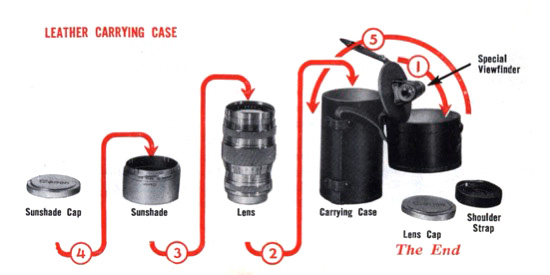
This is a case for a Serenar 13.5 cm f/4 Type 7 (Peter Kitchingman) lens from about January 1949. It is similar to the earlier types. This one features the MIOJ marking on the bottom plus it also has the <CPO> mark. Like pre-War camera ever-ready cases, the first accessory lens cases also used an articulated metal strap hanger for the hand/neck strap before changing to the continuous strap passing under the case and through two leather saddles either side, perhaps already with the Type 8 lens (first with mm markings):
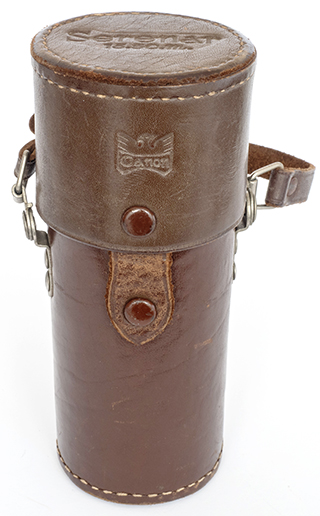
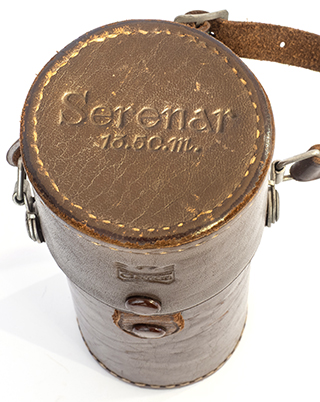

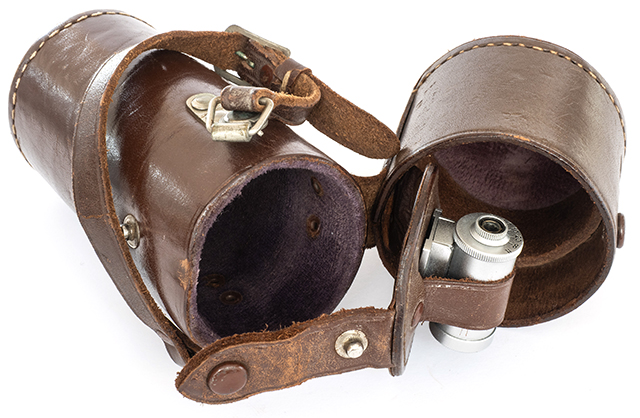
This is the 1952 case for the last of the chromed brass 100 mm f/4 Serenars, very similar to the next Canon 135 f/3.5 case One thing to note is that both the lenses for this and the next case were sold complete with caps, and lens hood for the 135 mm, but no sign, nor mention, of finders by their sellers. The first thing I checked was the lid compartment and there they were:
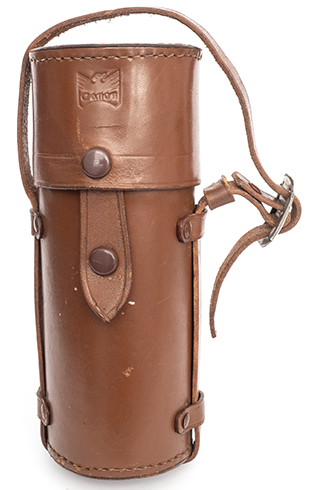
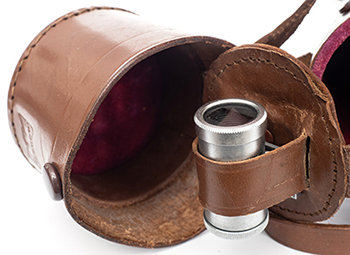
This Canon 135 mm f/3.5 case is most likely from 1953. The second image shows the cover of the viewfinder storage compartment inside which the finder is now secured to the flap with an elasticised band replacing the earlier leather loop. Unfortunately, like most of its ilk, it's stretched and the elasticity is gone:
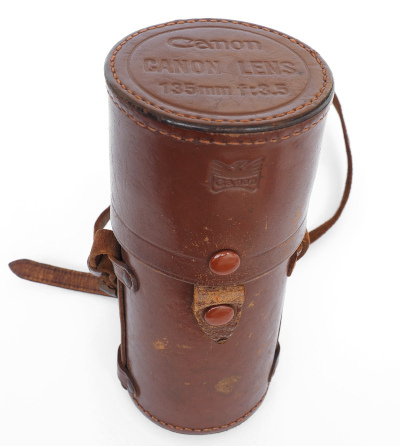

The last two are late 135 mm cases for the black alloy version of the lens, the brown introduced with the lens in April 1958 and the the black in January 1961. They are the same style as the late 35 mm cases and don't store the viewfinder.
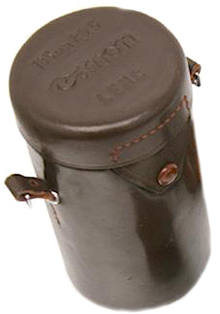
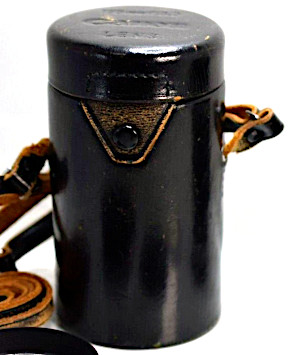 (Web images)
(Web images)
The 35 mm cases start with an early Serenar f/3.5 case from most likely 1950 (this case still has MIOJ marked on the bottom and the lens was only released in March 1950). This case stores the viewfinder above the lens like the longer focal lengths above. Next is a Serenar f/2.8 side by side case with lens and viewfinder stored next to each other (note the <EP> mark above the latch) and a Canon version of the case, both closed and open. The fourth case is a late brown case that no longer makes provision for a viewfinder and was presumably supplied without it and the fifth one is the final version in black. Peter Kitchingman dates these types to the beginning of 1957 but doesn't mention the brown for the f/2.8 version, going straight to black, so it may belong to the f/2 version lens which stayed brown till quite late:

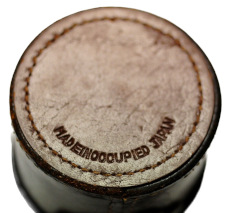
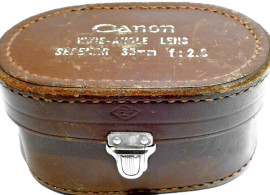
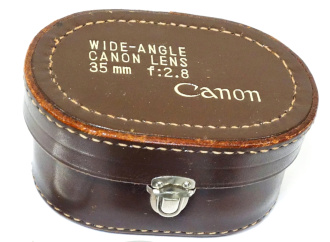
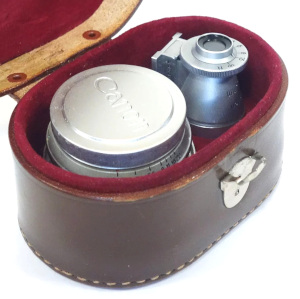
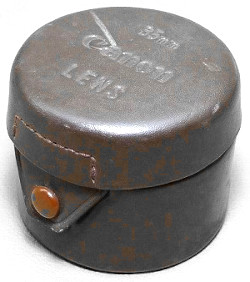
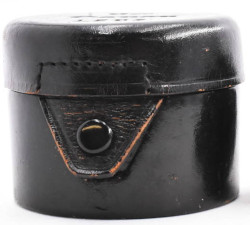 (Web images)
(Web images)
In 1964, Canon released its 19 mm f/3.5 lens and reverted to earlier practice by including a matching viewfinder in a side by side style lens case:
 (Web image)
(Web image)
Canon Flash System
Before attaching a flashgun to a camera, it is necessary to understand how the flash synchronisation works and what the limitations are. The Canon options are more complex than they might at first seem. Typically, Canon used high shutter speed synchronisation (FP sync) for FP bulbs, slow shutter speed synchronisation (M sync) for M and F bulbs and X sync for electronic flash. In some user manuals, M sync maxed out at 1/8 or 1/15, in others at 1/125 and even 1/250 (Canon VT and Series VI models). As an example, below is my summary of the flash sync options from the Canon 7s user manual:
“FP sync from 1 to 1/1000 plus B and T, except 1/30. M sync from 1 to 1/15 plus B and T, also from 1/60 to 1/250 where only the central part of the picture is necessary. F bulbs 1 to 1/30 plus B and T. Electronic flash at X, B, T and 1 to 1/30 positions”
There are summaries for each of the relevant models on the main Canon page (under the first table for each model) but it is recommended that for flash use, the appropriate camera manual be sought out. Manuals for most sync'd models are available from one or the other of the sites in Links to the Good Stuff. Notable exceptions are the Canon II-F (there is a Canon addendum included in the II-F section) and the Canon IV-Sb2 and its derivatives, however, the tables and notes in the late Flash Unit Y user manual further below provide a guide to both these and the earlier models.
For convenience sake, it is easiest to break up Canon's flash systems into a number of groups. First, there were flash units for unsynced bottom loading models, which were largely overlapped by the second group. Second, there were flash units for the rail mount models. Third, there were flash units for the hinged back bayonet mount models. My choice is to only focus on bulb type units in those categories and then consider Canon Speedlights/Speedlites for both rail and bayonet as a separate fourth group because of similarity and lack of detailed information. I have also added a fifth group which is a brief overview of both a bulb type flash and two more modern compact Speedlites for the Canon 7s which did away with Canon's proprietary fittings.
I am a big fan of Canon's flash systems. Anyone familiar with Leica's flash contraptions before it finally added flash sync to the Leica IIIf in 1950 will appreciate the simplicity of the Canon solution for unsynced cameras, although the long D cell battery pack added to the bottom of the camera looks both ungainly and handles accordingly.
To me, the rail sync solution was genius. In 1950, there were multiple connectors and connection methods in use in various countries and the coaxial 3 mm PC sockets didn't exist by that name, if at all. The 1951 Synchro-Compur is the first use of the design that I am aware of. The “P” in PC stands for “Prontor” and the “C” stands for Compur, two famous German shutter makers by then both owned by Zeiss. It wasn't until 1953 that Zeiss standardised the design of the connectors on both its brands using the “PC” nomenclature and it took a number of years before it became almost universal.
It also has to be remembered that the main use of accessory shoes was accessories which for a rangefinder camera meant most commonly, accessory viewfinders. Shoe mount flashguns were available, e.g. the Minolta 35 had debuted in 1947 with both a shoe mounted flash gun and hot shoe sync. And there was also Canon's own B series units for unsnynced models. However, more serious flashguns and probably most professional units, which Canon certainly saw their's as being, were bottom mount on usually some type of base plate bracket. None of them ever feel really secure, although the early Nikon type was probably the best of them. On the other hand, the Canon Flash Units X and Y are completely secure and stable, are more compact with the camera and easier to hold without bracket bits getting in the way. They are very fast to attach and remove and the hot sync built into the rail means that there are no cables to bother with. Simply a better solution for 1950s photographers, although I accept that it's a bother for anyone wanting to use modern electronic flash these days, mainly because the required accessories are hard to find. Also, the rails can be annoying for anyone that didn't/doesn't use flash.
The change to bayonet mount was forced on Canon by the 1956 Canon VT and subsequent models with hinged opening backs. I don't feel that these are as good to hold with an original flash mounted as the rail models but they are still quick and secure and it is possible to use flash with an accessory finder attached. Plus the mounts are less physically and visually obtrusive. The hot bayonet mount doesn't have to be used, simply mount a generic flash in the accessory shoe and plug it into the PC socket inside the bayonet - the best of both worlds.
Note, metal bodied bulb type flashguns from the unsynced B-II to the rail mount Flash Unit Y are all serial numbered, as are some other parts including e.g. the Flash Unit X Synchroniser and some Unit X flash heads. Earlier flashguns are not numbered. The serial number ranges for each of the flashguns start with similar low 4 digit numbers and tick over to 5 digits, the Flash Unit Y becoming significantly higher because of the larger number made.
For Unsynced Cameras
These are the “B” series flash units, all featuring approx 5" reflectors (135 mm). The Flash Units B, B 1, B-I and B-II are designed for using D cell batteries only. Although the B has more basic features, all four units are very similar in appearance and operation. The B and B 1 user manuals are available for download further below and the B-II manual is available from Flynn Marr. Each one has a separate camera bottom mounted tubular chromed brass battery case for two D cells. Except for the B, a provided short extension can be added for a third cell for firing “three or more flashbulbs” (B 1 instructions), i.e., main and two or more sidelights. Each can use Medium bulbs, i.e Edison Screw (ES) base, but was supplied with a “Midget Bulb Adaptor” for bayonet mount bulbs and the supplied test bulb.
The B-III is a later, one piece, self-contained battery-capacitor type for bayonet bulbs only but operates much the same way. The B to B-II operate by cocking the lever on the photographer's left, the B-III by squeezing the two levers at the top of the back, and when the lever on the right over the shutter button is pressed (the “trigger”), the flash fires and the bottom pad of the lever (the “hammer”) strikes the shutter button after the correct delay.
Interestingly, the quoted shutter speed sync range varies quite a bit; 1/60 to 1/500 for the B, 1/40 to 1/500 for the B 1 and 1/60 to 1/200 for B-II and B-III (B-II instructions and B-II and B-III exposure guides). Unlike the rail mount model X and Y flash units from a similar time, the B series didn't offer a variable delay adjustment so the flash units were limited to speeds which would successfully work with most flash bulbs of the day.
Flash Unit B
The B is extremely hard to find and I suspect was only made in quite limited numbers. It's the only model for unsynced cameras that clearly predates the release of the rail mount Flash Unit X as that and the B's successor are from a similar time (see further below), i.e. the B is from sometime in 1950.
Even so, there appear to be two versions. The first flash unit, almost certainly older, only featured the “Canon” engraving without the model name, however, its carry case is marked “Flash Gun Type B” (future models to be called “Flash Unit”). My example of the second version, found with an instruction sheet, adds “Flash Unit - B” below what looks like a slightly smaller Canon name. It also includes an updated Midget Bulb Adaptor, but I suspect that is not original, see 3. below, otherwise it appears identical:
The main differences of these two compared to the subsequent B 1, B-I and B-II models are:
1. The B has three equally spaced coaxial connector sockets on the battery case for choice of “convenient” (per the instructions) location of the flash head coaxial plug which features twisted pair wiring. The flash head leads of later models are plaited and feature a three pin plug and there is only one three pin socket on the battery case as the position of the battery case can be adjusted with a lock nut.
2. Unlike the B, later models offer the ability to add additional sidelights, likely as a result of the development of the Flash Unit X. To support this, their battery cases feature 2 x 2 rectangular prong sockets, one each side of their three pin socket for the flash head.
3. The bulb ejector button on the flash head of later models is not yet present on either the first, or second, B. Whilst the ejector lever on the Midget Bulb Adaptor is not yet present on the first B, it is there on the second, but to me, the adaptor seems more likely to be a replacement from a later B-I or B-II than the more logical following B 1 type, so probably not original.
4. The battery case extension tube of later models is not included because there is no provision for connecting sidelights yet.
Example without model name. Note, instead of one pair of bayonet slots and an eject lever to release its bulbs, the Midget Bulb Adaptor has 3 pairs of slots providing 6 segments to friction grip the bulbs:
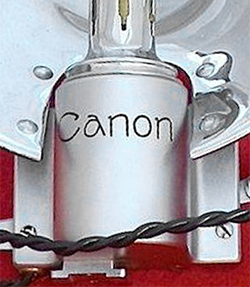 (Portion of forum image posted by Peter Kitchingman)
(Portion of forum image posted by Peter Kitchingman)
With model name:
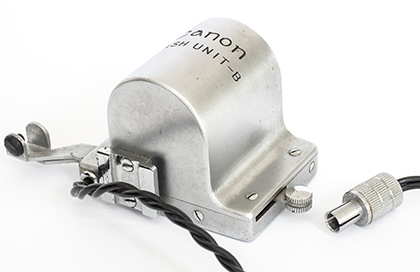
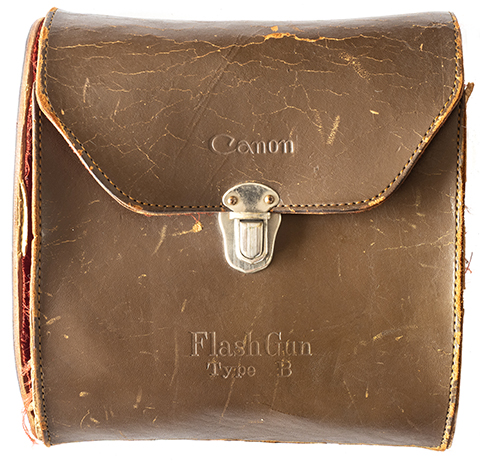
The closed cases look similar to the B 1, B-I and B-II cases, but internally, the components are laid out horizontally. Unlike later cases, the strap from one side of the case to the other is to support its shape only and is normally riveted permanently at both ends. Mine is torn at both ends and my attempt to use tape to secure it for the photo was not very successful. The direction of the fine ribbing of the velour lining material is also horizontal whereas it is vertical in the later cases and the pocket on the lower flap is unique to this model:

Note, I believe that the Midget Bulb Adaptor may be from a later B-I or B-II:


Mounted on a Canon II B camera, ready to use:
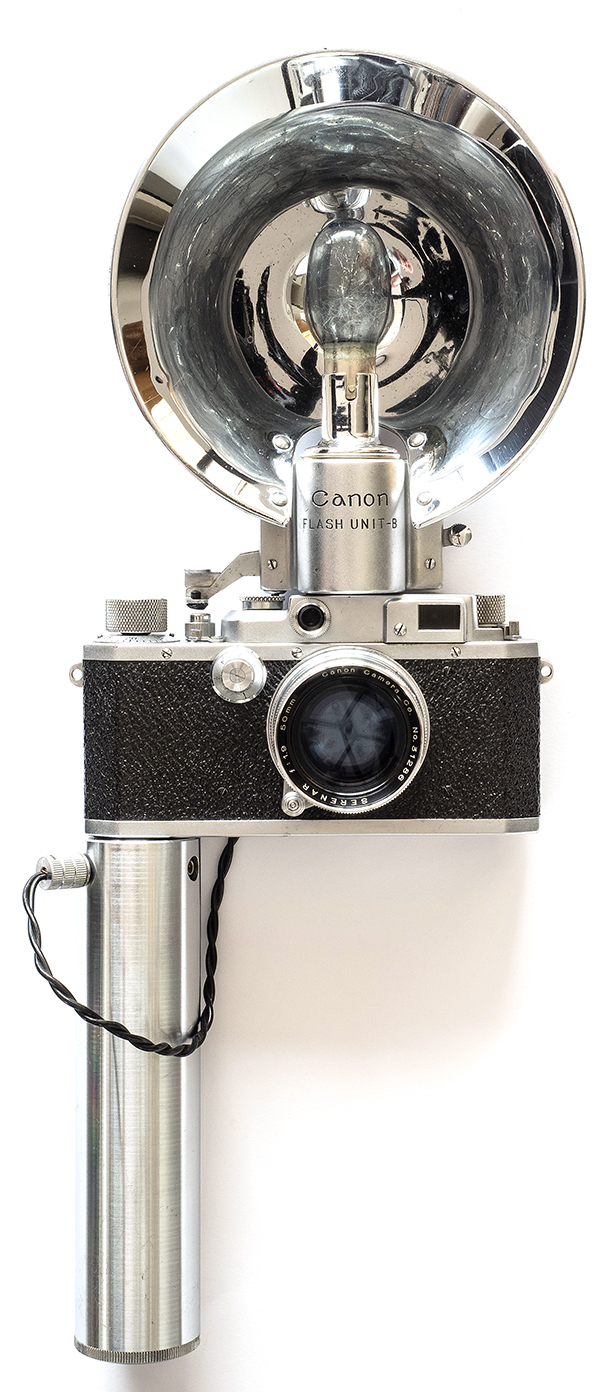
Two comparisons between B and B-I (much the same as B 1 and B-II). The first is the battery cases. The B-I adds the sockets for sidelights and the lock nut for adjusting case rotation and is about 18 mm taller, including the lock nut, than the B:

The second is between the carry cases. They are the same width, but when standing up, the B-I case is about 20mm taller. They also have different side profiles:
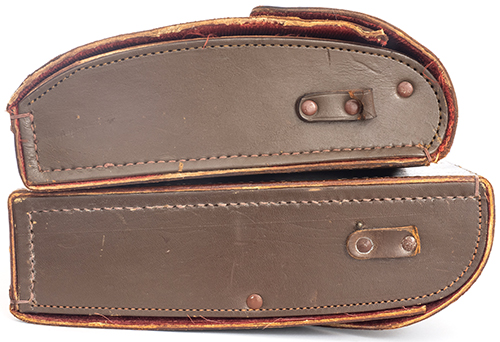
Found with the second flash is a typewritten two page instruction sheet in English on fragile rice paper which may well be 75 years old (plain white paper inserted between for scanning). Whether this served as the English instructions at the time, or it has been copied from the original, the wording seems to be in the authentic Canon style with a healthy dose of marketing thrown in, somewhat similar to the B 1 user manual, but not the same. Note, there is no Canon letterhead, date or anything similar to help authenticate it and by this time, Canon was already, producing user manuals and brochures in English, however, it is typed on similar stock to the example with Canon letterhead in the Flash Unit X section. Also found with it is part of the packaging torn from a vintage packet of Sylvania FP26 flashbulbs with the exposure table and an old hand drawn exposure table in English with more wide ranging information for different bulbs etc. Together with being acquired from the USA, its history is perhaps consistent with a US military exchange store bought item:
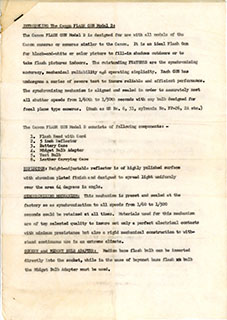 (click on instruction sheet for PDF version)
(click on instruction sheet for PDF version)
Flash Unit B 1 (or B-1)
The B 1 uses the Arabic numeral “1” in the name and no hyphen between them on the flash body (written as “Flash Unit - B 1”), but it is there in the user manual and on the ever-ready case. Below is the complete set as supplied, including the extension tube to add an extra D cell when using two, or more, sidelights. The ability to fire sidelights is new. There is now a knurled locknut on top of the battery case so it can be rotated to any position convenient for the plugs (see B-I model below). Note the new two rectangular prong extension sockets on the D cell battery case (not labelled yet) and 3 pin flashgun to battery case plug with plaited wiring and also the flashbulb/adaptor ejector button on the flash body and ejector lever for bayonet bulbs on the Midget Bulb Adaptor:

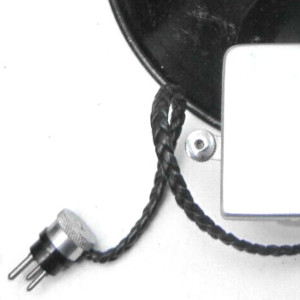
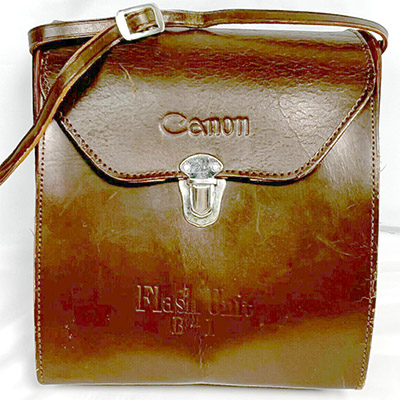
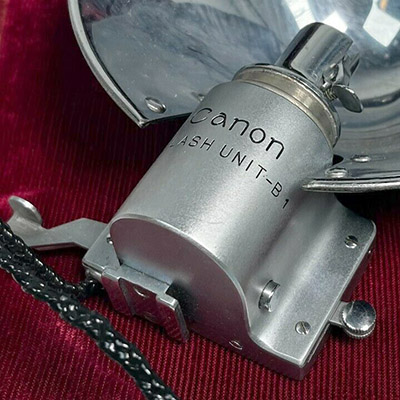
(Detail from larger web images)
The great majority of examples of the B, B 1, B-I and B-II flash units are found with leather kit cases similar to the above and almost certainly these, and the Flash Unit X until quite late, were supplied with the cases as standard.
The date on the back of the user manual is December 1950 which is one month later than the first user manual for the flash sync'd Flash Unit X produced in time for the trial series Canon IV (what Peter Dechert originally called the “Canon 1950”), see Flash Unit X below. I suspect that the B 1 updated the B based on development of the X.
Below left is the B 1 packing slip listing the set contents and on the right, the user manual. Both have the December 1950 date (note, the manual is for the B 1, even though Canon's usage on the manual makes it look like the following “B-I”):
.jpg)
 (Click on packing slip for larger image, click on manual cover for PDF of manual, the original of which is a double sided 3 panel sheet)
(Click on packing slip for larger image, click on manual cover for PDF of manual, the original of which is a double sided 3 panel sheet)
The side lighting unit in the B 1 user manual is simply referred to as a “Canon”, but given that the B 1 and the Flash Unit X seem to have been released at a similar time and the addition of similar extension sockets, it is almost certainly the Side Lighting Unit, Model X, as named in the B-II user manual.
Flash Unit B-I
The B-I uses the Roman numeral “I” in the name. To the casual observer, it looks the same as the B 1, but according to knowledgeable collector, Peter Kitchingman, includes a number of small improvements including to the Midget Bulb Adaptor - the B 1 adaptor body featured a groove for the release mechanism to grab, the B-I is smooth and relies on a pressure plate and the lever on the adaptor is a little different. The B-I battery case extension features 4 threads instead of the earlier 2 and the semi-cylinderical part of the flash head now has two screws in the bottom. Two subtler changes are a slight change in the position of the eject button on the body and a slightly larger diameter for the knurled head of the power plug:
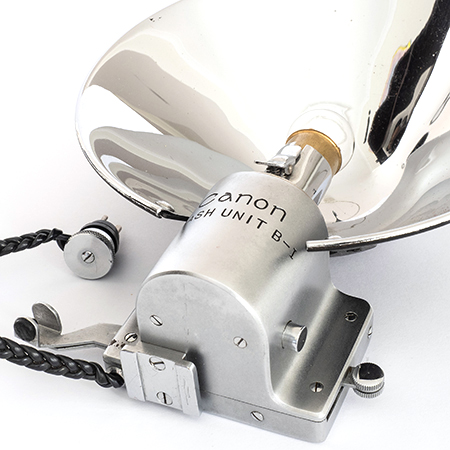
Below is the flash head with the adaptor and test bulb inserted and the top of the battery case with the extension sockets now engraved with “EXT.”, also note the knurled “lock nut” first introduced by the B 1:

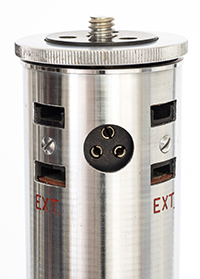
I have found at least 5 examples in cases marked “B-1” still, including my example, and only one in a case that could be marked “B-I” but it is very hard to be certain either way and I have gone from thinking that it is, to is not. My B-I set in a “B-1” marked case, only the battery case extension tube is missing:
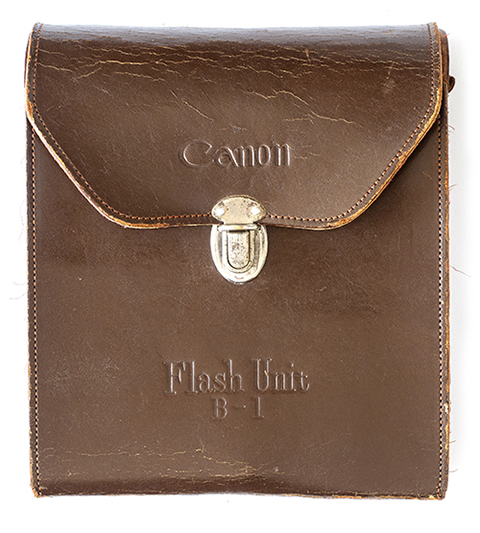
The securing strap across the flash (case marked B-1) is two piece with a centre press stud, same as the later B-II case. The case for the B 1 flash above is one piece with a press stud on the right end. Generally, B 1 cases for B 1 flash units are single strap types and some B 1 cases for the B-I are two piece. Also, my case has an oval backing plate for the saddle, more like the B-II, but the cases for the B 1 and most other, but not all, B-Is have a shape similar to the B case. I'm guessing that the oval style was a fairly late change.
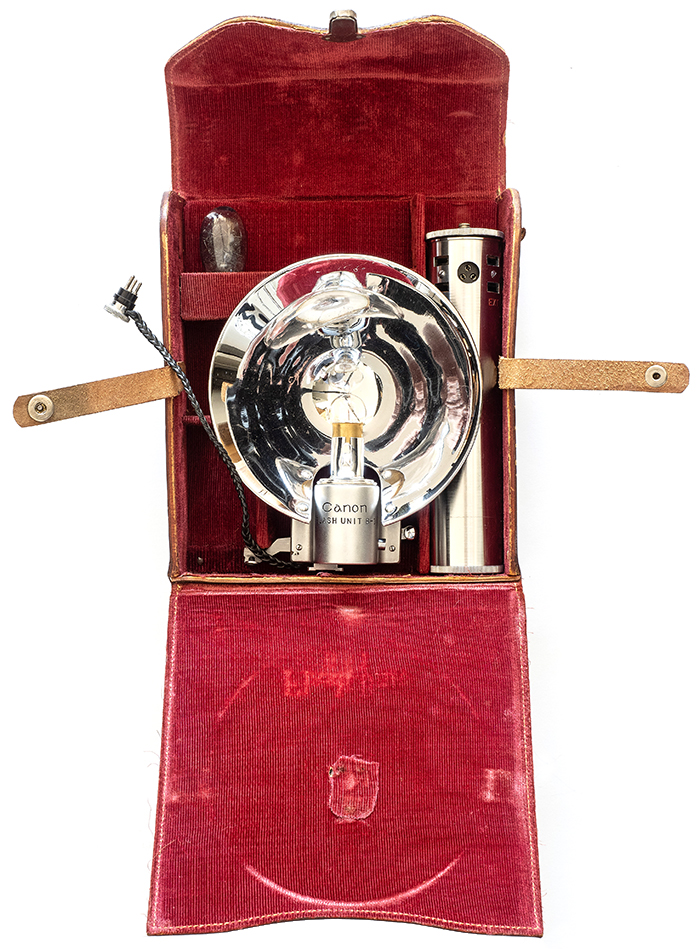
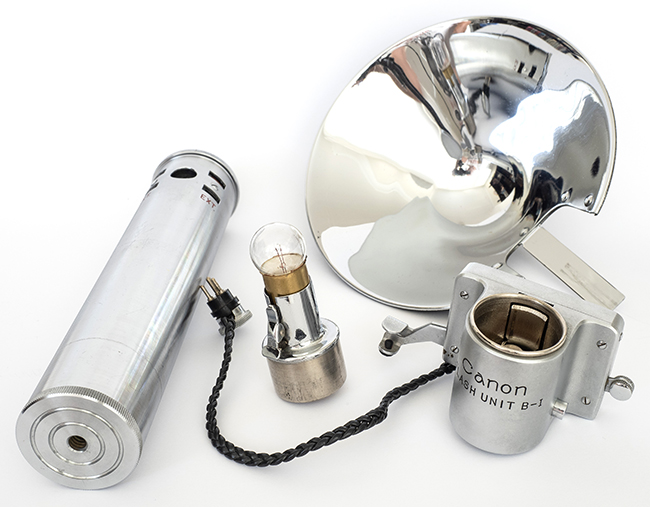
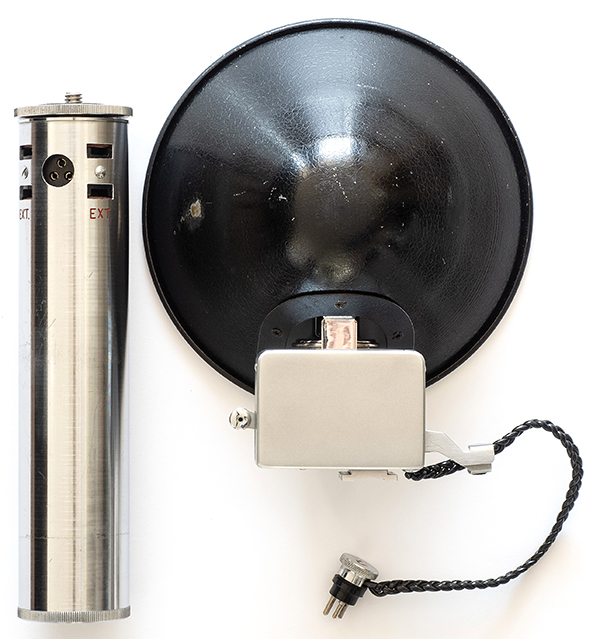
Mounted on a Canon II B camera, ready to use:
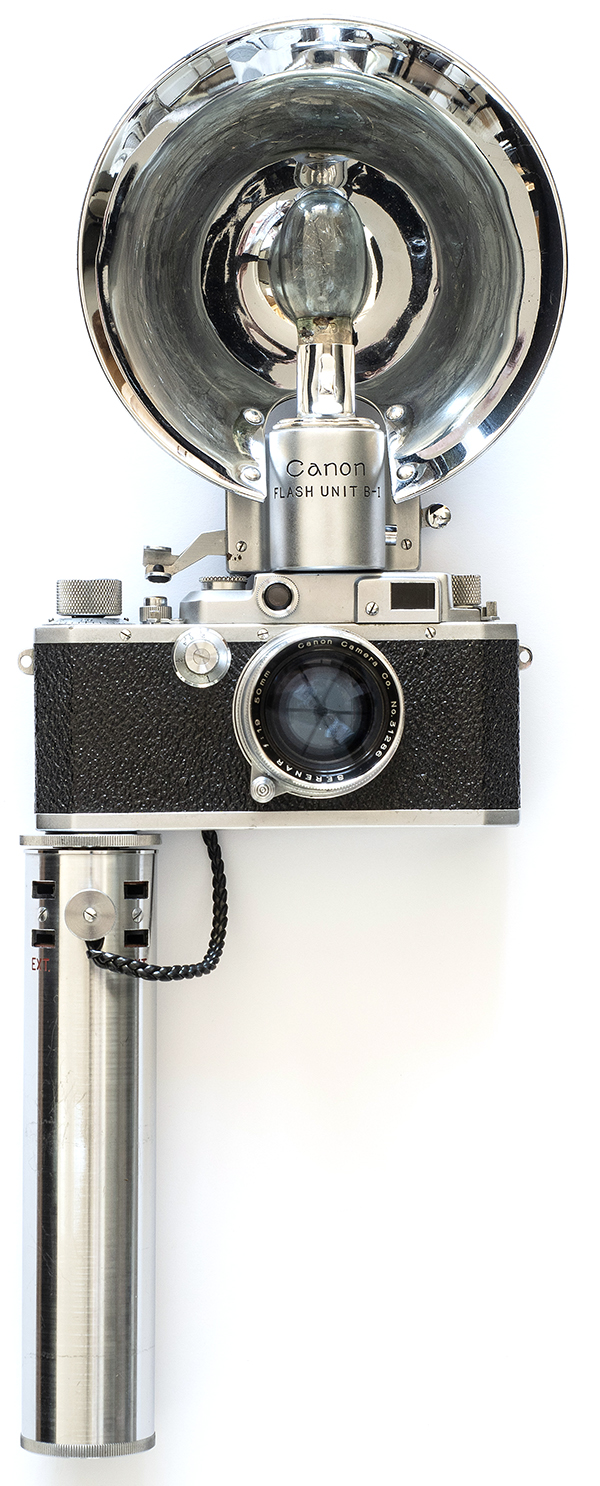
Both ends of the B-I case extension missing from my set:
 (Web images)
(Web images)
I have yet to find a dedicated user manual, if one exists, the one above that looks like it is for the “B-I” (mine above, was bought separately to my B-I) is originally for the B 1 (see flash name marking on photo inside and battery tube without “EXT.” markings) and is commonly found with that flash, however, operationally they would be identical. I have found a complete B-I set, similar to mine, with the B 1 manual and I think that there is a reasonable chance that the manual may do double duty and wasn't updated. The B-I is another rare example and couldn't have lasted long given the previous B 1 user manual date of December 1950 and a reference already to the new B-II flashgun in a March 1951 Canon III brochure.
Flash Unit B-II
Similar to earlier types, standard B-II kit case and contents (the body and reflector have been placed upside down and hence the case is shown upside down, the Midget Bulb Adapter is missing):

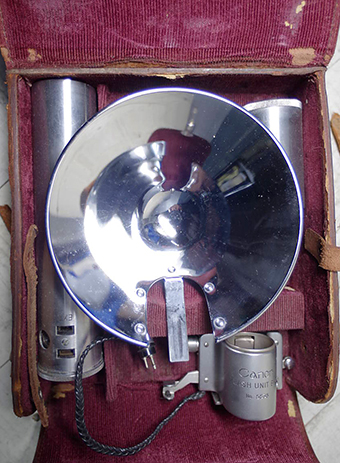
(Web images)
There are at least two user manual printings for the B-II, dated August 1951 and December 1952, but as noted above, it already appeared in a March 1951 Canon III brochure. The user manual, 1952 version available from Flynn Marr, helpfully tells us that its new features include provision for using a self-timer (or cable release) via a new shutter button on the right side (requires use of a Canon self-timer, or “Leica nipple” connector/adapter) and a guide number table on the back of the body:
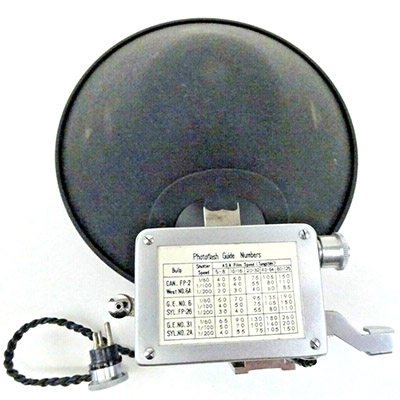 (Web image)
(Web image)
The user manual also demonstrates the connection of the sidelight designed for the rail mount Flash Unit X. However, one change not noted in the manual, nor is the feature explained, is the addition of a two prong socket on the rear of the battery case marked “Test”, presumably for the “Flash Tester” introduced by the Flash Unit X. Front of battery case on left, rear of case on right:


(Web images)
The B-II also introduced serial numbering for the first time with the number under the model name. The numbers in my database run from 348x to 1053x.
Flash Unit B-III
This is the final model of the unsync'd flashguns. Pacific Rim has a downloadable Japanese language user manual dated October 1953. Whether this is from near its release date, or a later printing, is unknown. The featured camera in the user manual is named as the Canon II-D and it has a Serenar 50 mm f/3.5 lens mounted - for this lens, the name change to “Canon Lens” occurred in December 1952. The B-III continues to appear in 1955 and 1956 Canon product brochures.
The B-III looks different because it is mainly a rethink of the power system, replacing the the D cell battery case tube of the previous models with a battery capacitor system incorporated into the main body of the unit, using the same capacitor as the battery capacitor version of the rail mount Flash Unit Y. Unlike earlier and rail mount models, there is no provision for connecting extension units, or using ES bulbs:
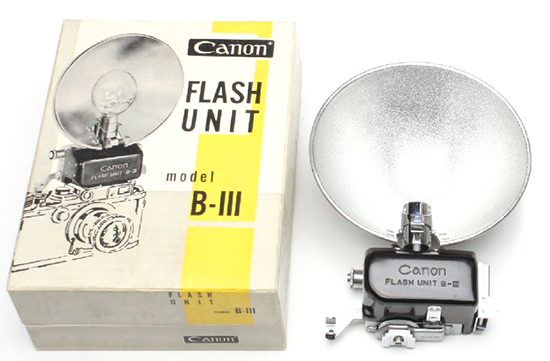
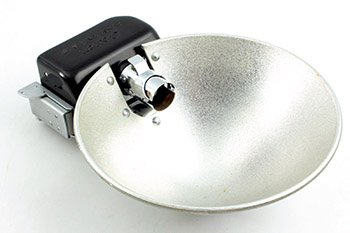
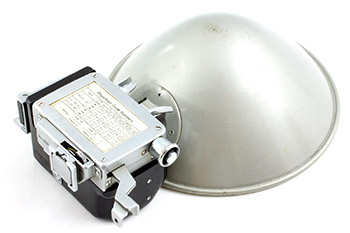
(Web images)
The serial number is located underneath, next to the mount. The numbers in my database run from 215x to 1055x.
Below left, power supply compartment, only the capacitor is present, not the 22.5 volt battery. On the right, demonstrating the unique fold-out accessory shoe for mounting accessory viewfinders (image mimics user manual photo):
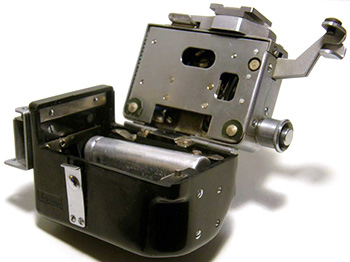

(Web images)
This Japanese version of the user manual, copied from an auction site, is a double sided foldout sheet, unfortunately the resolution is too low to read/translate:

The presentation box replaced the standard carry case found with earlier models. Like the Model Y box, the B-III is accommodated on its back on a fitted yellow satin lined insert:
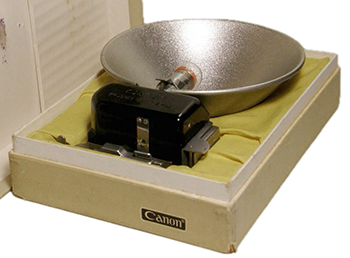 (Web image)
(Web image)
However, a high quality, hard leather carry case was offered as an optional accessory (I have seen one only). The March 1955 Canon Product Guide has this to say about it (page 34):
“CARRYING CASE for above Flash Unit, B-III Catalog No. M-24109
Top-grain reinforced cowhide leather carrying case for Canon Flash Unit, Model B-III. Velvet lining, adjustable shoulder strap with shoulder pad.”
For Canon Rail Mount Cameras (bottom loading)
Flash Unit X
It might be assumed, and as claimed by Canon, that this arrived with the release of the 1951 Canon IV, first Canon mainstream model with flash sync and side mounting rail, however, it debuted with the model Peter Dechert calls “Canon 1950” (an earlier trial series for the forthcoming Canon IV which made it to the US in small numbers). The camera and flash are pictured in an ad by US importer C. R. Skinner in the February 1951 edition of US magazine Photography (camera called II C by the importer because it was unnamed as yet by Canon and followed the II B). In that context, the date on the back cover of the early user manual further below, November 1950, suggests that the flashgun was ready in its final form well before the Canon IV was officially released (Peter Dechert says produced from April 1951).
In fact, development of the camera's flash sync mechanism and rail mount may have already begun in 1949. In the Canon II B section, I mention that one of the earliest found Canon II Bs, serial number 25002, was a Canon testbed for developing both the mechanism and rail mount. Presumably, prototype flashguns were being developed too.
User manuals and the late box further below describe the flashgun as “Flash Unit Model X” whereas the bottom mounting bracket of the actual flashgun calls it “Flash Unit Main” - that is because it is the “main” flash unit and not the optional sidelight. That also causes a lot of seller confusion these days and makes Internet searches more difficult. The leather kit carry case, similar to the B series ones, combines both names into “Main Flash Unit Model X” (based on significant numbers found, like the earlier B series before the B-III, I suspect the X units were supplied with these until the Y style presentation box was introduced near the end of their production):
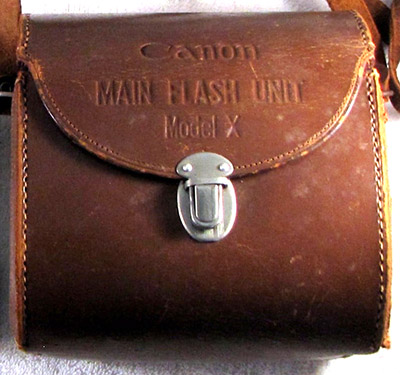 (Web image)
(Web image)
Select pages from November 1950 user manual:
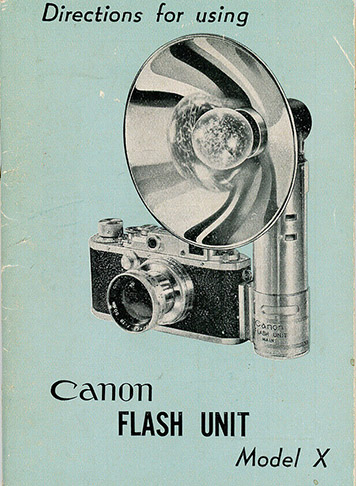
Some optional flash system components. The Self Extension Adapter is also an option with the Flash Unit Y. It mounts to the camera's rail in place of the flash and enables off-camera flash with an extension lead:
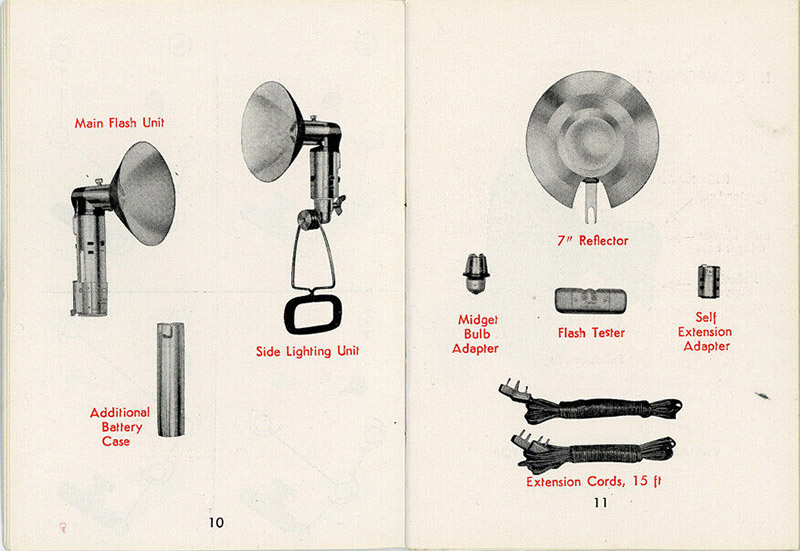
Flash Unit X with D cell extension case and 7” accessory reflector for use with large ES flashbulbs. Note the November 1950 date on the back cover:

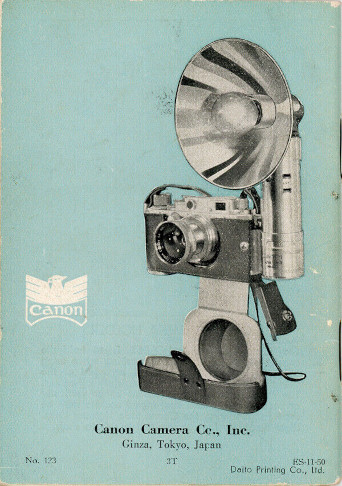
Whilst the body/battery case looks like it is meant for D cells, it is but it isn't. The upper part of the tubular body contains the connector sockets and internal flash circuits, in standard form, the lower part contains a cylinderical holder for four penlight (AAA) batteries side by side. The accessory body extensions allow the use of D cells instead of the penlight pack. Below is a typical black plastic model X penlight battery holder:
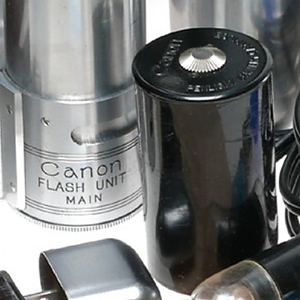 (Web image)
(Web image)
It is unclear whether a battery/capacitor pack, an option with the later Flash Unit Y, was ever offered. There is certainly no evidence earlier on but the boxed second last model X in my database, 9909, was sold with one. Whether a Canon option, or an addition from a model Y by an owner, is not known but there is a late 1952, or early 1953, Canon ad for a “Flash Unit model X-K” with what might be a battery/capacitor pack, see “Flash Unit X Without Micro-Sync” further below.
There is also some circumstantial evidence in a 29 May 1953 letter from US Canon distributer Balfour, Guthrie & Co., Limited, in response to a customer enquiry. The letterhead and relevant section are below. Note that by the time of the letter (which also refers to the customer's IV-S2 camera), the Flash Unit Y was almost certainly released already with its battery/capacitor pack option, however the evidence further below is that the model X continued to be offered into 1954 and therefore it is possible that it also inherited the option. Physically, there seems to be no reason why not:

(Web image)
Whilst the letter says that “it is regretted that we do not presently have available the B. C. Flash Pack“, the letter forms part of the original owner's collection of Canon rangefinder gear and matching documentation, including serial numbers, and included is a typical Flash Unit X with Micro-Sync, mid-range serial numbers (last in my database with a black reflector back) but with a “Canon Capacitor Cell” (the aluminium housing) and capacitor instead of the usual black plastic penlight holder.
The letter also offers some packaging insights that I have not seen anywhere else, noting again that this is from after the Model Y release. Also, the packaging may be US market specific. The “Model X(M) Flash Unit” appears to be a bare bones model without penlight battery holder, or presumably battery/capacitor pack. The X(A) adds the penlight holder and the Micro-Sync and the X(B) includes everything so far plus an additional D cell battery case, an extension cord, a flash tester and a leather case for the full kit. The X(B) is the type of kit and carry case that is commonly found with cased types so I'm guessing that was typical earlier in its life:

(Web image)
The flash head and 5” reflector is removable on the Model X to allow for direct vertical mounting of ES press type flashbulbs with a 7” reflector, as on page 50 of the user manual above. Peter Dechert's book has two photos of the flash unit, one mounted with the 7” reflector for ES type bulbs and one displaying “all parts” including optional flash tester and importantly, the plug-in synchroniser. However, his example has an optional vertical bayonet mount flashbulb head for mounting on top of the body called “Bulb Adapter”, presumably the “Midget Bulb Adapter” referred to in the user manuals, and no standard 90 degree head shown, i.e. it is not a typical unit. However, I have my doubts as to whether the synchroniser was part of the original design.
The later, more refined, Flash Unit Y features a built-in synchroniser, i.e. variable delay, whereas the X typically features a separate synchroniser, called “Micro-Sync” by Canon, which plugs into the side of the main body. The idea behind the synchroniser on the flash unit is similar to the variable delay Leitz built into the flash synchronised 1950 Leica IIIF body. At the time, different brands and types of bulbs had more divergent delays and burn times. However, the Micro-Sync doesn't feature on the November 1950 user manual cover photos, or the inside pages I have access to. On page 10, there is a left front view which is very side on - the tip of the eject button on the back is visible (like the right front view of the side light) but there is no coaxial connector socket for the Micro-Sync (the relevant areas are not visible in the C. R. Skinner ad photo mentioned earlier).
Another thing that makes me believe that the Micro-Sync is a later addition is that Canon issued a three page letter, with attached photos, explaining the purpose of the Micro-Sync, how to mount it and operating guidelines. The sort of thing that normally belongs in an instruction manual. Whether it was intended for dealers, or users, is unknown. I'm aware of three such letters, all unfortunately undated, two offered for sale and the other in the Pacific Rim Camera Canon Reference library, the first page of which is shown small below:
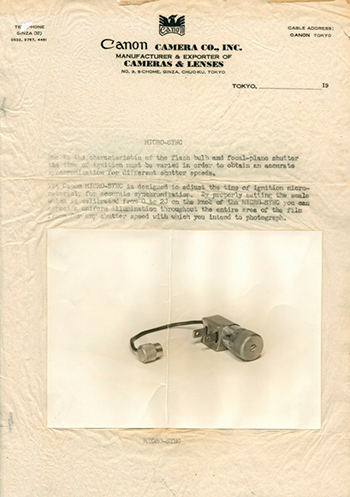
It is a fact that there are three Flash Unit X bodies in my database without provision for attaching the Micro-Sync, but they are a complicated story so I am going to deal with them as if they are a separate model, “Flash Unit X Without Micro-Sync”, further below.
Typical Flash Unit X Micro-Sync showing its rectangular pins for plugging into the right rear socket and the inside of the connector plug:
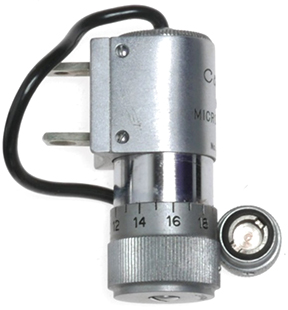 (Detail from larger web image)
(Detail from larger web image)
The synchroniser is easily lost. It's not uncommon for Flash Unit Xs to be offered for sale as a bare handle/head/reflector assembly, i.e. workable but likely incomplete as was this one below:
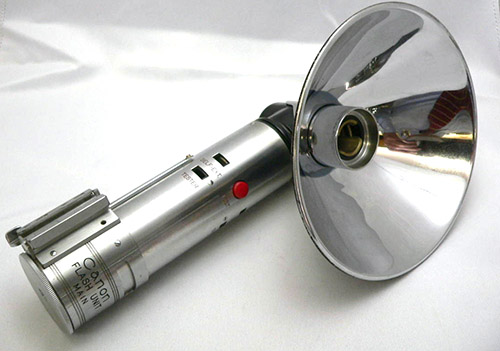
The flash head is adjustable for angle of coverage by loosening the thumbscrew and sliding the reflector mount forward or backward:
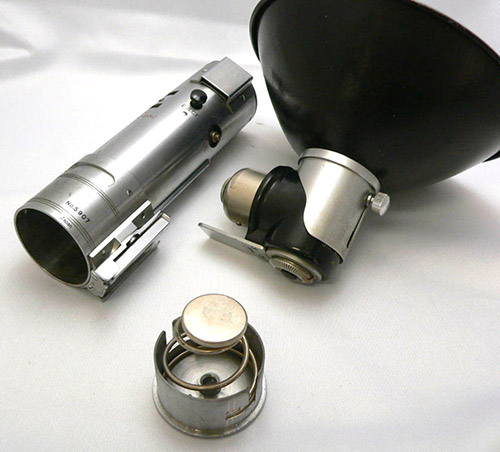
(Web images)
This presentation box replaced the earlier standard carry case quite late in the Model X's life and I have found it only with the last two X units in my database, 990x and 114xx (apart from the 1954 box in the Flash Unit X Without Micro-Sync section below). Whilst the construction and graphic design is similar to the B-III and Y boxes, it is more cube shaped rather than flat and there are no fitted inserts or lining material, relying on internal boxes and packaging instead. Also, unlike the other two, it still features the Canon Eagle logo. Logically, this one was first to arrive and these features probably confirm that:
 (Web image)
(Web image)
Below is a downloadable late user manual with August 1952 date on the back cover. Note, both the box and manual show synchroniser mounted:
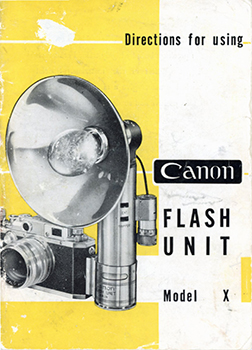 (Click on cover for PDF manual)
(Click on cover for PDF manual)
The Model X side light, simply marked “Side Lighting Unit”, features a spring mounting clamp and is similar to the Flash Unit Y version further below except that like the Main units, the head of the X (same head as Main unit) is removable for mounting the 7" reflector whilst the Y head is fixed, and the X body is a little taller (see also both early and late user manuals above). Front and rear view, minus the reflector and extension lead weirdly plugged in upside down from socket to socket:
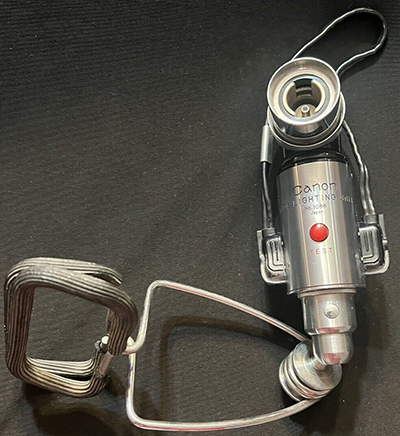
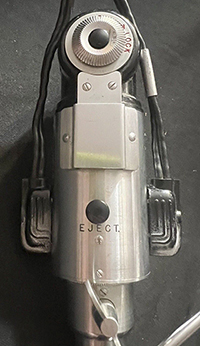
(Web images)
Below is a Canon flyer, printed in March 1951, found with an unsync'd Flash Unit B-I. The Side Lighting Unit is shown with both 5" and 7" reflectors mounted:

Whilst also named as the side light in the instructions for the unsynced Flash Unit B-II, it is almost certainly the unnamed side light in the earlier B 1/B-I instructions (the Model X and its sidelight were released at a similar time to the B 1 and uses the same connector sockets). Model Y user manuals and 1954 price lists suggest that it continued until at least mid-1954 as the side light for the Model Y before being replaced by the fixed head version.
Flash bodies are numbered on the back, near the base. They are 1093, 1380 and 1428 on the three further below without Micro-Sync provision and range from 310x to 1114x for the rest. As noted earlier, the Micro-Sync units and the 90 degree flash heads, except for late heads, are also numbered (if numbered, on the top between “5 in. Reflector” and “Japan”, although “Japan” is not there on earliest examples of the head, or body). The head number on the earliest body with Micro-Sync, 310x, is 111x and the highest head number is 1101x. Serial numbers are rarely featured in photos and too often, where I have a body number, I can't see the top of the head and vice versa. The pair below are from different sets but appear to be of a similar age:


(Web images)
Flash Unit X Without Micro-Sync
I've already mentioned that the Micro-Sync doesn't seem to be featured in the original user manual, so it follows that I would expect any examples of Flash Unit X bodies found without provision for attaching the Micro-Sync, to be early ones. Yes and no, based on clear, conflicting evidence.
The first found was body serial number 1380 (the ones with Micro-Sync connectors are in the 310x to 1114x range), clearly the earliest at that point. When viewed front-on, most Unit X bodies have one set of rectangular socket pairs on the left front, one set on the right front and one set on the right rear plus a round coaxial socket on the left rear for the synchroniser connector to plug into. The right front sockets are labelled “Ext.” and “Tripper” and the right rear are labelled “Ext. Micro-Sync” where the synchroniser body mounts. The round left rear connector socket is labelled “M.S.”. On the body of 1380, both the right-side socket pairs are simply labelled “Ext.”, but more significantly, there is no coaxial rear socket for the Micro-Sync connector. First image shows 1380 body without the socket (normal position is to the picture right of the black eject button), second shows it with right rear (from the front) sockets marked “Ext.” and third image is of a later Flash Unit X body with Micro-Sync connector socket and right rear sockets marked “Ext. Micro-Sync”:

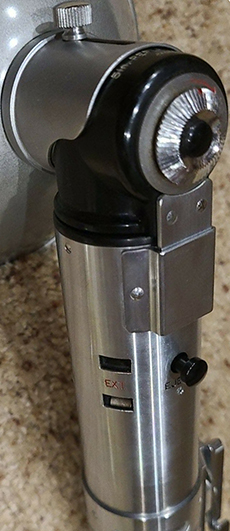
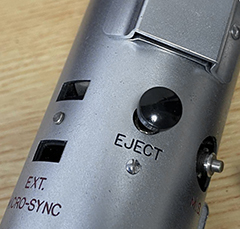
(Detail from larger web images)
Note that 1380 features a shiny chrome body, like the next earliest examples, but the later majority appear to be more of a satin chrome, like the example next to it.
That seemed to be clear cut support for my theory. For full disclosure, I noted that 1380's reflector with grey hammertone painted back was almost certainly a later replacement together with the flash head. I expected the original reflector to have been painted black like the one further above and as it also appears in both the November 1950 and August 1952 user manuals. The latter 3rd, or so, of production is grey. Also, I noted that the head is marked “Japan”, whereas there is no such marking on the body - typically, the marking is not there on either early bodies, or heads, but is on both for later ones. On the other hand, most examples have separate serial numbers for the head and the body, this head didn't have a serial number, just like those that belong to the last two late bodies in my database. Job done, or so I thought.
First, there is another interesting oddity with 1380, as it turns out, not unique, although it is probably totally irrelevant to the rest of the story. The 1st photo below shows that the serial number ends just to the left of the “Canon Flash Unit Main”. The whole lot is twisted to the right (viewed from the front) so that both the serial number and name are on the right side of the body, clear in the 4th photo. Normally, the name is centred on the front and the serial number is on the back, to the left of the mount. Note, on 1380, there is no gap between the serial number and name for the mount to fit and therefore it is an engraving difference rather than the attachement ring somehow being inadvertently rotated during assembly. The second photo confirms the early serial number and that “Japan” does not yet appear under it. The third photo is of the late head unit featuring the “Japan” marking, but with serial number no longer appearing:
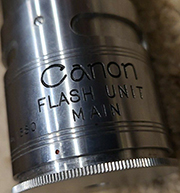
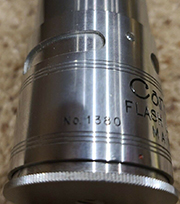
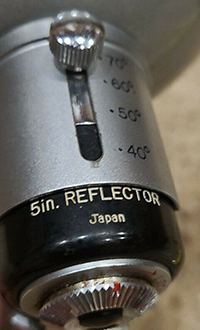

(Web images)
There is one other like it, but before before I provide details, I found another Flash Unit X just like 1380, except without the engraving anomaly. This changes the narrative from someone's fiddling to maybe an offical Canon release.
The second one, serial number 1093, is even earlier. It too has a later head with the same late features, i.e. no serial number but with “Japan” marked, and grey reflector. In summary, what we have is the two earliest bodies by serial number, both without the later “Japan” marking, both with a shiny chrome rather than Satin chrome finish and neither with provision for Micro-Sync but both seemingly retrofitted with late heads and reflectors, i.e. late 1950, or early 1951, bodies with 1952, or later, flash heads and reflectors.
Coincidences do happen, except not in this case. 1093 came with both its presentation box and outer delivery box. I mentioned previously that later Model X flash units were supplied in a presentation box, rather than the earlier carry case, with one pictured further above, complete with a photo on the lid with Micro-Sync mounted. The box for 1093 is almost identical, except instead of a photo, it has a line drawing - there is no Micro-Sync and we can see that the right front and rear sockets, when viewed from the front, are both clearly marked “Ext.” instead of the front being labelled “Ext.” and “Tripper” and the rear labelled “Ext. Micro-Sync”, i.e. it matches the flash body 1093 (and 1380). To me, this box style and graphics is much later than the original user manual and more in keeping with the age of the head than the body. The drawing of the camera on the front features a rigid Serenar/Canon f/1.8 rather than the collapsible Serenar f/1.9 on the first manual cover:
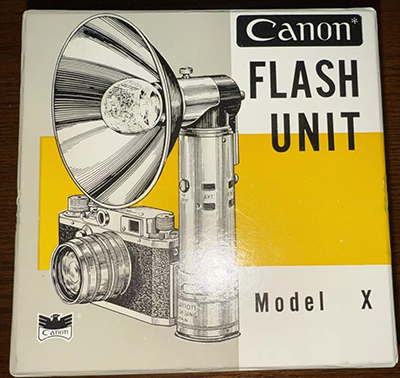 (Web image)
(Web image)
Front and rear views of body and sockets:
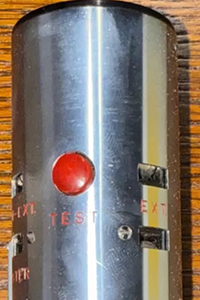
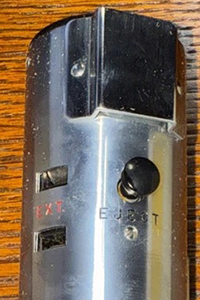 (Web images)
(Web images)
Of course, I could be wrong about the age of the box. But then there is the outer delivery box (both boxes in excellent condition) which, as always, fits like a glove. It has a Canon label that says “FLASH UNIT model X” with a date that indicates March 1954, i.e. well over 12 months after the release of the model Y (found model Y boxes range from September 1952 to April 1956):
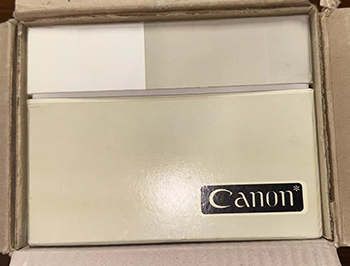
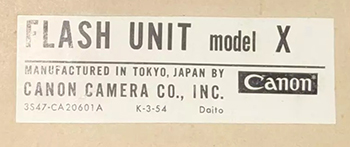 (Web images)
(Web images)
The left image confirms that this is an early body with no “Japan” below the early serial number (clear enough in the original image), right image confirms the flash head's late status by the addition of “Japan”, the omission of a serial number and grey reflector:

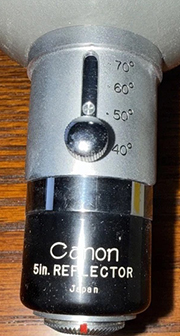 (Web images)
(Web images)
There is now a third body without Micro-Sync sockets, serial number 1428, the highest so far. The body doesn't look like shiny chrome but I suspect that is because of corrosion. There is no reflector, but like the other two, the head is the late type with the “Japan” marking and no serial number. It also features the sideways rotated name engraving of 1380, this must have been a conscious change for a short period before reverting to the earlier style which we now regard as “normal”:



(Web images)
The top half of the Japanese ad below is for the new IV-Sb, with Serenar 50 mm f/1.8 lens still, making it circa December 1952 meaning that the Flash Unit Y must have been in the process of being released. The ad is titled “Two Announcements” and Canon's name and address is at the bottom (Shimomaruko, Ohta Ward, Tokyo):
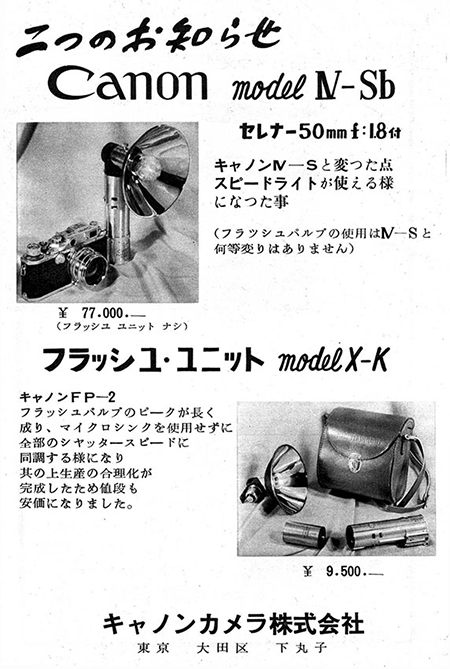
The translated announcement in respect of the flash unit is:
“Flash Unit model X-K
Canon FP-2 The flash bulb peak has become longer and it can synchronise at all shutter speeds without using the Micro-Sync. In addition, the price has become cheaper because production has been streamlined.”
There are some odd things about this ad. The first is the timing with the Model Y in production, if not released (see Flash Unit Y below). Another is the “X-K” name. I have not seen that used before, only “X” by itself. The new Flash Unit Y was called the “Model Y-K” (user manual) when fitted with the battery/capacitor power pack instead of the 4 penlight (AA) batteries (“Model Y-L”), this X may be the same. Note the power pack in the ad is silver, presumably a metal holder for the 22.5 volt battery and capacitor, if that is what it is. Below left is the typical black plastic model X penlight battery holder, below right is the “Capacitor Cell” found with the second last model X in my database, 9909, mentioned in the previous section - the writing on the side seems to match the layout in the ad (unreadable):

 (Web images)
(Web images)
Of more relevance to our early bodies, there is no Micro-Sync pictured.
I initially took the claim, that the Canon FP-2 flash bulb can sync at any speed without using the Micro-Sync, at face value, but could the ad be implying, “if you use the FP-2 bulbs, you don't need the Micro-Sync and therefore we have made the Flash Unit X cheaper by removing it (and maybe the ability to mount it)”? Whilst the Canon FP-2 bulbs do not seem common, they are the first listed flash bulb in the guide number tables on the backs of the B-II and B-III flash units and an open packet of them is pictured at the end of the October 1953 printing of the Japanese B-III user manual.
So perhaps the ad is referring to a budget offering after the Y had been released? Possible but it doesn't explain the early bodies (the serial numbers, lack of the “Japan” marking and shiny chrome bodies have pretty well convinced me of their age) with late heads and reflectors and a new box found with a date as late as 1954. The user manual supplied in the box with 1093 is a typical late one with Micro-Sync fitted. My only thought is that when Canon redesigned the X early on to include the Micro-Sync, they had a supply of bodies left over that they didn't want to use then (perhaps there were serious syncing issues with the earlier flash bulbs), but later, the FP-2 bulbs offered a means of unloading them at a cheaper price than the recently superseded typical X and new Y. Conveniently, there was a ready supply of new Model X flash heads for the Model X sidelight which wasn't replaced by the Y version until at least late in 1954 (see Side Lighting Unit Model Y below).
Given that I have seen a number of early X user manuals for sale, and that they should be far more scarce than the actual flash units themselves, I'm surprised to not have found an original early body without Micro-Sync but with early flash head and reflector. It is possible that these bodies were produced without any being released to market at that time.
Flash Unit Y
Flash Unit Y serial numbers run from 121x to 36359. The first third, or so, seem to repeat Flash Unit X serial numbers which run from 1093 to 1114x (there were a lot more Y than X models made). Both presentation and outer boxes in this period were marked on the bottom with their version dates, like user manuals and brochures - the late Flash Unit X user manual above was printed in August 1952, the earliest Flash Unit Y box I have seen is from September 1952, so the changeover probably occurred in late 1952.
As can be seen from the user manual further below, there are quite a few optional accessories, including universal and TLR mounting brackets, and 10 different combinations of battery numbers/types and capacitors. This one below and another bare handle I own use four side by side AA batteries, or penlight batteries as they were called then, in the short cartridge in the third photo. This seems to be the most common type found. Canon sold it in two basic forms with separate catalogue numbers; when fitted with the Canon 200 mfd capacitor (for use with a 22.5 volt battery), it was referred to as the “Model YK” (“Model Y-K” in the the October 1955 user manual) with catalogue number CA-20602K, when fitted with the penlight cartridge, it was referred to as the “Model YL” (“Model Y-L” in the user manual) with catalogue number CA-20602L. With extension tubes for the battery holder, D cells could also be used.
Late Model YL boxed set, serial number 35281, its box is dated April 1956:
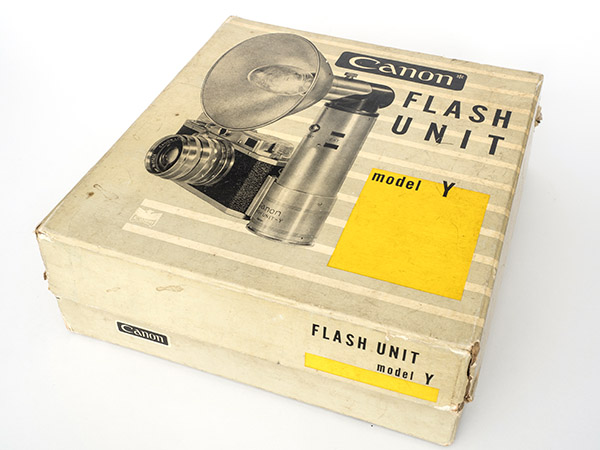
For protection, the presentation box was delivered in a plain cardboard external box, these have rarely survived:
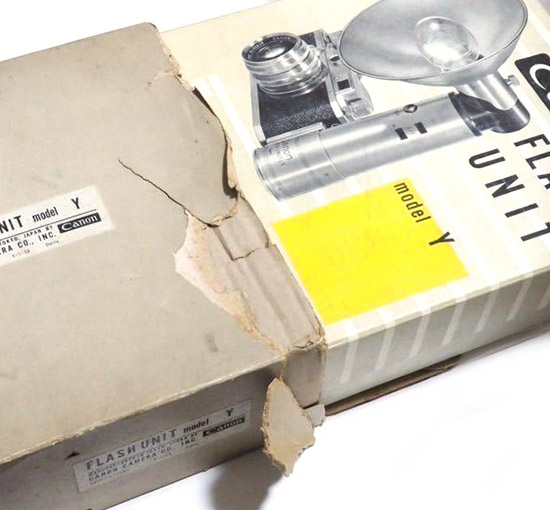 (Web image - dfferent set)
(Web image - dfferent set)
Note supplied soft vinyl cover/diffuser, now somewhat yellowed and brittle (more detail further below). The earliest Y in my database and another early example with the shiny chrome reflector still feature the same type box, but with a red liner instead of yellow, however the September 1952 box mentioned above already features a yellow liner like this one:

In my database, Flash Units Y from serial number 121x (and probably from the beginning) to 570x (and probably a bit higher) feature smooth shiny chrome reflectors whilst those from 953x to 36359 feature a satin textured finish. This was also reflected by the cover photos of the boxes and user manuals:

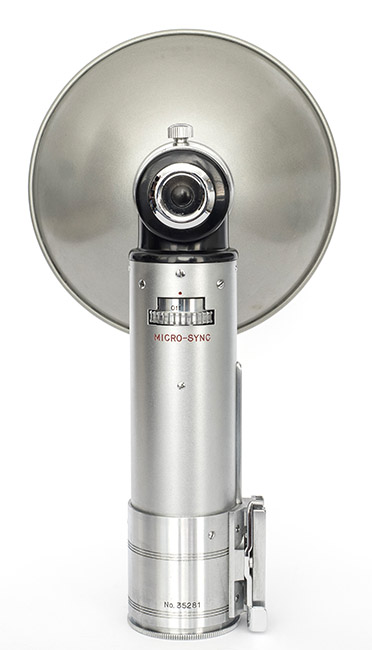
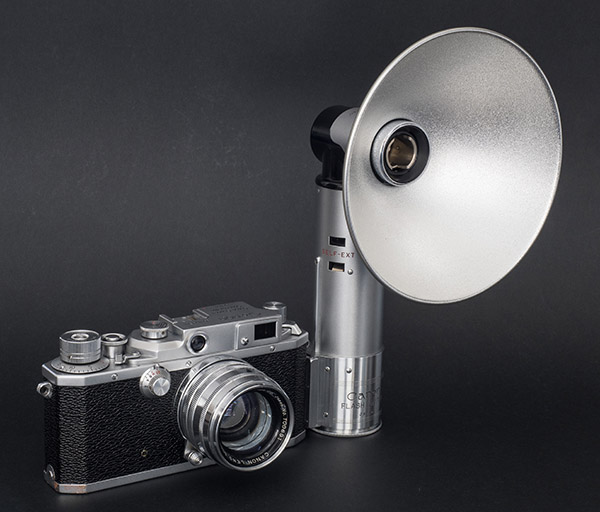
Model YK components, from an otherwise identical late set to the one above, with capacitor and cylinderical battery/capacitor holder. The 22.5 volt laminated battery (not with set) sits beside the capacitor, the circular disc goes between the two and the end cap:
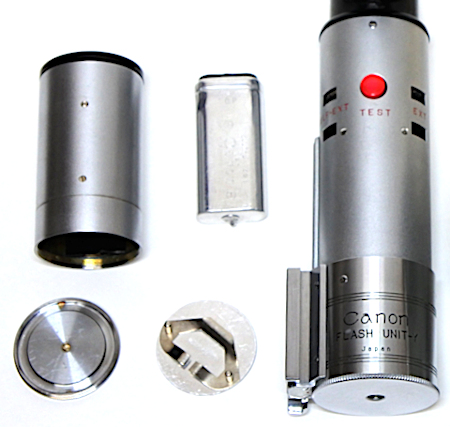 (Web image)
(Web image)
Boxed sets often still include a soft vinyl cover, with elasticised band, over the reflector and sometimes also a draw string bag made of the same material for the flashgun. In many cases, the cover and bag have yellowed, as above. There are two types, a textured one with a fine chequered pattern to the vinyl surface, again as above, rendering it translucent, the other completely smooth and clear. I have seen the reflector cover called both a “diffuser” and “dust cover”, I believe the textured type is a diffuser but whilst both could also serve as a dust cover, their intent is more likely to be a protective cover to contain an exploding flashbulb (I have an original early 1950's MiniCam handle flash with 3 sided sleeve; blue for using clear bulbs with colour film, textured for diffusion and clear for safety use). Clear version of the cover and bag from a boxed set:
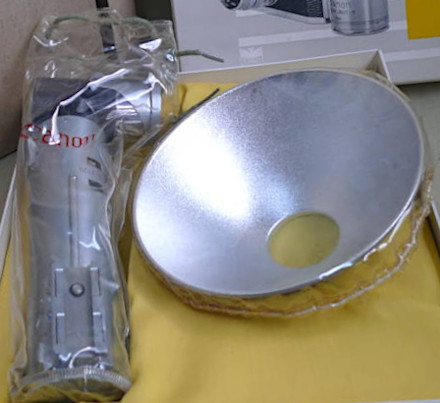
 (Details from larger web images)
(Details from larger web images)
I have found the clear covers on some shiny chrome reflectors and early examples of the satin textured reflectors. The textured covers (the majority) appear on later examples of the satin textured reflectors.
I have seen nothing in the user manual about it, nor in any other Canon documentation, however, a January 1955 Canon flash brochure (and also a Japanese version of the user manual) lists “Shield Set and Shield Holder” with one of the set of four being “clear for protective use” and another, a “diffuser”. The set seems to be a more extensive and substantial version of what was in the box.

There are a number of user manual versions for the the Flash Unit Y. The earliest I have seen is from November 1953 (downloadable from Pacific Rim Camera) and is in English, cover below left (23 pages). The cover on the right belongs to a July 1954 manual, still featuring the shiny reflector, and is in Japanese (15 pages):
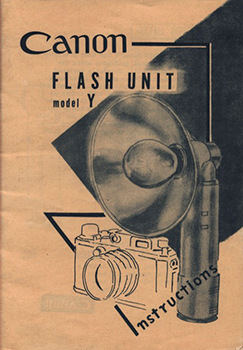

Whilst the paper quality and internal typesetting of the earliest manual is more basic than the rest (more so than the earlier X unit manuals in English), all export manuals seem to share its basic cover design (most have a camera image rather than line drawing) as does the downloadable manual below. This one is quite a late one from October 1955 (contents appear identical to a July 55 printing), matching the accompanying flash unit's late serial number (No. 35281), and featuring separate tables for using Canon IV-Sb, II-S and II-F cameras up to serial number 169999 and over 170000, i.e. IV-Sb type models with 1/25 cross over speed and IV-Sb2 type models with 1/30 cross over speed, noting that the “2” models were not name differentiated back then (31 pages):
 (Click on cover for PDF manual)
(Click on cover for PDF manual)
(Note for MacOS users only: Safari is sometimes displaying only the left half of double page scanned PDFs if the first scan is a single page - common with my cover pages. If it is a problem, suggest using different browser, or Preview, instead.)
For Micro-Sync settings, the November 1953 user manual refers to a separate card included with the flash unit whereas the 1954 Japanese and 1955 manuals include their own tables. Below is Micro-Sync settings card for the IV-S and IV-S2 found with a boxed Model Y and user manual which seems later than the November 1953 example but is most probably earlier than the Japanese one:

The “Side Lighting Unit Model Y” below is very hard to find. Side lights themselves are quite uncommon these days, but also probably because Canon didn't replace the Model X version of the side light until at least 1954. The Model Y user manuals of November 1953 and July 1954 (Japanese), and also February 1954 and July 1954 price lists, still display the X version:
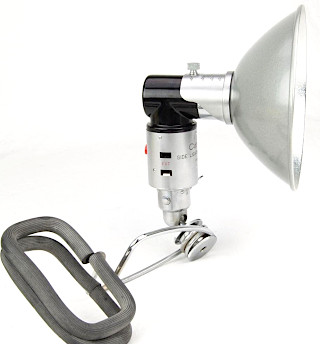 (Web image)
(Web image)
Below is an accessory Canon Flash Unit Y leather carry case, the red and blue arrows pointing to zipper issues. The carry case features softer leather and is quite different to the earlier types and I believe that whilst this was an extra, the earlier flashguns, including earlier versions of the Unit X, included theirs as standard. Half as many Flash Unit Ys in my database have been found with cases than with boxes and together, they account for less than half of all found units:
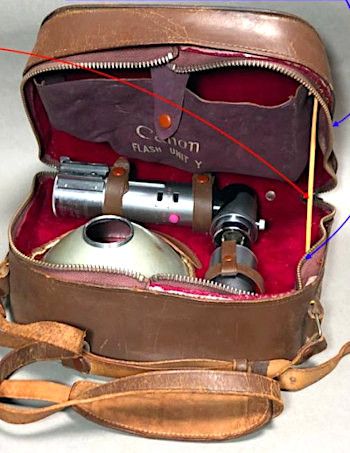
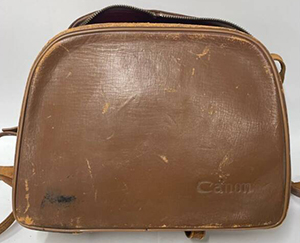
(Web images)
The March 1955 Canon Product Guide has this to say about Flash Unit Y carry case (page 33):
“CARRYING CASE for above Flash Unit Catalog No. M-24208
Genuine cowhide leather carrying case for either Model YK or Model YL. Velvet lining, extra compartments provided for keeping, flash bulbs and other small accessories. All-around zipper closing, adjustable leather carrying strap with shoulder pad.”
There was also a larger “Canon Gadget Bag” designed to hold a Canon body, the Flash Unit Y some lenses and other bits (page 11):
“CANON GADGET BAG Catalog No. M-29901
Genuine cowhide leather case, reinforced with all-round zipper closing, velvet lining, partitioned with tender sheep skin. Holds Canon Camera, Canon Flash Unit Y, Wide Angle Lens (1 pc.), Long or Telephoto Lens (1 pc.), and other small accessories. Adjustable leather carrying strap with shoulder pad.”
Flash Unit III
As strobes were becoming more common for professional use, flashbulb flashguns were becoming simpler, more compact and more accessible. The Flash Unit III was Canon's first modern type with plastic body and fanfold reflector. The power source was a battery and capacitor only (BC type). There is a separate proprietary two pin connector for an extension lead between camera and flash. An extension unit, the Canon Side Lighting Unit, Model III, was also available. The socket on the flash body is a PC type but the instructions warn that only the designated sidelight should be used. However, the later Side-lighting Unit V is also suitable for the model III, see further below.
The user manual (available for download from Pacific Rim Camera) shows the model III mounted to an IV-Sb2 era camera and the printing date is October 1955. It still appears in a 1956 Canon product guide featuring the Canon VT already along with its older sibling, the Flash Unit Y. Its price of $17.50 was slightly less than half of the penlight battery powered model Y, which incidentally was the same as the B-III for unsynced cameras:
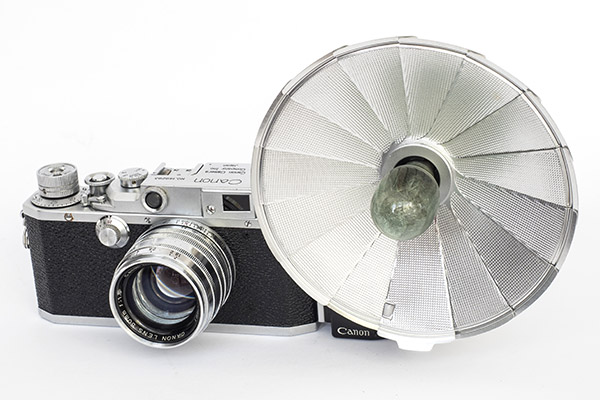
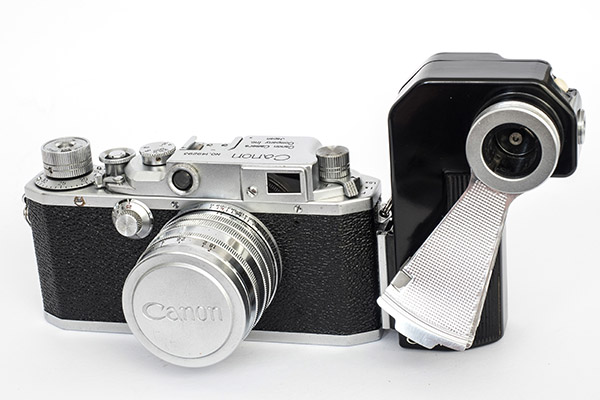
Note the solid construction and coaxial extension socket on the side:


For Canon Bayonet Mount Cameras (hinged back)
The side mounting flash rail was not a practical option for the hinged back models introduced by the Canon VT. The solution was a two tongue bayonet mount on the end of the top plate surrounding a standard PC socket and a matching connector and breech lock on the flash unit. A flash lead could be used for off-camera flash, or using a non-Canon flash.
Flash Unit V
The Flash Unit V was released with the Canon VT in 1956 and remained the standard flashgun until after the Canon 7 was released in 1961. It is a BC type which, with the exception of a tripod socket, has similar features to the model III for bottom loading cameras including a two pin extension lead connector and a PC type socket for the sidelight:
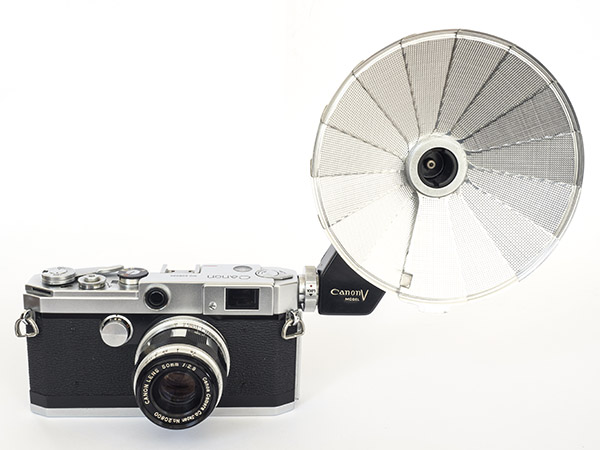
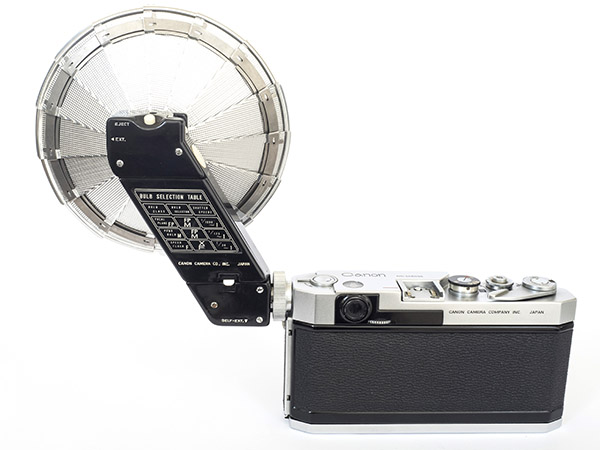

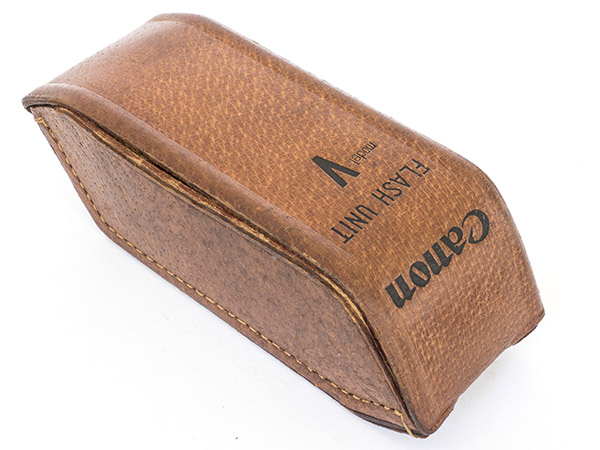
A user manual is available for download from Flynn Marr.
There was a new accessory Canon Side-lighting Unit V. As with the model III, the instructions warn to only use the designated sidelight, i.e. according to Canon, because of circuit design, the sidelights should not be mixed and matched, or substituted by other flashguns. However, the box for the Side-lighting Unit V clearly states that it is suitable for both the model III and V flash units:

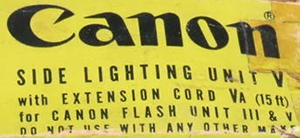
(Web images)
Flash Unit V-2
This unit only appears in later Canon 7 user manuals, although it can be used with any earlier Series V and VI camera. It has a vertical body instead of angled and its primary difference is that the head can be rotated to provide bounce flash. It no longer supports an accessory sidelight but still features a two pin extension lead socket. Mounted on Canon 7:
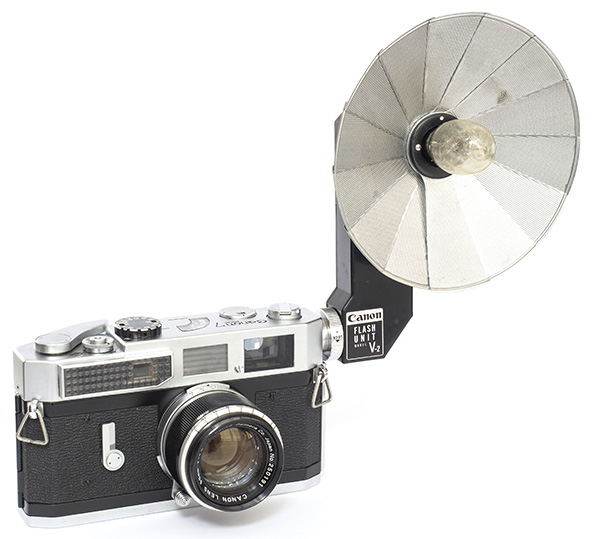
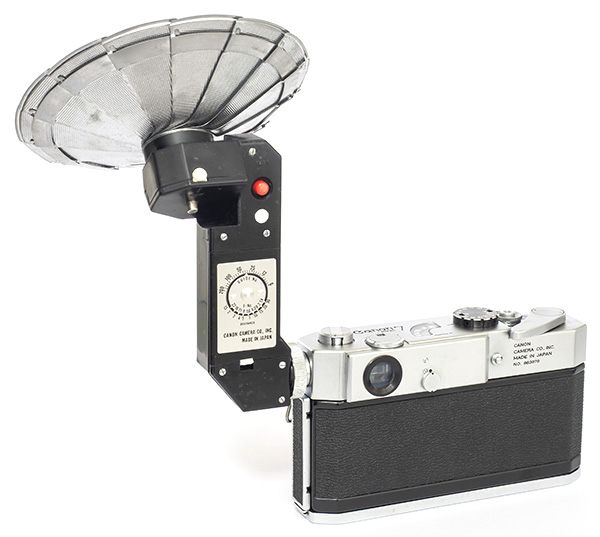
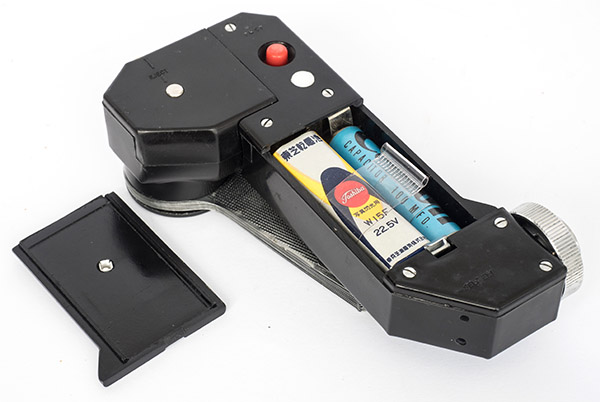
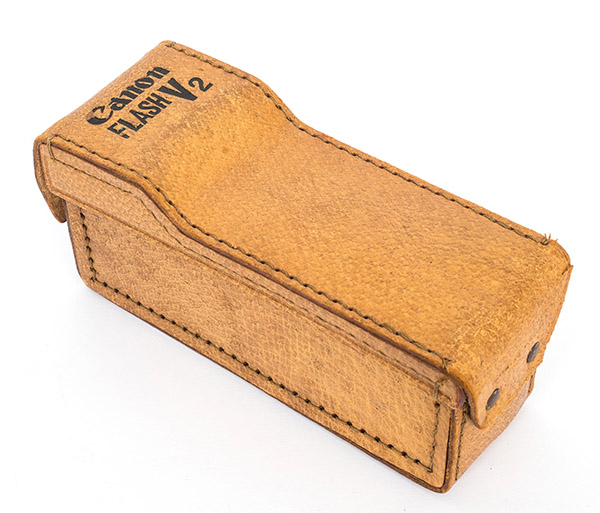
A user manual is available for download from Flynn Marr.
Canon Speedlights for Rail and Bayonet Mount Cameras
Canon initially called “their” early electronic strobe units “Speedlight”, the name “Speedlite” came later. “Speed Light” (two word form) was also a generic term Canon used in, e.g. the circa 1954 Flash Unit Y user manual above when connecting strobes to a camera with sync rail (a US Heiland Strobonar shoulder strap power pack model and an unknown brand pictured).
Canon introduced their own two models with shoulder strap power packs (as the most portable types were in the mid-50s, although under new owner Honeywell, Heiland released the first of the their power pack in handle type, the impressive Futuramic Strobonars in 1958). These were the “Canon Speedlight Unit” and the “Canon Speedlight Unit Model V”, which as far as I can tell were identical except for the flash heads which were designed to be mounted to the rails of Series IV cameras with X sync in the first instance and to the bayonet fitting of Series V cameras in the second instance. In time, this would include Series VI cameras and the Canon 7. The earliest that I have seen them mentioned is in the Canon VT de luxe user manual printed in March 1957. This is the Unit V photo in the manual in operating position:
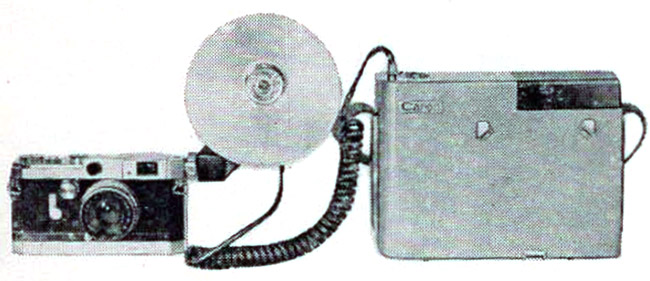
Operating instructions are available for download from Pacific Rim Camera.
Speedlight Unit, upper photo, with rail mount flash head and Speedlight Unit Model V, lower motor, with bayonet mount, both with their flash heads in their stowed postions utilising two upper hooks and a clip at the bottom of the power pack (note the two slots in the reflector rim for the the hooks):
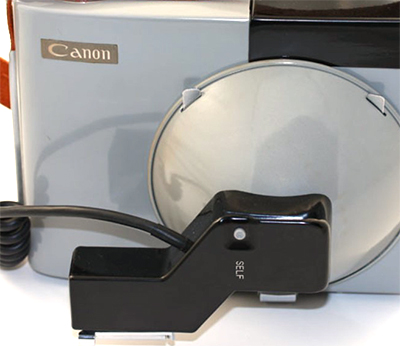
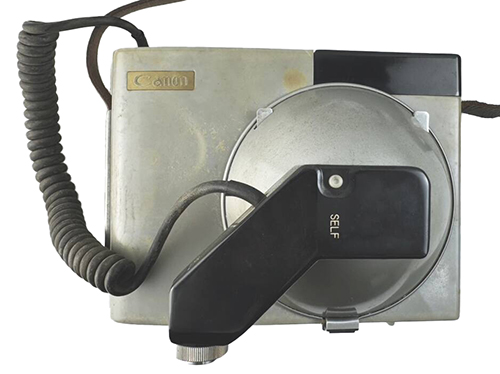 (Web images)
(Web images)
Power pack main switch on left, flash tube on right:

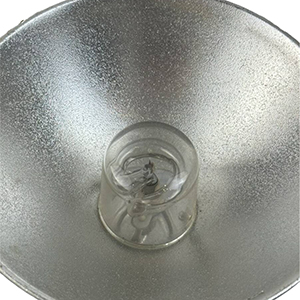
(Web images)
For Canon 7s
The Canon 7s (and the 7sZ) no longer featured the bayonet mount of the Series V, VI and Canon 7 cameras and therefore specialised flash units were not offered for it. The 7s user manual lists three suitable flash units; the Flash V-3 and Speedlite 100 and 200. These are displayed with other items on a Canon brochure page featuring the Canon 7s; left to right; Speedlite 100s, Speedlite 200 and Canon Flash Unit V-3:
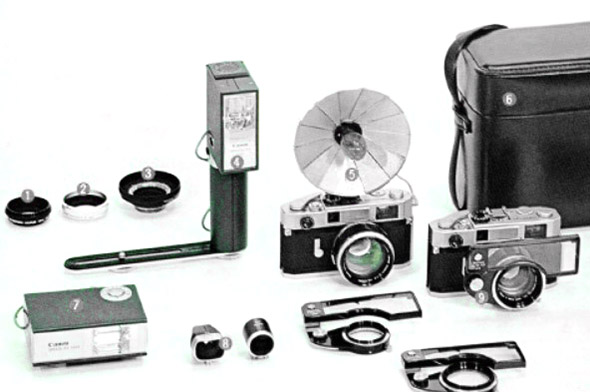
Flash Unit V-3


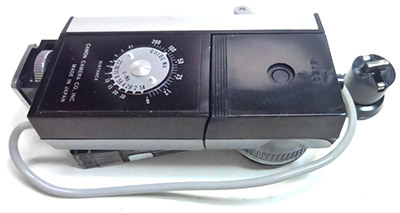
Speedlite 200
 (Web image)
(Web image)
Useful Flash Accessories for the Modern Photographer
More than anything else, two things are likely to frustrate a modern photographer using a Canon rangefinder camera. The first is connecting a modern flash to the side flash rail of the X synced bottom loaders and the second is the lack of an accessory shoe on the Canon 7 making flash use difficult and the use of auxiliary finders next to impossible. Back in the 1950s, Canon had solutions for both and whilst these days they are difficult to find, they do sometimes appear on Japanese auction sites and market places.
The PC flash connector is called the “Flash Terminal Coupler” and slides onto the rail and sits over the sync pressure ball. Unfortunately it's not the most convenient or comfortable looking arrangement with the hard small diameter external socket likely to catch you unawares when there is no cable attached:

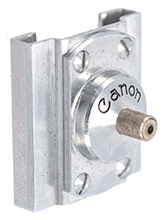
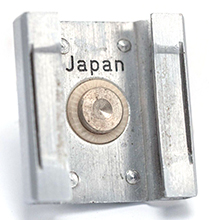
(Web images)
There were actually two solutions for the Canon 7, both are accessory shoes mounted to the flash connector bayonet on the end of the camera's top plate. The first is called the “Canon Flash Unit Coupler” and is a reasonably neat unit which places the flash over the end of the camera. The second is called the “Canon Accessory Coupler” which places the shoe over the middle of the camera and whilst it can be used for flash, or any accessory with shoe mount, it's prime purpose is to enable use of accessory finders. It is not the most attractive contraption and has to be removed for rewinding the film. Canon Flash Unit Coupler on left and Canon Accessory Coupler with viewfinder mounted on camera on right and bare top and underneath views:
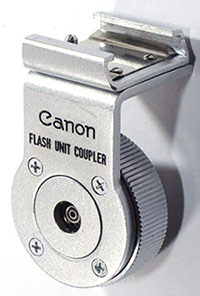

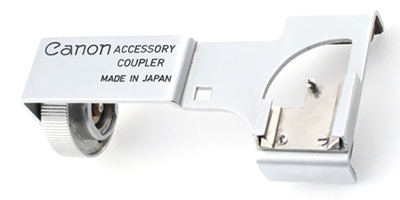
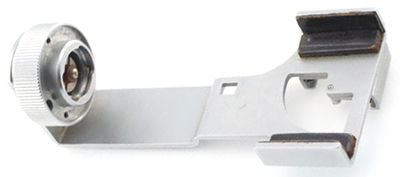
(Detail from larger web images)
Canon Meters
Leica branded selenium cell exposure meters had been around since the 1930s, Leitz calling them “Leicameter” (as many people do) or “Leica Meter” (as Leitz more often did including with a hyphen between the names, sometimes alternating from what was on the meter to what was on the case, instructions or marketing material). They weren't actually made by Leitz, the earlier uncoupled shoe mounted Leica Meter 2 and 3 and the shutter dial coupled Leica Meter M released with the Leica M3 in 1954 and later models, were made by Germany company Metrawatt. As far as I know, Canon made its own meters.
Although physically almost twice the size, being uncoupled, the first Canon exposure meter, Canon Meter A, broadly equates to the Leica Meter 2 and 3 and was designed for the Canon Series V cameras. The name is hardly likely to be coincidence. They are quite hard to find:
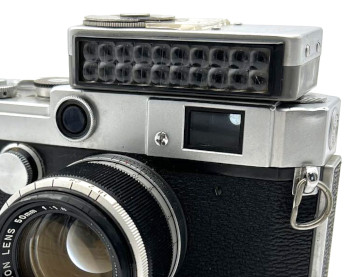
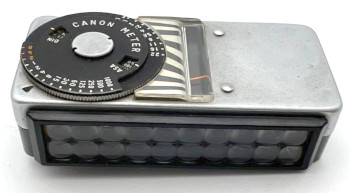
(Web images)
Like the Leica Meter M, the Canon Meter (named that in an early VI T/VI L user manual) and improved Canon Meter 2 (as named in later documents) were shoe mounted shutter dial coupled designs for use with Canon Series VI cameras, the VI-T, VI-L and P, which have non-rotating shutters and the necessary grooves in the shutter dial to allow a mechanical connection with the prongs of the meter. The two meters are essentially the same, except that the Canon Meter 2, which replaced the original, can rotate 90 degrees around its accessory shoe mount to allow rewinding of the camera without removing the meter. As the Canon Meter was released with the VI-T and VI-L in September 1958 (production had commenced in June) and the Canon Meter 2 was already featured in a Canon P brochure printed in January 1959 for its release in March, the original Canon Meter had a relatively short life and is therefore comparatively uncommon. Below is the Canon Meter with its fixed shoe secured by 4 screws. Note, it has three prongs on the shutter dial coupling, there is a slightly later version with four prongs like the Canon Meter 2 (see below). Note also the circular contact pin on the left of the selenium cell for the accessory “Booster” cell connection which could increase low light meter sensitivity by 2 stops (4x). This was omitted from late versions of the Canon Meter 2:
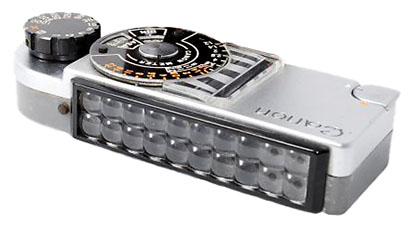
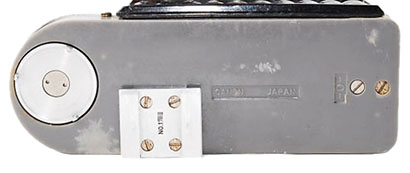
(Web images)
Image adapted from early VI-T/VI-L user manual showing Canon Meter with Incident Light Attachment mounted, Booster and Incident Light Attachment for Booster:

When used with the incident attachments, the user manual assumes that the meter would be removed from the camera but it could be left on if the camera was taken to the subject position and pointed back to where the camera position would be.
Late version Canon Meter 2 mounted on a Canon P. The “Canon” name on top of the body behind the selenium cell disappeared first and towards the end, the contact for the Booster cell was removed:
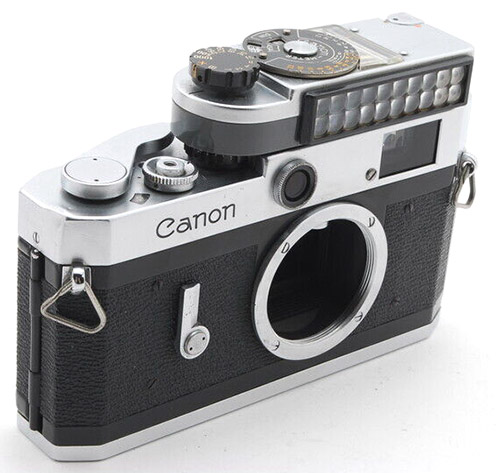 (Web image)
(Web image)
Base of meter showing the rotating shoe, note four prong shutter dial coupling:
 (Web image)
(Web image)
Canon P brochure showing the rotating function of the Canon Meter 2. Switch on lower left corner is for high or low sensitivity:
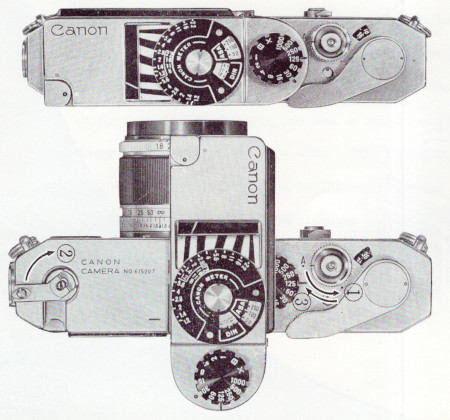
There were a number of minor Canon Meter 2 variations, the last and one of the rarest is that the black aperture value dial on top was engraved rather than screen printed.
Both Canon Meters and Canon Meters 2 were available in black to match black bodies. This one is earlier, it still has the Canon name on the body and the contact for the Booster cell:
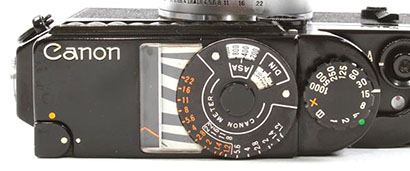 (Web image)
(Web image)
As noted earlier, the Canon Meter and Canon Meter 2 could be fitted with the Incident Light Attachment. This also fits the earlier uncoupled Canon Meter A. A black version was available for black Canon Meters and Canon Meters 2:


(Web images)
Ever-ready Cases
Leather ever-ready cases can be useful things and they certainly add character to a camera and help locate it in the right time period. However, they are not great for camera storage, some people don't like them and the people that do have used them as intended, to protect the camera. Therefore, not that many have survived and nice ones are often difficult to find.
The ones below are broadly in chronological order with a little bit of fiddling when a slight change in order makes sense, mainly in the 1956-1958 period. Cases for models not mentioned may be similar to the preceding type or next type but there is no guarantee of that. There is also a big variance in colour, I suspect because of aging and wear, some because of lighting and reflections and some because they were leather and also changing fashion. Consider the colours indicative but not necessarily accurate.
(All the images below are reduced size from the Internet and mainly from auction sites unless credited, or mine if in a larger size.)
Hansa Canon case on left, one of the earlier versions. Hayato Ueyama pictures several with different strap attachments, opening features, snouts and some with “Canon” name. Canon S case on right with painted name, the couple of others I have seen have been embossed:
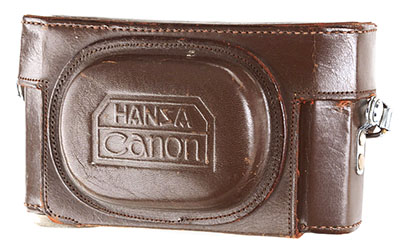

Although not obvious from the photos, both cases above feature similar style metal strap mounts riveted to the case:

Possibly during the War years, the strap mounts changed to a leather strop type riveted to the case, somewhat similar to the later Canon II D case. This one is for a post-War Canon J II:
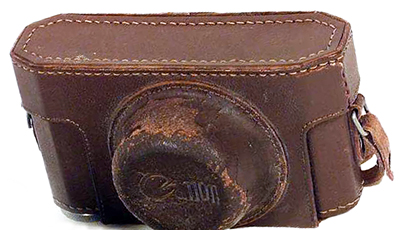
Canon III case below left is the same as the Canon S II and II B cases. Note the neck strap passing through 2 leather saddles each side and underneath the camera and the way the serif on the “a” in the Canon name stretches into the mouth of the “C” (the name on the J II case is the same). The Canon III-A case on the right updates the font used for “Canon” on the case snout and does away with a separate neck strap for the ever ready case, instead providing slight cutaways in the sides of both top and bottom halves allowing use of the camera's own strap. This was no doubt Canon's solution to dealing with the opening case flap for the flash rail on IV and related models:
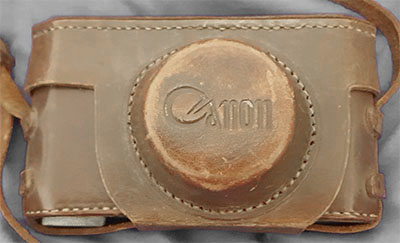
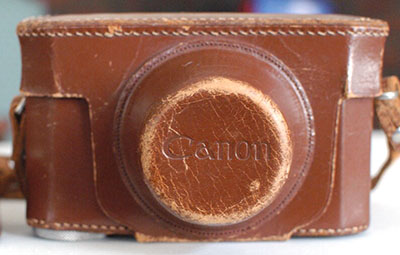
Between the III-A and the IV-Sb cases were ones for the IV, IV-F/IV-S, II-A and II-D - I have only seen cases for the II-D. Whilst both the III-A and IV-Sb did away with a separate strap for the case, uniquely, the II-D used a leather strop and square metal ring strap hanger riveted to the case side:
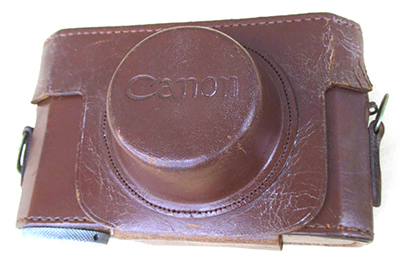
The II-D case was also used for the later II-D2.
My Canon IV-Sb ever-ready case is in a sorry state but it illustrates how the Canon III-A case was modified with a side flap to allow use of the Canon flash units mounted on the camera's rail:

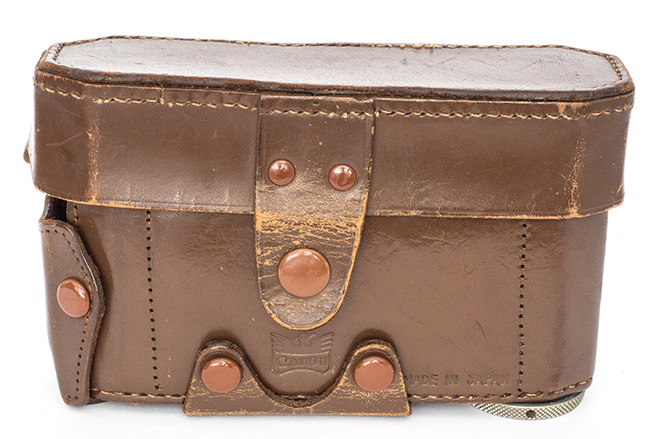
The rectangular “card” is made of some type of reddy brown synthetic material but its purpose is not officially explained anywhere that I have found, even for similar other brand cameras that provide a card. There are some suggestions that it can be used with assisting with film loading (inserting a thin card between the film gate and film is a relatively well known loading technique with bottom loading cameras) and Karen Nakamura surmises that the red colour of the Canon card can also help with testing for shutter capping (white should work at least equally well):
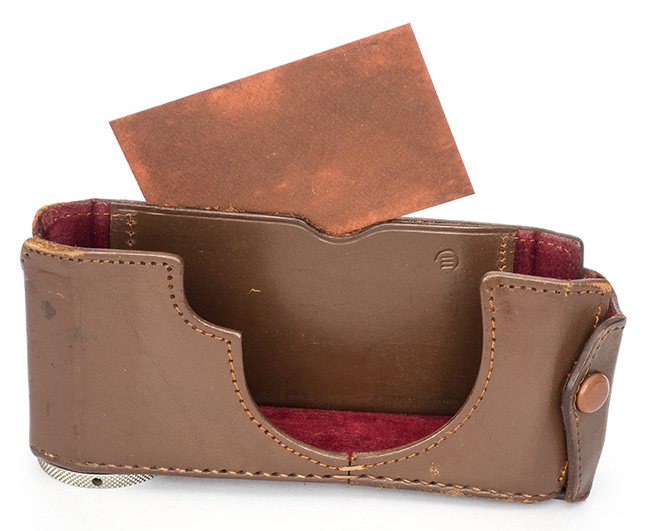

Flap wide open and flash mounted normally:
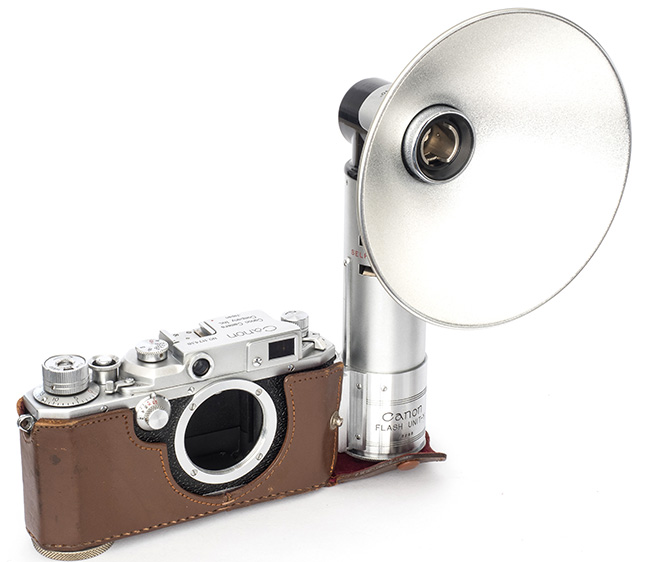
I'm confused by the ever-ready case below. This example belongs to a Canon S-II2 and the back view of the same style case in the two photos below that belongs to a Canon IV-Sb2. However, more than than half of the cases for the models with the updated shutter are the previous type with round snout but it's not like one type is early and the other is late, these cases are distributed at random in amongst the earlier type. Perhaps they were an option, or different markets featured different types, I just don't know:
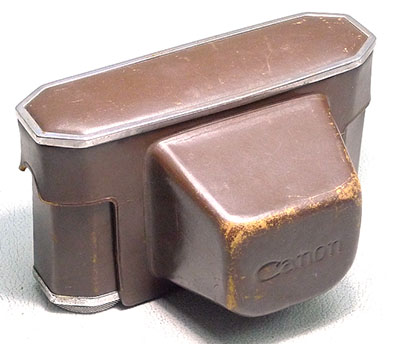
Although the right side is not visible in the above photo, there is no flap visible at all from the front, however, this one features a back opening flap rather than the side type of the earlier case. Like with the previous ever-ready case, the Canon II-D2 received one without a flap but it doesn't have the other II-D case's separate strap hangers:
.jpg)
.jpg)
(Images courtesy of Terry Byford)
The Canon VT was a departure from the past and hence it received a new more modern and streamlined ever-ready case, but which one? I have seen two with VT de luxe style cases and two with VT de luxe Z/M cases but suspect all four are later replacements. I have also seen four Canon VTs with this style case, including the one with highest serial number, the metal trim perhaps linking it to the stylistic thinking behind the case above, found with some updated Series IV cameras. There appears to be a metal hinge between the top piece and the snout:

Note the gold metallic name on the case snout of the then top model and also the return of strap lugs to this and later cases.
The simpler Canon L1/L2 cases set the style for subsequent Series V and VI models, L1 case shown with gold lettering:

The Canon L2 (and L3) ever-ready cases were otherwise the same as the L1 but being more budget models, their names on the snout were embossed instead of metallic. The one VL-2 case I've seen is the same as the L2:
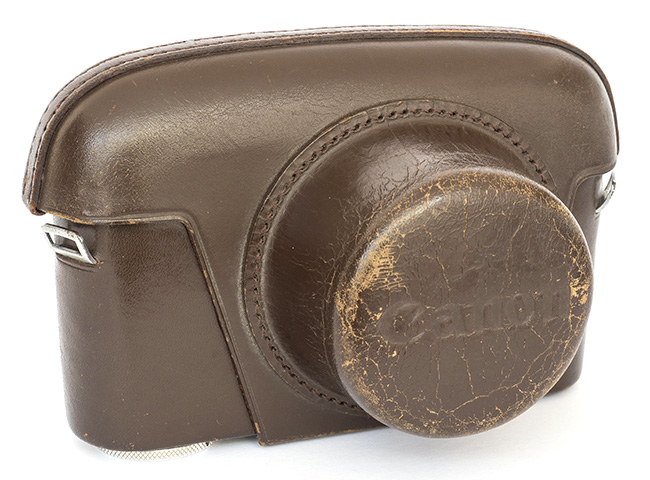
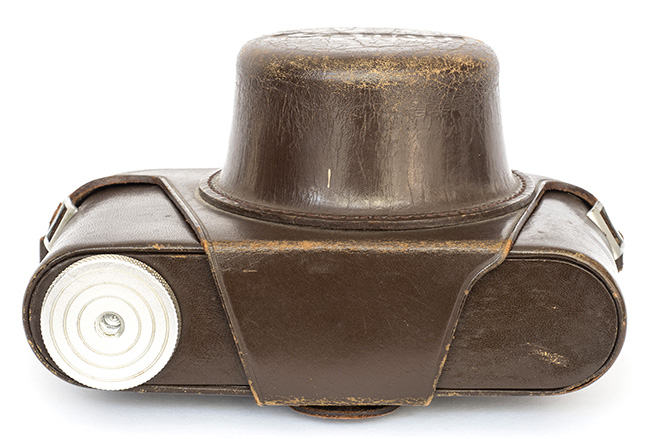

Canon VT de luxe case in the L1 style, the differences being increased height and the slot for the trigger winder:

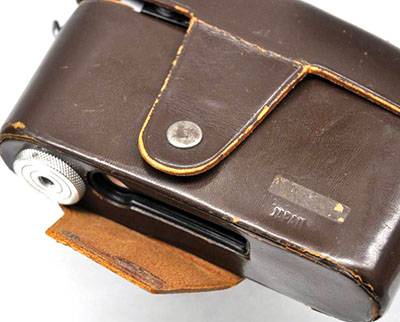
Black Canon VT de luxe case, no doubt for a black camera, and the snout is shorter, probably intended for a retail set with standard 35 mm lens.
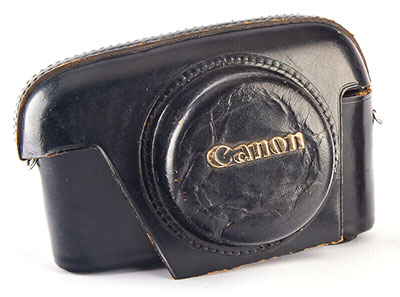
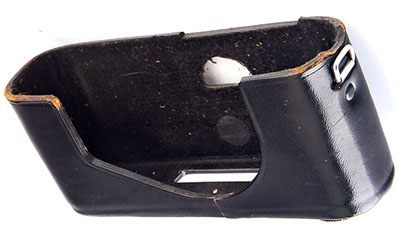
Canon VT de luxe Z and VT de luxe M cases are both the same as the one below which are like the earlier Series V cases except for the large “V” and smaller “Canon” lower down:
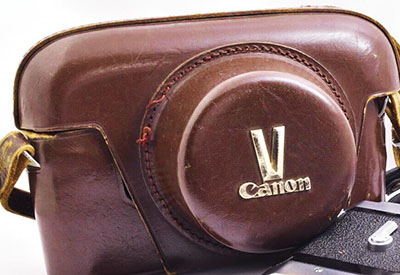
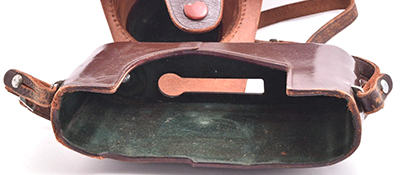
Canon VI-L case below continues the Series V style but with just the metallic Canon name and a bulge for the mounted Canon Meter:
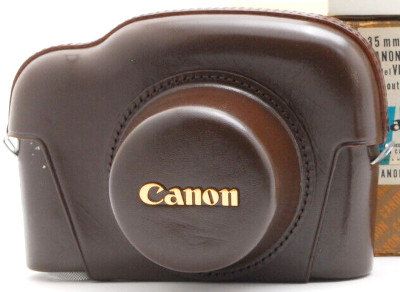
The standard brown Canon P case below is the same as the VI-L case but as with Series V every-ready cases for step-down models, the name is embossed. The black example for a black Canon P features a metallic name as does the other black Canon P in my database with a case - I suspect that because of the small numbers involved, black Canon Ps shared the black VI-L case:

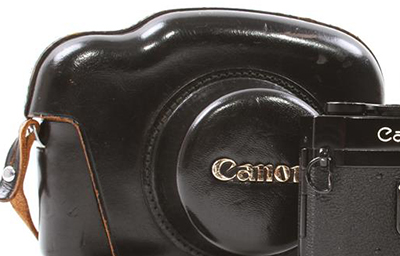
The re-styled Canon 7 ever-ready case is black and more angular with a larger snout but not big enough for the f/0.95 dream lens. Canon, having first eliminated strap lugs with the Canon III-A/IV, reintroduced them with the VT - the Canon 7 and 7s cases have both strap lugs and cutouts for the camera's lugs:
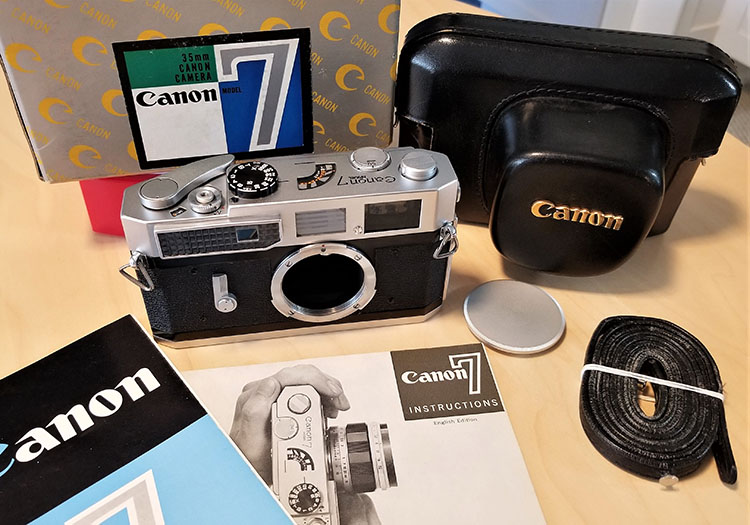
(Image courtesy of Chris Whelan)
Boxed Canon 7 sets with the f/0.95 lens included this version of the ever-ready case instead (the 7s case for the f/0.95 lens is similar and perhaps even the same):

The standard Canon 7s case is similar to the Canon 7 one but more angular still, especially the snout:

Canon Rapid Winder
The “Canon Rapid Winder” is Canon's interpretation of the Leitz Leicavit. The accessory replaces the standard base plate. It was introduced with the Canon III in February 1951, Canon says to fit cameras from serial number 50200 onward (to the end of the bottom loaders) but Peter Dechert says that the model he calls Canon 1950 (trial Canon III/IV series) also has the required modification (serial numbers 50000 to 50199):
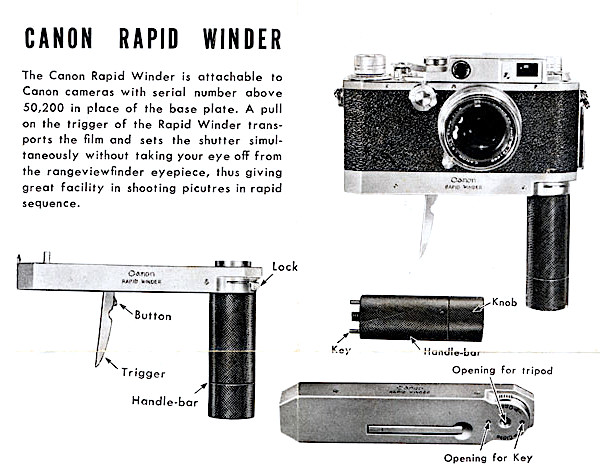
Rapid Winder mounted on IV-Sb2. Use with the included grip, or “Handle-bar”, would be most effective for rapid shooting:
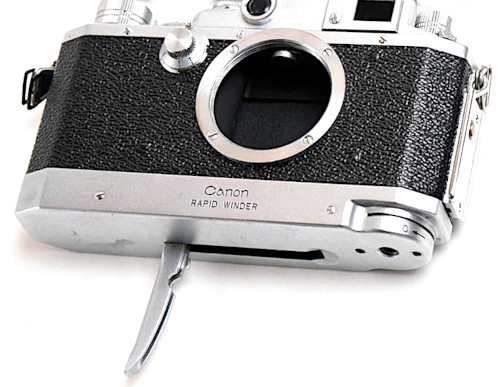 (Web image)
(Web image)
Instructions are downloadable from Flynn Marr. It's a great accessory in some use cases such as sports photography, but a pain in the backside when used for portrait orientation photography, or on a tripod etc. As a removable accessory (tricky with film loaded), it made sense but not so much when Canon decided to permanently build it into some Series V and VI cameras instead.
Accessories Other
Canon offered many, many types of accessories for its cameras and often there are multiple versions or variations to get collectors excited. Finding them is not easy though. This section is a brief overview of some of the basic items not yet mentioned, however, it barely scratches the surface. For more information, check the Facebook page “Canon Historical Society” and the brochures, product guides, price lists and catalogues available for download from Pacific Rim Camera.
Whilst no doubt Canon produced many of its own accessories, like other Japanese camera makers from the period, it is almost certain that Canon also rebranded items and collaborated with specialist accessory makers, especially those items that were largely generic across brands and relatively low cost and volume - there would have been little to gain from setting up design and manufacturing facilities for these items. One such item is the Auto-Up close up attachment and I'm also a little doubtful about at least some of the self-timers, both of which are examined further below.
Seiki Rangefinder
The Seiki rangefinder is one of the first Seiki Kogaku accessories, apart from necessities like the film magazine and lens hood. Hayato Ueyama explains that the rangefinder was advertised from December 1936 to about August 1939. It was produced by Seiki Kogaku with prism provided by Nippon Kogaku. He says that according to the technical staffs' notes, “the Seiki rangefinder is a combination of the Leica standard rangefinder (FOFER) and the stand alone rangefinder released by Kodak”. Why it was developed is not known, the rangefinderless Canon J wasn't released until 1939, although there may have been some earlier prototypes being considered:

(Web image)
Canon Enlarger
At the time of incorporation in August 1937, Seiki Kogaku also advertised its enlarger for the first time. It was mainly assembled from subcontracted parts and featured a Nippon Kogaku made “Hermes” enlarging lens. Many Omiya Photo Supply ads feature “Hansa” enlargers but as far as I am aware, those are different to the Canon. Ad from Hayato Ueyama's book:
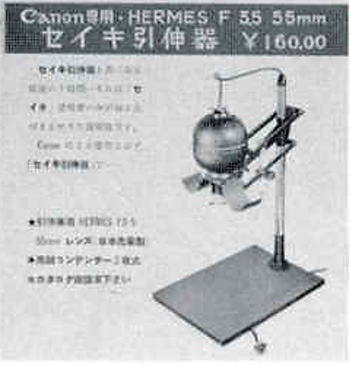
According to Ueyama, it was based on the Leitz Focomat design without the automatic focus adjustment but also suffered from some design issues.
I don't know long it was made for, or whether there were any further models. As noted in Serenar Lenses, Seiki Kogaku did make a small batch of Serenar enlarger lenses in 1945 to replace the Hermes enlarger lens and there was a Canon version released in 1955 but the only mention I can find anywhere of a post-War enlarger is in a 1949 Canon II B brochure which promises that “additional Canon accessories will be made available soon” including, amongst other items, an “Automatic Enlarger for Canon and similar cameras”. There is no evidence that it ever arrived.
Seiki Albada Finder
Hayato Ueyama says that this one is fully outsourced, the ad below actually says that it is made by Nippon Kogaku and features a “transparent gold plated lens”:

Like the black face and white face lenses, it looks just like the contemporary Zeiss item. Released in mid-1938, it is believed to have been made until late 1941, or 1942.
Reloadable Film Magazines
The reloadable 35 mm film cassette, called “magazine” by Canon, was developed for the original Leica, presumably by Oskar Barnack, as 35 mm film was only available in bulk for movie camera use. After Kodak released the disposable film cassette in 1934, the reloadable types remained popular into the 1950s for several reasons. Without a felt light trap, there was less friction to film transport and hence also less chance of scratching the older, softer emulsions. Not least was the economy of buying film in bulk. Once loaded into the camera, the Leitz cassette was opened to allow winding on by turning the the key on the bottom plate which also secured the bottom plate to the body. Unlocking the key to remove the base plate closed the cassette.
The Leica style cassette, also used by a number of Leica copies (most not interchangeable), is typified by a flat spring secured pin-in-groove controlled inner and outer case operation. When Zeiss released its Contax, it developed an improved easier to operate version which did away with the spring and made the Leica style's rectangular hole in the the external casing for the film leader a slot instead. Canon offered two basic types, not interchangeable, over the life of its rangefinders, the first to suit the bottom loaders was based on the Zeiss design, the second was to suit the hinged back models and was a hybrid Leica/Zeiss design with spring operation but retaining the more convenient slot opening in the outer casing.
Author Peter Kitchingman has identified 8 slight variations, some just in markings, with 6 over the life of the bottom loaders and two of the later type for the hinged back models. Examples were presented on the “Canon Historical Society” Facebook page, but unfortunately, the original post is difficult, if not impossible, to find. Collector and researcher Kirk Thorsteinson has made a comparison of Peter Kitchingman's Type 5 and 6 magazines (with both marking and spool differences) and below is my Type 6 (last bottom loader variation):
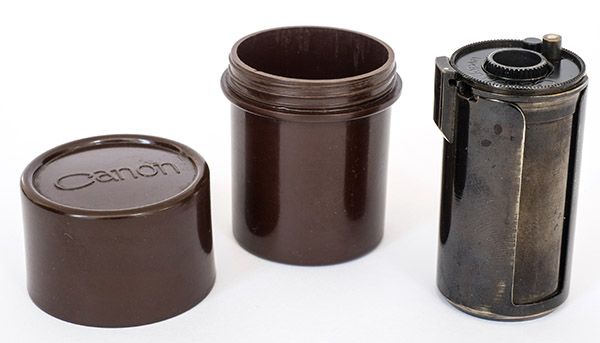
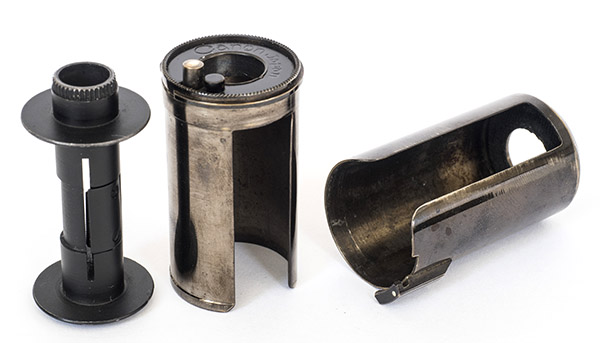
Although the Canon VT and the first version of the VT de luxe with the new hinged back bodies omitted the magazine key, all other Series V, VI and 7 cameras gained it back. However, the required film magazine was the new redesigned hybrid type with Leica style flat spring on the side and single opening pin on top but with Zeiss style open slot in the outer casing. These two probably coincide with Peter Kitchingman's Type 7 and 8:

 (Detail from larger web images)
(Detail from larger web images)
Initially packaged and marketed as the “Film Magazine V”, later packaging dropped the “V”, presumably with regard to Series VI and 7 camera models, although a 1961 products guide still calls it “Film Magazine V”.
Canon Camera Holder
This is a most useful accessory for using with tripods and other mountings such as copy stands (not required, or possible, with the Canon copy set up further below). It holds the camera securely and not only moves the tripod mount to the centre, there is a forward position for heavier lenses, a portrait position and other options and includes a bubble level. It came in several versions, the first for bottom loaders (in March 1951 Canon III brochure already). The second is for Series V and VI hinged back models and is called the “Canon Camera Holder V” in a brochure but this seems to be split into two as well, one unmarked with version name, presumably for lever wind models, the other with higher sides to the base and marked with “VT” for trigger wind models (see images 5 and 6 below). The only problem is that Canon's brochure photo seems to show a Canon VT mounted in the lower profile V version. The final version is the “Canon Camera Holder L” for Series 7 cameras. The three types are all very similar, the main differences are to accommodate the different bodies.
For bottom loading Canons, note the bubble level visible in image 2:
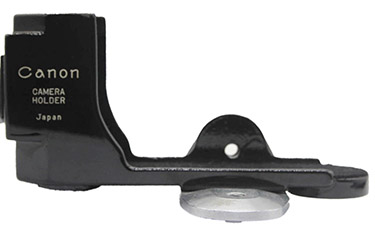
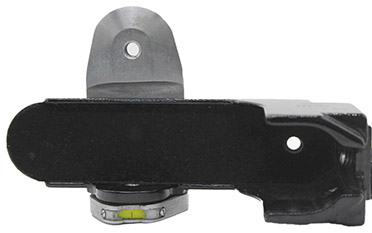

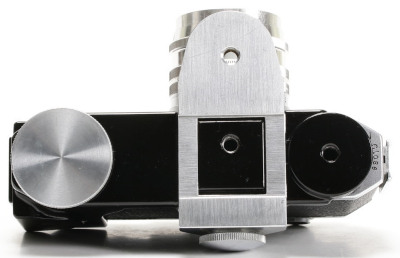 (Web images)
(Web images)
V versions of the Camera Holder from Canon brochures, noting that the trigger wind model seems to be using the wrong holder:
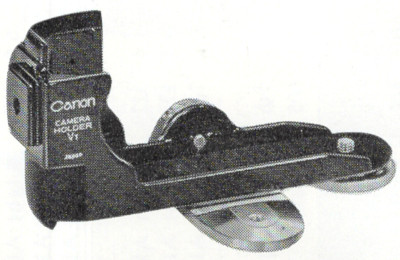
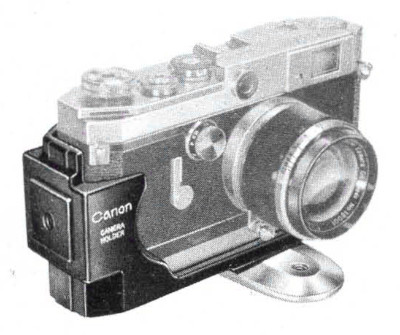
Camera Holder L detail:
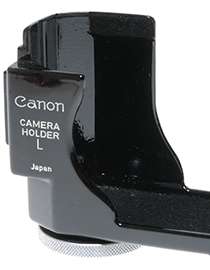
Instructions for the bottom loader model can be downloaded from Flynn Marr.
Auto-Up
The Auto-Up is a close-up lens attachment also incorporating a frame held close-up lens over the rangefinder to enable accurate rangefinder focusing. It was initially made to suit specific 50 mm focal length lenses but seems to work with 35 mm lenses with a suitable bezel diameter as well, note the later 35 mm exception below, and brochures for the Canon 7 450 version which changed from naming lenses to mounting diameters. However over time, it was offered in many versions to suit both lenses and each of the three broad body groups of Canon Rangefinder cameras, Series II/III/IV, Series V/VI and Series 7 to ensure that the rangefinder/viewfinder was properly covered. Then most of these were offered in two shooting lengths named in a 1956 Canon product catalogue as No. 1 from 100 cm to 56 cm, or 40” to 22” and No. 2 from 52 cm to 39 cm, or 20” to 15” (except for the 450 version below, I'm using the product convention of the furthest distance first, some of the catalogues are the reverse, also, some of the metric measurements vary by a cm or so between versions).
My earliest sighting of the Auto-Up in Canon documentation has been in a March 1951 Canon III brochure which only offered it for the Serenar f/1.9 in the 40” to 22” range. This f/1.9 example with the MIOJ marking is probably from a similar time, or earlier. Note the patent number, “174601”, on the bezel side, it is always the same when marked:
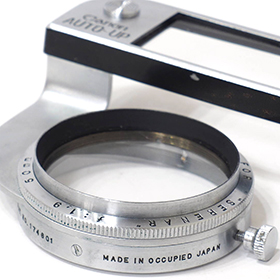 (Web image)
(Web image)
This one is slightly later. The bezel now features a serial number, which a little later moved to the rear of the frame (most metal Canon accessories were serial numbered until later in the 1950s). With these two early types, there were no threads for a screw-in filter but they were added before the V series arrived in 1956:
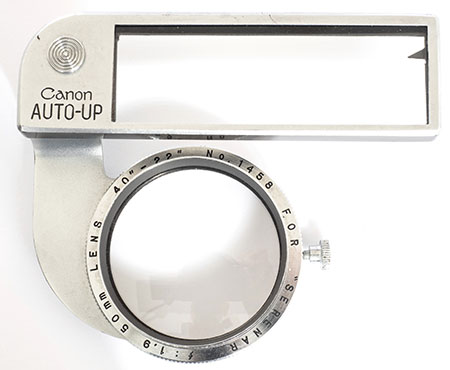
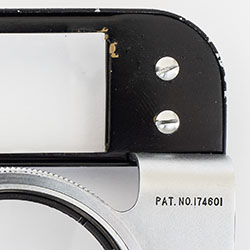
The patent number, “174601”, is now on the back.
Mounted on Serenar 50 mm f/1.9 lens on Canon II B:
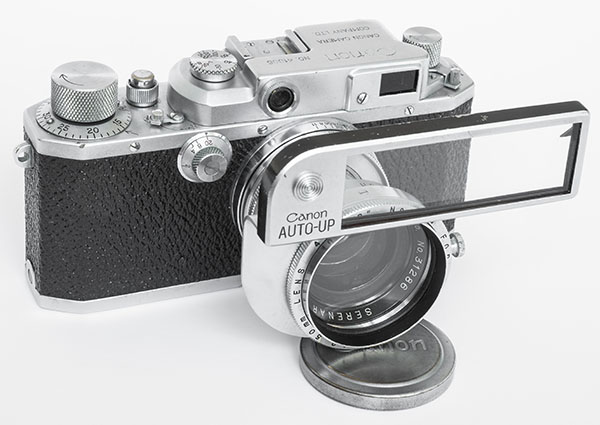
Later brochures offer versions of the first type for the Serenar/Canon f/1.8 (except for the change in lens names and a Canon serial number on the front, these appear identical to the f/1.9 Serenar version and no doubt can be mixed and matched) then add the f/1.5 and finally the f/2.8. It probably wasn't until 1954, or more likely 1955, that the closer 20” to 15” range was also offered. Below is an early example of the No. 2, marked “II” with serial number 10611 for the f/1.5 lens only, which is rather strange for several reasons as an apparently identical II with only slightly earlier serial number, 10150, is marked as suitable for the f/1.5, f/1.8 and f/2.8 50 mm lenses - both the f/1.5 and f/1.8 make sense with their shared 42 mm bezels but at this pre-“V” series time (cameras made before 1956), the 28 mm lens featured a 36 mm bezel and its own Auto-Up (see below). To me, there seems to be some confusion, perhaps because as we will come to, another company was involved:
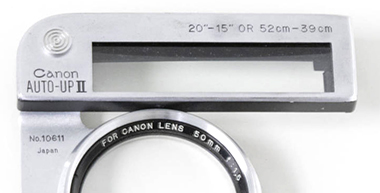 (Web image)
(Web image)
December 1955 instructions for bottom load cameras can be downloaded from both Pacific Rim Camera (higher resolution) and Flynn Marr.
Auto-Up description for bottom loaders in 1956 product catalogue:
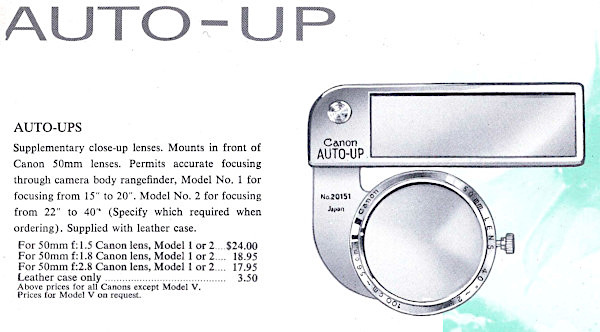
Auto-Ups for Series V cameras are found marked “V-I” or “V-II”. V-I and V-II equate to No. 1 and No. 2 respectively and whilst the cases for both are simply marked “V”, depending on the case, there is usually a smaller “No. 1” or “No. 2” below that. The serial number is now on the back with the patent number. This is a cased V-I version for the Canon 50 mm f/1.8 but note, the instructions add the f/1.5 and 35 mm f/1.8:
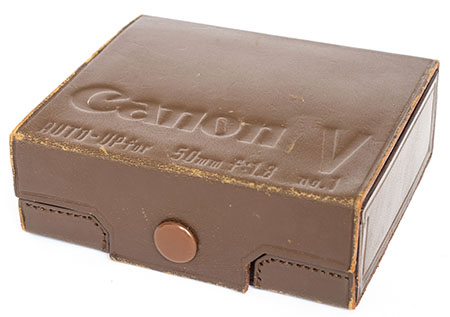
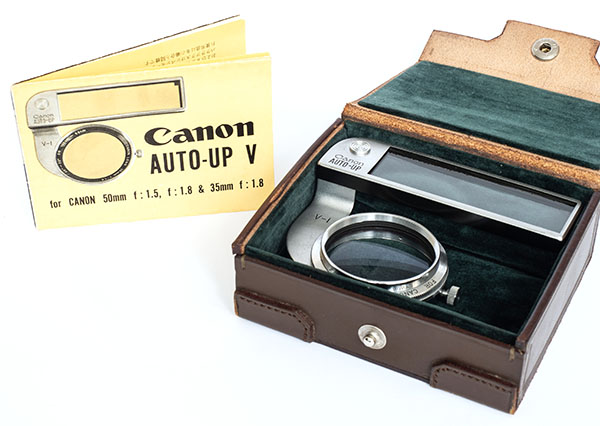
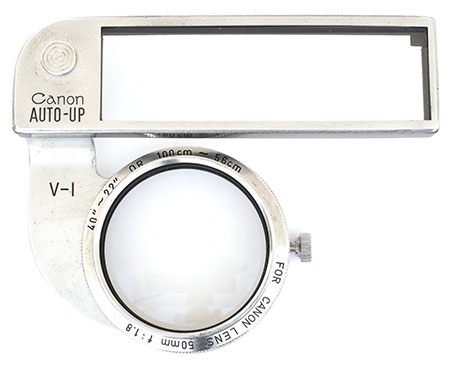
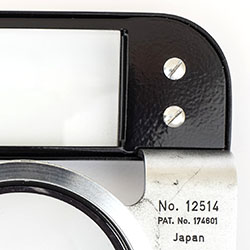
Mounted on Canon 50 mm f/1.8 lens on Canon L2 and fitted with 40 mm screw-in filter:
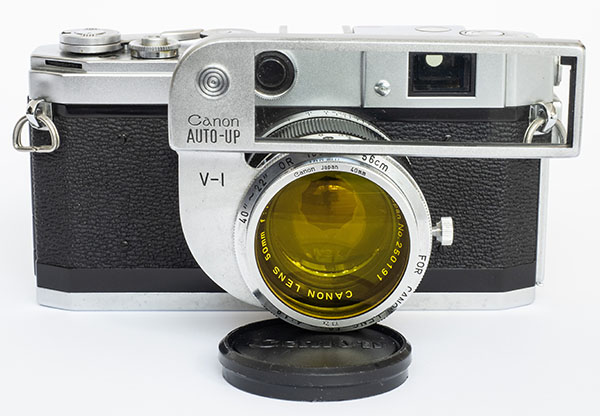
Although this V version looks almost identical to the Serenar model further above, the parallax indicator, whilst a different shape (square vs sharp triangle), is a little closer to the top edge and the rectangular lens for the viewfinder/rangefinder is a little wider.
Below are the V series June 1957 Japanese instructions that came with the set (double sided, multifold sheet):
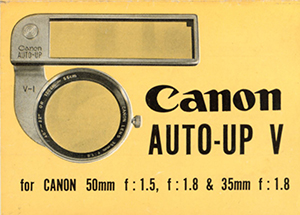 (Click on cover for PDF instructions)
(Click on cover for PDF instructions)
I have seen V series Auto-Ups for the f/2.8, f/1.8, f/1.4 and f/1.2 50 mm lenses. The f/2.8 (see further below) and, I think, the f/1.2 versions are a little different to the others. I have come across a number of Auto-Ups for the f/1.2 lens and they all look the same so I don't think that there is an earlier and later version which will become clear in a minute. The f/1.2 versions have a rangefinder/viewfinder frame/lens which rather than being rectangular, wraps down around the taking lens and has a separate peep hole for the rangefinder. I am assuming that this has to do with the size of the lens. I believe that this one is from the same period as the rectangular f/1.8 and f/1.4 V series, and the patent number, 174601, remains the same:
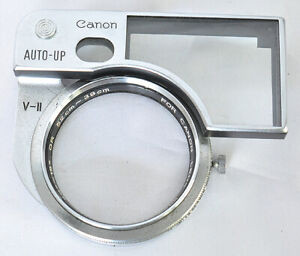 (Web image)
(Web image)
This V-II Auto-Up says that it is suitable for both f/1.8 50 mm and 35 mm lenses, because no doubt of the shared 42 mm bezel diameter, the only mention I have seen of 35 mm focal length lenses on an actual Auto-Up, although this duality also appears on the cover of the V-I instructions with the cased set above. Lens set which says “For Canon Lens 50 mm - 35 mm” and case which suggests the same:
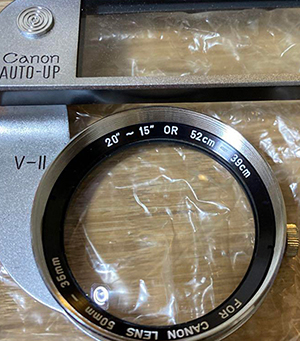
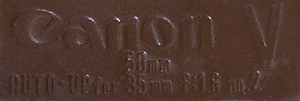
(Web images)
Below is an all black Auto-Up for a Canon f/1.4 lens simply marked No. 2 on the rim. Previously, the f/1.4 version was rectangular, this one wraps around the lens and looks like a black version of the f/1.2 lens type. They are a very similar design but I think it is from later, probably for Series VI cameras with their parallax correcting viewfinders (would still suit the earlier V Series cameras as well):
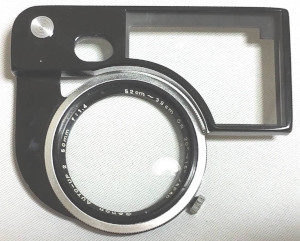 (Web image)
(Web image)
On these and the later Canon 7 type, there is no longer a patent or serial number, or at least any obvious ones.
Auto-Ups for Series 7 cameras are included in a March 1962 Bell and Howell price list. These are now called “Auto-Up 450 No. 1 (for) 55~100 cm” and “Auto-Up 900 No. 2 (for) 39~52 cm”. There are “42 mm”, “50 mm” and “57 mm” named versions for the f/1.8, f/1.4 and f/1.2 lenses respectively. Presumably the 42 mm model will also suit the second type f/2.8 and the f/2.2 lenses and the f/1.8 35 mm lens too.
This is an actual Canon Auto-Up 450 for the Canon 7, but mounted on a Canon VI-T (also mounting the Canon 7 Flash Unit Coupler). Note the wider frame to cover the longer rangefinder base, but whereas I think that it could work equally as well with Series V and VI cameras, obviously no earlier versions would suit the Canon 7:
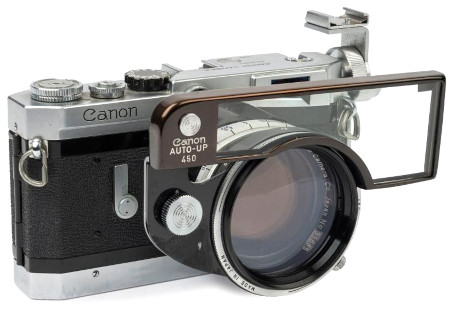 (Web image)
(Web image)
In fact the Japanese instructions I found later with another 450 (900 pictured on the cover) say, “Canon Auto-Up is an accessory that allows you to easily take close-up shots with rangefinder cameras such as the Canon 7S, 7, VT type and P type.”
This is a 900 example demonstrating its secret power of being able to split into two parts. There is no indication that the bezels for different lens diameters could be bought separately to use with the one frame, so maybe it was simply to enable easier storage:
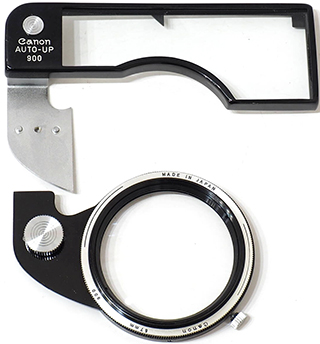 (Web image)
(Web image)
To provide an accurate field of view of the subject, the Auto-Up was recommended to be used with an appropriate 50 mm accessory viewfinder and the “Parallax Compensator” in the 1955 instructions, or the “Parallax Compensator III” in both the 1957 Canon price list and 1962 Bell and Howell price list:
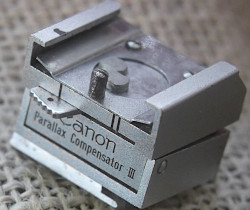 (Web image)
(Web image)
The Auto-Up for the first Canon f2.8 lens with 36 mm bezel mounts differently to those for other Canon lenses. Instead of a close-up lens with attached viewfinder frame, the two parts are separate and the viewfinder frame mounts to the accessory shoe, perhaps because of the increased loading that would be applied to the smaller diameter lens. This one is a V-II version, i.e. Series V camera, 20” to 15”:
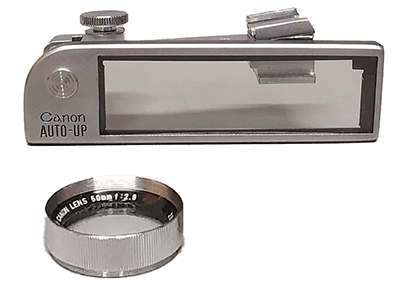
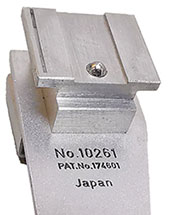
(Web images)
The patent number is still 174601.
Earlier, I identified the Auto-Up as something Canon may not have made itself. Minolta 35 maker, Chiyoda Kōgaku (later Minolta) also offered an Auto-Up which appears in one of its instruction manuals. The example below left mounts the same as the Canon f/2.8 lens version and is perhaps for the Super Rokkor 45 mm f/2.8 which also features a 36 mm bezel. The image on the right is from the accessories page of the Japanese Minolta 35 II type b2 user manual which features a lens mounting more like the other Canon types and one of the larger diameter later lenses:
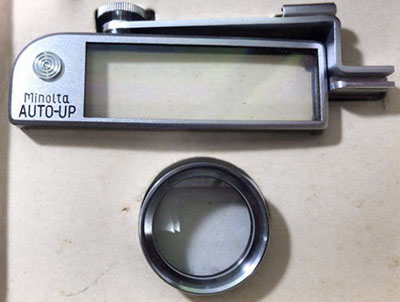
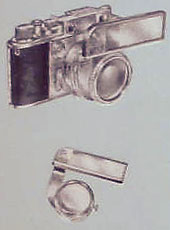
(Web image on left)
But not only Minolta, there are Auto-Ups for Nikon, Konica, Yashica, Kodak Retina IIa, Leica and Contax IIA that I have found plus versions for both Mamiya 35 and Mamiya 6 cameras. Some have leather cases very similar to some Canon examples. For further information, I am referring to Flynn Marr's generally excellent page The Canon Auto-Up which details the back story. An instruction sheet with a generic OEM version made for Leica type cameras tells us that the Auto-Up was invented by Mr K. Shimada, a former technician of Mamiya-Koki Camera Works (Mamiya in other words) and that it was designed by Dr Z. Koana. Mr Shimada was issued patent 174601 and it was manufactured under the Pleasant Brand. The instruction is headed, “Auto-Up Super Nooky” (also appears on OEM boxes), the Super Nooky being a play on Leitz's catalogue name “Nooky” for it's close focusing device for the Elmar f/3.5 (not an auxiliary lens, more like an extension tube with attached viewfinder). Various brands and camera models are mentioned in this early instruction sheet including Canon for the f/1.8 and f/1.5 lenses.
From what I can make out from inscriptions on the devices and packaging and cases, the Auto-Up name is consistent across camera brands, but some camera makers fully incorporated the device into their own identity and branding like Canon, on others, the Pleasant name can still be found somewhere and models made for Leica and Contax and some others were usually inscribed e.g. “for Leica” with the Pleasant name and patent number on the rim, these usually having no connection to the camera maker:
 (Web image)
(Web image)
We know that Canon's Auto-Ups were a Mr Shimada design by the afore mentioned patent number, 174601, that appears on both Pleasant and Canon devices to at least the late 1950s. At this point I have to disagree with Flynn Marr. He assumes that Canon physically manufactured the Canon Auto-Ups and speculates that because Mr Shimada's patent number appears on it, Canon acquired the patent. He claims that this must have happened prior to 1953 (logical if Canon had acquired the patent) and further claims that other versions disappeared from the market around that time. Well, that's definitely not correct. The Minolta 35 II type b2 referred to previously was introduced in 1956. There is also a Yashica version for the Electro 35, a camera released in 1966 (this one has a revised design but looks familiar):
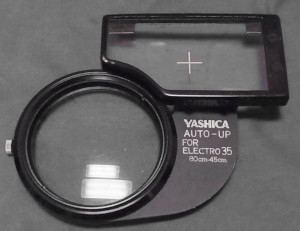 (Web image)
(Web image)
I also have a copy of the Konishiroku issued instructions for the “Konica Auto-Up 3” mounted to the 1973 Konica Auto S3 and Japanese market version Konica C35 FD.
I suspect that quite a number of the others that I have photos of are also later than 1953. Canon may have possibly produced the Auto-Up under licence but given the post-War Japanese camera industry reputation for cooperation and other examples of rebranding of bought in items on this site by Nikon (flash systems), Nicca (flash and most accessories), Yashica (flash, self-timers, tripods, lenses) etc., I doubt that Canon would have wanted to spend resources unnecessarily setting up a production facility for a relatively low value and volume item which a specialised company could do more economically. If it did, surely its Auto-Up would have looked at least a little different to all the others and the name may have changed?
Self-timers
Accessory self-timers are mounted over the camera's shutter button and operate by turning a lever, or dial, clockwise to wind up the clockwork mechanism. When a release lever, or button, is pushed it will unwind and fire the pre-cocked shutter when the indicator reaches its rest position, usually at the bottom (e.g. Canon red flag) but sometimes at the top (e.g. Canon green dial).
My reference for this section is the German Autoknips site Japanese and Canon pages. This is the most authoritative site of its kind but whilst it identifies the makers of some brands of self-timers, it doesn't link them all.
Before the War, the German Haka Autoknips brand was first imported and then produced under licence in Japan. After the War, the two biggest manufacturers of Japanese self-timers were accessory maker Kobayashi Seiki Seisakusho (Kobayashi Precision Works), abbreviated KSS, founded in 1948, using the “Kobal” and “Kopil” brand names (Camera-wiki.org) and Suehiro Photo Industry Corporation which started manufacture of self-timers in 1949. Both made self-timers under their own brand names and also under other names for camera makers and many distributors and importers. With just one Suehiro model, I have found 14 different brand names under which it was sold, including Yashica, plus there are more brands when including minor update variations. Shutter maker Copal is known to have made at least one (its name is on it) and perhaps both of Asahi Optical Co.'s Pentax self-timers from the late 1950s. Few camera companies would have contemplated making their own. The fact is that apart from setting levers/dials and release levers/buttons, there is great similarity in the design of most Japanese self-timers.
Initially, Japanese makers were heavily influenced by the Autoknips designs and the first Kobayashi Kobal self-timer is said to be a copy of the Autoknips IV. This is an early KSS Kobal example marked MIOJ:

 (Web images)
(Web images)
Like most generic Japanese self-timers, the pictured Kobal features a connecting stem with thread requiring a cupped adapter, or “Leica nipple”, for use on Leica style unthreaded shutter buttons:

The Autoknips site tells us, “Canon also built Leica copies and was initially supplied with self-timers by KSS.” But which ones and who made the later ones? The site gives us the order and some clues, but first, to correct some common misinformation about removing the shutter collar.
Mounting the Canon Self-timer (pre-1956 Model Cameras)
This is also mentioned in the Self-timer II instruction sheet. On the Canon B II camera and earlier models with the plain shutter buttons, the shutter collar had to be removed first to be replaced by the Canon Self-timer, or by an adaptor for other self-timers, or cable releases. It would then be easy to lose the collar. The 1940 Leica IIIc introduced a new mushroom style collar with a gap between collar and button which would allow the adaptor to be mounted without unscrewing the collar first. A similar collar arrangement was adopted by the 1951 Canon III and used by Canon for the subsequent bottom loading models, i.e. from the Canon III and II-C onward, the collar no longer had to be removed. Canon's solution used a stepped thread, a larger diameter one at the bottom for the collar and a smaller one above it for the self-timer (or adaptor) cup.
First row, Canon II B with collar and sans collar, second row, Canon IV-Sb with mushroom collar and sans collar, note the stepped thread (images with self-timers mounted further below):
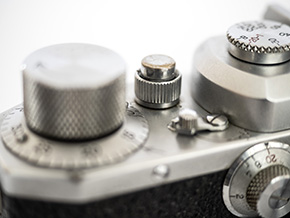
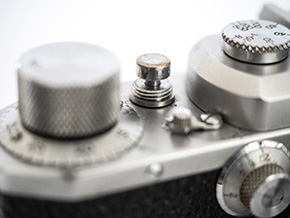

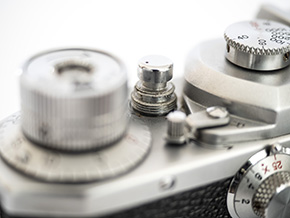
1949, Canon Self-timer
As expected, the first Canon Self-timer model does look like both the Autoknips IV with rectangular body and a setting/winding lever with a red disc indicator flag and also the very similar Kobal further above.
The obvious differences are in the detailing of the direction arrow and the winding lever with red flag which is slightly tapered at the ends on the Canon. Notably, it has a stem suitable only for plain Leica style shutter buttons. From its 1949 release year to the end of 1950, or beginning of 1951, the Canon Self-timer also featured the MIOJ marking:
 (Web image)
(Web image)
Later example without country of origin marking:
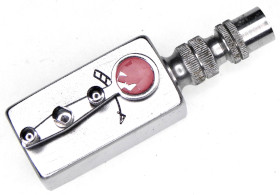
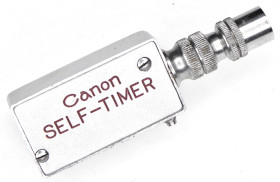 (Web images)
(Web images)
July 1951, Canon Self-timer II
The release date is likely based on the instruction sheet publishing date. Like the original Self-timer in the post-MIOJ period, the earliest Canon Self-timer II examples have no country of origin marked:
 (Web image)
(Web image)
The Canon Self-timer II is one of the most commonly found types. It looks almost the same as the original but there are some minor external variations; the knurling on the cup and stem detail are slightly different and the central nut is now hexagonal instead of two sided:
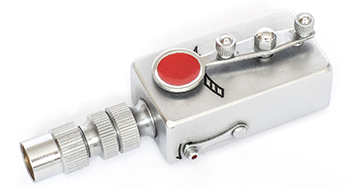
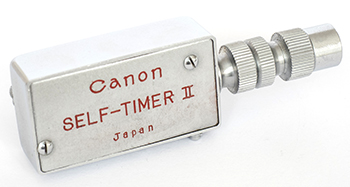
Mounted on Canon II B (shutter collar removed first):
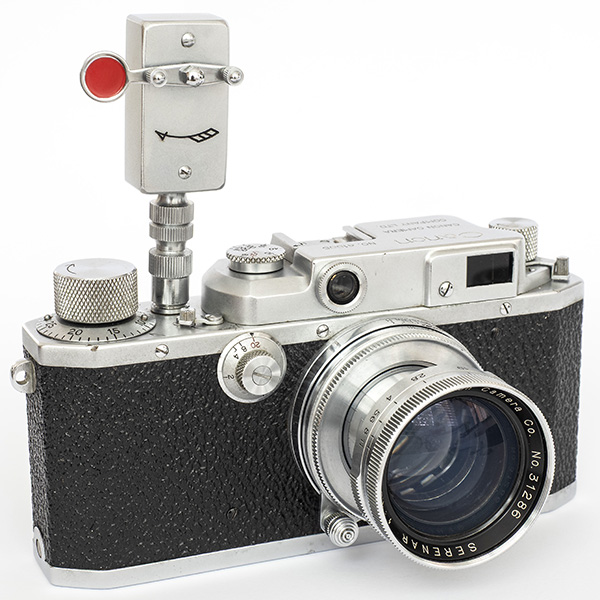
Both the Canon Self-timer and the Canon Self-timer II were supplied in a similar leather pouch:
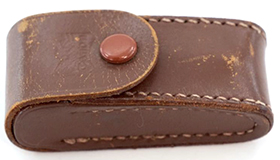 (Web image)
(Web image)
Box for cased Self-Timer II:
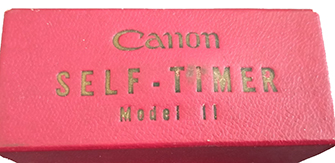 (Web image)
(Web image)
February 1954, A Jardine Alternative
As an aside, a 1 February 1954 Jardine, Matheson & Co., (Japan) Ltd., Canon price list for US Armed Forces includes “Self-Timer (Walz Brand)” rather than the Canon model. It is probably something that the exporter arranged, who knows why? Possibly a supply shortage? Or, was it a business connection? An April 1955 Canon product brochure with Jardine's name at the end mentions “Exposure Meter (Walz)”. There are several Walz self-timers with a similar design to the Kobal/Canon but with key differences. Walz was a seller of many accessories and even TLR cameras but no one seems to know whether it made its own self-timers, or in fact anything it sold.
May 1955, Canon Self-timer III
If Canon produced any of their own self-timers, this and the later threaded release version V of this self-timer would have to be the prime candidates. They have hexagonal bodies to match the Canon hexagonal camera bodies and they are uncompromising in their suitability only for the shutter button types they were designed for. Whilst there are many Japanese brands with similar/same bodies to each other, this is the only one of this style that I know of. Not obvious in photos, it is actually much more petite than its predecessors:
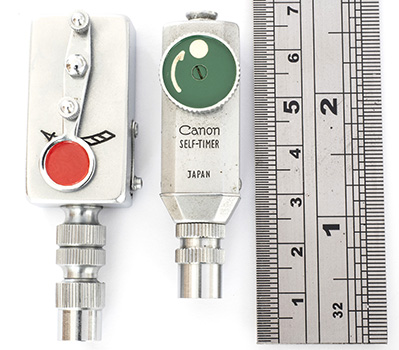
The Self-timer III, and the original Self-timer are the only two I know without a model name on the body (I have not seen the Self-timer IV), or the box (see below). In fact, I have not seen the “III” name used by Canon anywhere that I have looked and indeed, it may not have been called that at all until perhaps later. The II was a revised version of the original, this was a completely new one, no one would be confused. The “V” was probably more about branding associated with the V series cameras than being the 5th self-timer and 6, 7 and 8 followed because you had to call them something. Another little mystery.
On his very nice Canon Self-Timers page, Flynn Marr mounts an argument why he thinks that this one is earlier than the Self-timer II (i.e. that it's the first one, he apparently hadn't seen the original, nor the V). Whilst neither the Autoknips site, nor found models, support that theory, it is also not supported by Canon documentation - a January 1955 brochure shows a Self-timer II still (the III was released in May) whilst a 1956 brochure shows an image of the Self-timer III with the caption, “Screws into shutter release button cup of Canon cameras other than Model V. New easy-to-see green setting dial”. A box for this model is also shown below (4 boxes for this model in my database), on the bottom is the date, May 1955. Note the threaded cup for plain Leica style shutter buttons compared to the Self-timer V cup further below:
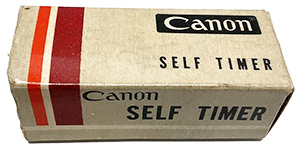
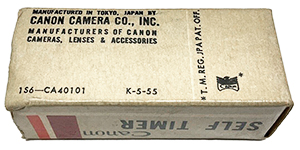 (Web images)
(Web images)
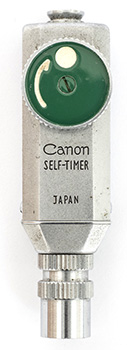
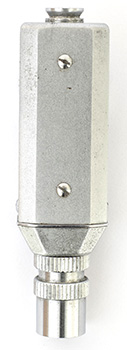
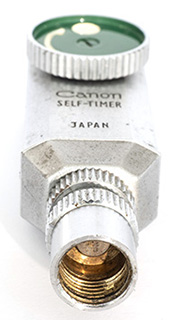
Mounted on Canon IV-Sb (mushroom style shutter collar in place):

The model III was supplied in a clear plastic pouch, the same, or similar to, the Self-timer V pouch below.
Circa March 1957, Canon Self-timer IV
Until the Canon VT was released in August 1956, no Canon models had featured a built-in self-timer and they all featured plain shutter buttons requiring a threaded cup, or “Leica nipple”, to connect a cable release, or self-timer. The VT did away with the need for an accessory self-timer and introduced a tapered thread in the shutter button (Compur thread) for a cable release. However, the Canon L2 was released in March 1957 without a self-timer and apparently Canon hadn't prepared for it in time. According to the Autoknips site, the Canon Self-timer IV is a Self-timer II with Compur threaded connector released as a stop-gap for a very brief period, “a few weeks”, until the Self-timer III could be converted to the Self-timer V. I've not seen one, or any documentation referring to it and don't know wether it is marked “Self-timer II”, “Self-timer IV”, or with no model name. Did Canon even think of this as a separate model? The cynic in me also has to say that this sounds like a convenient way to bridge the gap from model “III” to “V” to match the branding of the new “V” cameras. If it exists, this is almost certainly the rarest of all by a considerable margin.
1957, Canon Self-timer V
As mentioned above, the Canon Self-timer V is the III with a Compur thread connector. In the process, “Japan” moved from the front to back. Note, it still looks like it has a Leica nipple but that is a plain cup that simply sits over the shutter button and the threaded connector is inside that. It is an unusual arrangement not employed on later Canon Self-timers, or any other that I am aware of. Presumably, it provides additional stability but it may have been more to do with preserving the look of the III. It seems simple but may have taken some head scratching to come up with, hence the claimed delay:

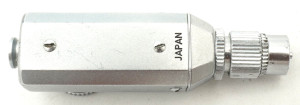
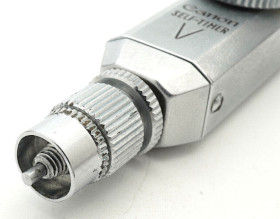 (Web images)
(Web images)
1963-1974, Canon Self-timers 6, 7 and 8.
When the Canon L3 ended production in December 1958, there were no more Canon rangefinder models without a built-in self-timer. Whilst presumably the Canon Self-timers 6, 7 and 8 can be used on Canon L1, L2 and L3 models and in fact, if you wanted to, on any models from the VT onward, or earlier with an adapter, they were not intended for the LTM rangefinder cameras when released. According to the Autoknips site, the 1963 Self-timer 6 was offered as an accessory for the 1963 Canon Demi, Canonex and Dial 35 and the 1968 Canonet 28 and the 1968 Self-timer 7 was a more powerful version of the 6 designed for the Canon TL - it looks similar but the body is slightly wider. However, an August 1968 Canon product guide for the USA features both the 6 and 7 and states that the 7 is “exclusively for the Canonet QL 25”:
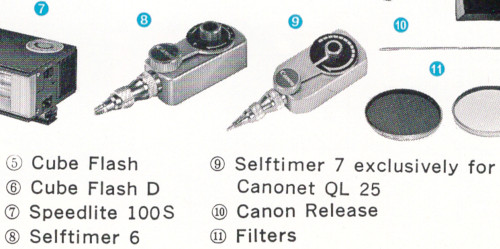
The Self-timer 8 was offered as an accessory for a number of 1974 and 1975 models and was Canon's last mechanical self-timer. The Autoknips site has this to say about the Self-timer 6, “Canon now obtained its new model from a third-party manufacturer ”. As it claimed that the first version/s were supplied by KSS, that seems to imply that the III and V were indeed Canon made. The Self-timers 6, 7 and 8 certainly look more generic than the III and V:
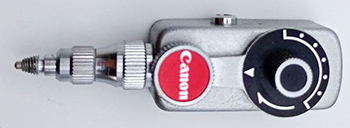
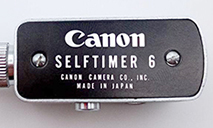
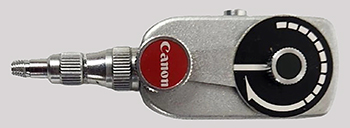
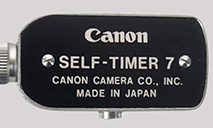

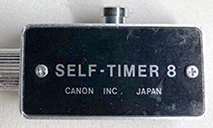 (Web images)
(Web images)
Copy Stands
Canon offered two versions of its copy stands for its rangefinders, a table model with a baseboard and a portable version of the same setup that disassembles into a timber case which, when opened up and turned upside down, becomes the baseboard. In 1953 and 1954 ads and brochures, Canon called its copy stands “Copying Unit, CK-A Portable” and “Copying Unit, CK-C Non-Portable”. The same, or similar, units in a 1956 brochure are called “Copying Unit, Portable Model” and “Copying Unit, Table Model”. Canon Product Guides from at least 1961 onward refer to the Copy Stand 3 for Canon rangefinder cameras and the similar 3R for reflex cameras. Neither English language nor Japanese versions of the guides mention a portable version but I have seen three of the rangefinder type for sale, one further below. The table model of the 3 and 3R could be used with its baseboard, or clamped directly to a table.
Collector Kirk Thorsteinson features his CK-A portable unit on the Canon page of his Flickr site and provides details of camera mounting and focusing mounts along with component lists etc. Low resolution images are below:
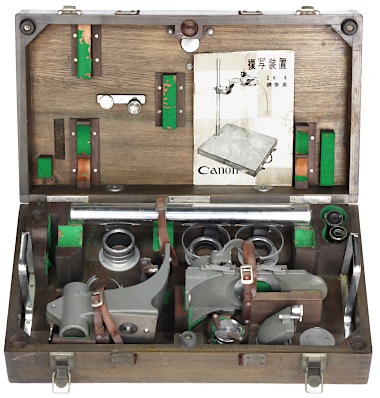
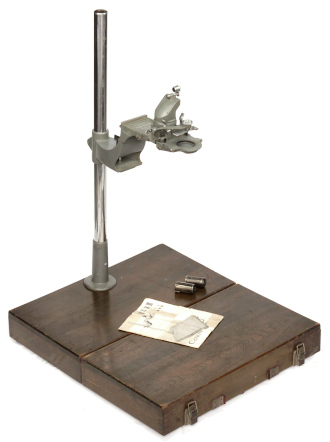
(Images courtesy of Kirk Thorsteinson)
Below left is the example of the table version of the Copy Stand 3 in the July 1964 edition of the Canon Product Guide and on the right is the portable version in its case:


(Left image courtesy of Kirk Thorsteinson, right image from an online auction)
Below are the covers of Japanese (left) and English (right) versions of the instruction manuals for the original copy stand (top row) and Copy Stand 3 (bottom row). Presumably, there were separate Japanese instructions for the CK-C and 3R versions:

Note, the cover of the English CK-A/CK-C manual is cropped in this image. The full manual was posted to the Canon Historical Society Facebook page by Perter Kitchingman.
Camera Boxes
As a collectible, a boxed camera has more value than one without. They are also part of the historical record. The camera boxes are often called a “presentation box” and that is a good description of particularly the earlier ones. Canon's boxes, like contemporary boxes supplied by other camera makers in Japan and elsewhere, were initially substantial and well made and something that could be kept for camera storage. They were heavily influenced by Leitz for 35 mm and Franke & Heidecke (Rolleis) for TLRs. However, by the late 1950s and early 1960s, they had become more disposable like modern packaging.
This box image is from a larger phot in Hayato Ueyama's book. It is the first type and belongs to a Hansa Canon. There is a similar one on display at the JCII Camera Museum in Tokyo which shows the drop down flap to have a red background, presumably the rest of the box is red and white as well. The user manuals have “Hansa” on the cover:

This box belongs to a Canon Original, from almost the end of production. Its user manual is a different design with no “Hansa” marking:

The box below purports to be the earliest box found, being sold at auction with a Hansa Canon with low mount number. It was part of a beautiful set that sold for €36,000 however closer inspection reveals that the film magazine is a later type, the user manual probably belonged to a Canon Original, the body and lens tags probably belonged to a Canon S and a Canon S was almost certainly the first occupant of the box which is identical to the Canon S box in Hayato Ueyama's book. Note also that the lettering on the box is more modern than on the above pair:
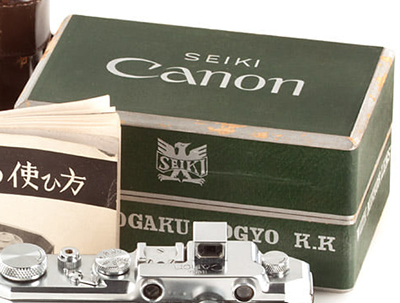
I haven't seen any boxes for the following models which were mainly Wartime production followed by the austere post-War period. However, this type, belonging to a camera with March 1951 inspection tag, takes presentation boxes to a new level. The colour, the finish, the brass clasp and gold writing are very similar to Nicca boxes from this time until a little bit later (circa 1955) - was one company copying, or was there a common supplier? Exterior and interior views:
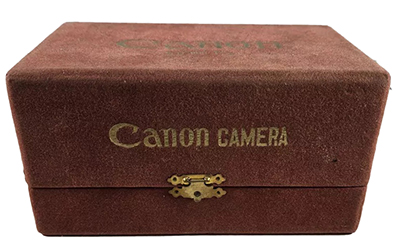
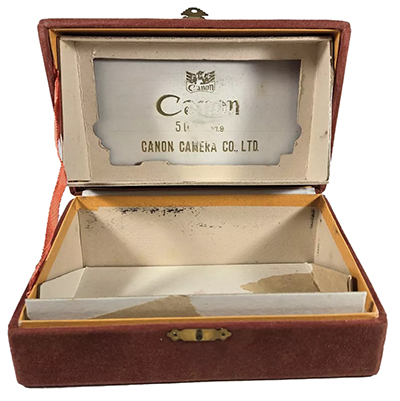
(Web images)
The box was not designed to accommodate the leather ever-ready case and this was probably supplied separately in a more basic box, much like contemporary Nicca packaging and the Canon IV-Sb example further below.
Canon moved on quickly to this simpler, but still substantial, box with more useful information and marketing potential on store shelves. First example is a Canon II-D box and its base which would normally include the kit's serial numbers. Helpfully, the box is marked with a date, September 1952:
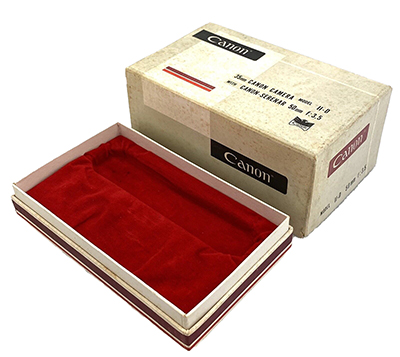
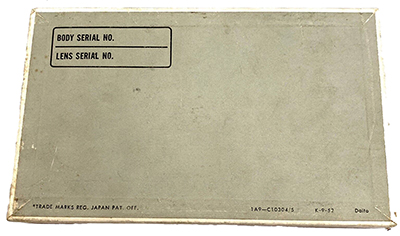
(Web images)
The IV-Sb box is the same design, as it is for the remainder of the bottom loaders. The second image shows the complex packaging involved. The presentation box is given its own protective box, the ever-ready case has a single basic cardboard box and both camera and case boxes slot into what I call a delivery box:
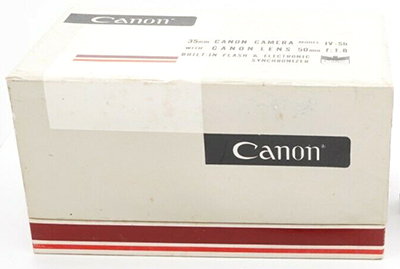

(Web images)
Below left is a Canon L2 box, still with lift-off lid, and on the right, a VL-2 box which looks identical except for a cut-out on the front of the base identifying the model. Presumably, the L and L2 boxes were identical with perhaps the actual model identified on the bottom. The L3 box, being introduced a little later, is like the VL-2 box with the cut-out:


(Web images)
VI-L presentation box with its delivery box, including provision for the ever-ready case:
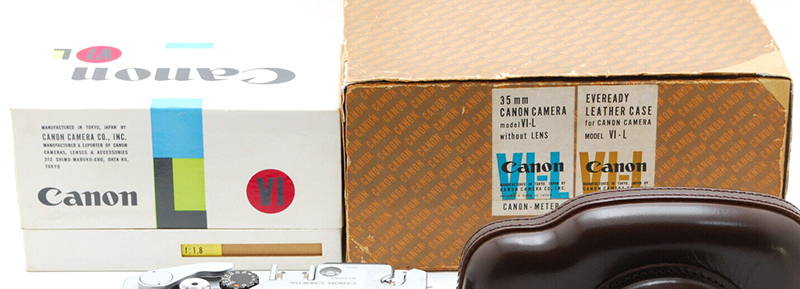 (Web image)
(Web image)
The Canon P box. The separate lid is gone and the box has become more utilitarian and disposable:
 (Web image)
(Web image)
The Canon 7 box pretty much represents modern packaging, only the cardboard may be a little thicker:
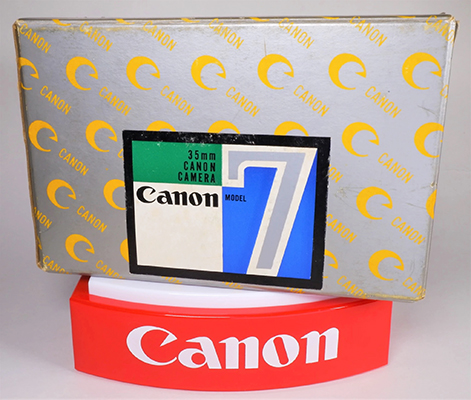
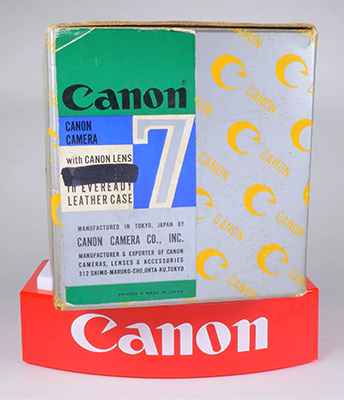
(Images courtesy of Chris Whelan)
With the Canon 7s box, Canon ditched the recent stuck-on labels and went back to a less busy and more eye-pleasing graphic design:
 (Web image)
(Web image)
Lens Boxes
Lens boxes are rarely found, probably because most are fairly basic, but there is one type that is a collectible in its own right; appropriately, for the first Serenars. These match the style of the first post-War camera box above with the brass clasp. I have only seen them for early 85 mm, 10 cm/100 mm and 135 mm but none so far for the first wide angle lenses which arrived in early 1950. This is a page from a late 1940's Canon brochure, or instruction booklet, in English entitled “Telephoto Lenses” (in millimetres already):
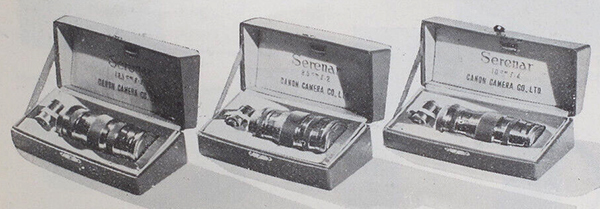
Both a Canon S II (in centimetres still) and II B brochure (in millimetres) state that the lenses are supplied with a viewfinder and leather case included so presumably the leather case would have been packaged in its own box, much like the Canon IV-Sb packaging above. This is a boxed Serenar 85 mm f/2 example:
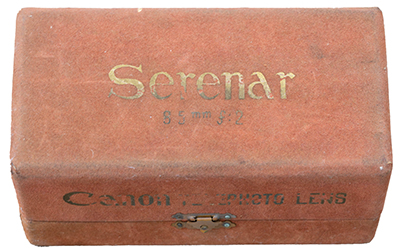
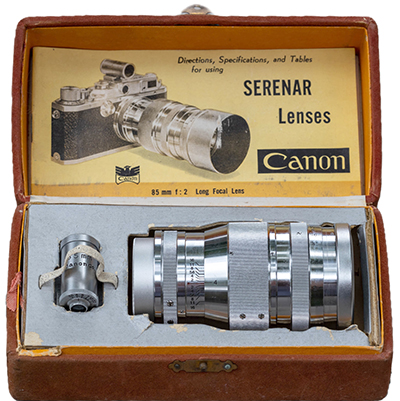
(Web images)
This is the box for a Serenar 100 mm f/4 lens, but it is different to the one above and also the three examples in the booklet which have the viewfinder secured under an elastic strap at the base of the lens, including for the 100 mm lens. The prominent Canon eagle logo without the company name is also unusual. Pacific Rim Camera has a boxed early 10 cm f/4 lens with the box also marked 10 cm, but otherwise identical to the 100 mm booklet version, so I have to assume that this is a slightly later box than all the others and that is borne out by the lens itself which is a late example with a 1952 serial number:
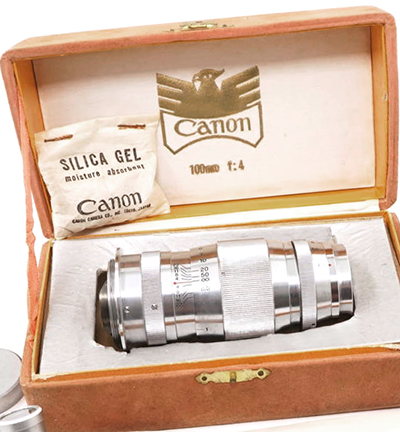
(Web image)
Having mentioned the Pacific Rim Camera box, which is the earliest example, it has a padded satin cloth material covering the cardboard cut-out for the lens, the two pictured above are simply grey cardboard (the second lighter one has a wrinkled surface, not cloth).
Below are a couple of late cylinderical lens “boxes” from the Canon P era, one for the Canon 100 mm f/3.5 lens, the other for the 35 mm f/2.8:
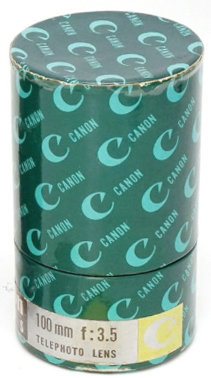
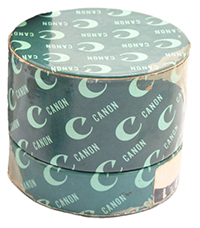 (Web images)
(Web images)
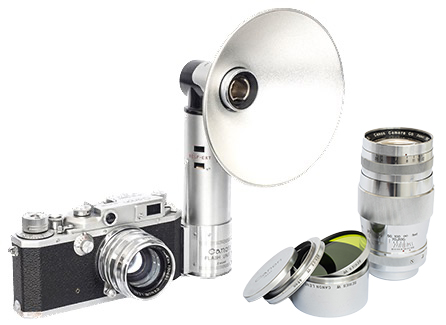
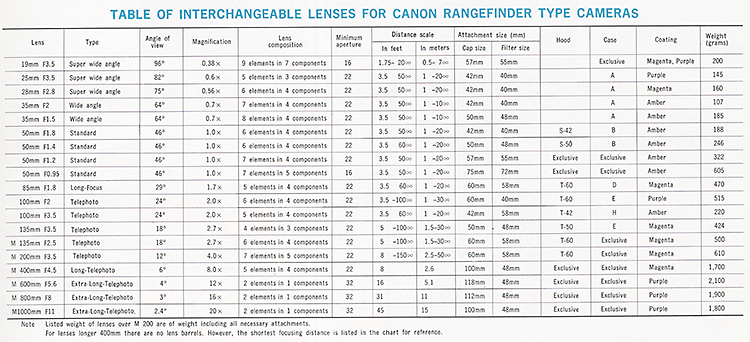
.jpg)